The Buster Keaton Film Festival |
|
In September 1969, the Surf received the BUSTER KEATON retrospective at rallying point Ku Riba, but with extras:
|
|
Never knew about this until a Paul Richards shared this advertisement
with the Buster Keaton Reddit group (Thursday, 30 March 2023):
|
|
Ray then moved the retrospective to NYC on Tuesday, 22 September 1970,
when he began a five-week “Buster Keaton Film Festival” at the
Elgin Theatre.
The prints, I presume, were full-aperture silent, and
a piano player accompanied.
I can only assume (and hope!) that Ray’s people loaned the Elgin the proper gear to show the films.
This was the first time since the original releases that most of these films had been seen in NYC.
While Rohauer was showing his silent print of The General at this NYC festival,
the Jay Ward “sound version” was premièring at cinemas elsewhere.
Hold that thought.
|
|
Just after the “Buster Keaton Film Festival” finished at the Elgin,
Ray was invited to appear on “Camera Three” to spout a bunch of lies:
|
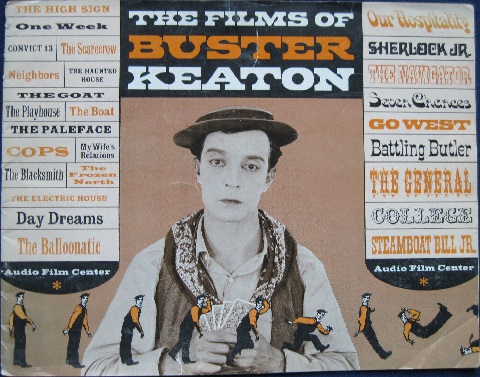 Image stolen from eBay.
Once upon a time, I had Rohauer’s beautiful Keaton catalogue.
I think I found it lying around a theatre where I was employed.
Nobody wanted it, and so the house tech invited me to keep it for myself.
I think that’s what happened.
I hope I still have it in my storage locker. Hope so.
I did not realize at that time, nor did I realize until I was scribbling this essay,
that nearly all those films had been entirely unavailable for more than four decades
at the time the catalogue was issued.
Generations had grown up knowing nothing of this output, and when people saw these Festivals, they were wowed.
Now, at long last, I finally understand the origin of those endless Chaplin-v.-Keaton debates that got people so inflamed.
Buster’s and Charlie’s better movies had been almost entirely unavailable since they were new.
Unexpectedly, in January 1968 in London and in September 1970 in NYC,
people saw Buster’s finest works for the very first time.
Chaplin then began reissuing his movies in December 1971.
For the forty or so years prior to that time,
pretty much all that had been available was just a handful of his earliest primitive shorts,
butchered and battered to unwatchability.
People saw his finest works for the very first time beginning in December 1971 and were wowed.
Belligerents in pubs immediately lined up to take sides and get into brawls.
Humans. I’ve never understood humans.
|
|
So many fibs in the interviews above. So many, many fibs.
Buster had few or no scars. Ray Rohauer did not meet Buster in 1954, but in August or September 1958.
Buster did not have “a garage full of junk.”
He had no copies of any of his films, and so he did not threaten to toss them out.
The prints at the Surf were not “irreplaceable,” since each was derived
either from a new duplicate negative or from a new copy negative.
(Oddly, some of those prints and negatives have since that time gone missing and were replaced by inferior materials.
Why and how remain a mystery to me.
That is why a few brief shots from several films that people saw at the Elgin in 1970 are no longer available anywhere.)
I have my doubts about Ray’s story of finding negatives and possibly other materials at MGM,
and I really have my doubts about finding the “original” negative of The General at MGM.
It’s not out of the realm of possibility.
After all, MGM did once have an option to remake The General but allowed that option to expire.
It is possible that MGM was loaned the negative at that time and then never returned it.
Still, though, I have my serious doubts.
By 1965, Buster was keenly aware that people really did care about his films.
The implication that the Surf already had the proper Silent aperture plates (and therefore lenses and masking) is most heartening.
I wonder if the Surf had speed controls as well.
Jack Tillmany’s Gateway was properly set up for Silent,
but I thought that was the only one in San Francisco that could handle silents in those days.
I’m glad to know I was wrong.
|
|
You noticed above the link to a little thingy called
The Metaphysics of Buster Keaton.
That little program answered a question that had been gnawing away at me for half a century:
Was Rohauer’s touring festival print of The General
|
|
This full “Buster Keaton Festival” package went back to the
Surf in San Francisco to run through snow with Kasumi in
December 1970,
again probably full-aperture silent
and probably with piano accompaniment.
The package returned to the Elgin in
March 1971.
Part of this package went to Sir George Williams University in Montréal in the
spring of 1971
and the full package was shown there in September of that year.
The package went to Los Feliz in Los Ángeles in
May 1971. In
July 1971, the package went to the Saratoga Performing Arts Center in Saratoga Springs, NY.
Then to the TLA Cinema in Philadelphia, PA, in
September 1971,
back to NYC at the
Olympia beginning on
23 December 1971,
then the Verdi in Montréal in
January 1972,
then the Hull Film Theatre in Kingston-upon-Hull from
March through May 1972,
then the Manchester Film Theatre in
October 1972,
then the Arts Lab Cinema Club in Birmingham in
April 1973,
then as part of the Atlanta Film Festival in
September 1974,
much later to the
Orson Welles Cinema in Cambridge, Massachusetts, from
28 September through 1 November 1977,
then a bunch (probably release prints rather than festival prints) popped up at the
Vagabond in Los Ángeles in
July 1979,
and then oh heck I lose track.
|
Killiam Shows
|
|
By 1969, Rohauer was doing well by exhibiting his Buster collection.
So, Killiam decided to compete.
Besides, he had surely heard that Jay Ward had a reissue in the works,
and he did not want it to take over his market.
He reached into the cans of trims and attempted to reconstitute The General, but there was a problem:
He could not remember how the original was pieced together.
So, he guessed, and his almost every guess was wrong.
|
|
No. No. No. No. No no no no no no no no no.
That’s not what happened.
Shall I try again?
|
|
By 1969, Rohauer was doing well by exhibiting his Buster collection.
So, Killiam decided to compete.
Besides, he had surely heard that Jay Ward had a reissue in the works,
and he did not want it to take over his market.
He ordered a staffer to reach into the cans of trims and attempt to reconstitute The General, but there was a problem:
The staffer had no idea at all how the original was pieced together.
He had never seen the film in any version,
and this mess was a massive jigsaw puzzle that he needed
to piece together in the dark — while blindfolded.
So, the staffer guessed, and his almost every guess was wrong.
|
|
That second attempt sounds much more realistic, doesn’t it?
|
|
The staffer did the best he could and finally submitted his faulty work,
even though he knew that there were sequences he had never spliced back in.
He showed his work to Paul, who saw nothing wrong with it and released it.
|
|
If that’s not exactly what happened, it’s almost exactly what happened.
|
|
Almost nobody ever noticed.
Except for me.
When I look at the Killiam edition of the film,
I see nothing but disaster after disaster after disaster,
with more shots and sequences out of order than I could possibly count,
and with the narrative shot to senselessness thereby, made worse by the omissions.
|
|
The staffer mostly got the scenes in order, but the shots within the scenes were scrambled.
He cut shots in two and placed them in the wrong contexts.
Many shots had been trimmed by only a second or two for the abridgments,
and it just wasn’t worth the bother to patch those back together again.
The result is that many shots are noticeably shorter than they are in the authentic edition.
As for the first shot of Johnnie sitting on the connecting rod (the first shot of Reel 2),
it looked like duplicated action and so the staffer left it out.
Annabelle boarding the train? All the shots were out of order and one of them was split in two.
The second shot of the fireman, the conductor, the station master, and the baggage handler
watching Johnnie running off after his train?
Gone.
As for the reverse shot of Johnnie pumping the handcar, again,
the staffer didn’t see where it belonged and so he left it out.
A cutaway to the Raiders? He didn’t know that it began Reel 3, and so he stuck it in the midst of Reel 2.
Johnnie breaking his axe handle while he chops wood?
Gone.
Johnnie clubbing the sentry posted outside the door? Gone.
Johnnie and Annabelle waking up in the woods? Nearly all the shots were out of sequence.
Startlingly, he had Johnnie rescue Annabelle from the boxcar BEFORE he had Johnnie break the telegraph wires,
and that made utter nonsense of the continuity.
The staffer must have spent weeks trying to work out what belonged where.
He could have cut the work down to a single day or less by the simplest expedient of borrowing a 16mm print.
He probably did not know that there were any other available prints.
|
|
The one bit of damage in the original was the 22-frame gap in Reel 5.
What to do about that?
Paul was happy to have damage in his copy of the movie.
Happy? Nay, eager!
But the damage in the Killiam edition had to be DIFFERENT from the damage in any other copy anywhere else in the world.
What to do?
Ah!
A cinch!
Just delete the beginning of the shot and pick it up at the end of the gap!
So easy. So delightfully easy. And it works so well.
Nobody, but nobody would ever notice.
Until I came along.
|
|
In the process of making all the other alterations, Killiam Shows also reshot some titles.
Not all, just some.
The font was almost the same, but there was no
|
| AUTHENTIC | KILLIAM |
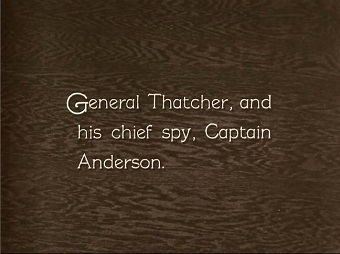 |
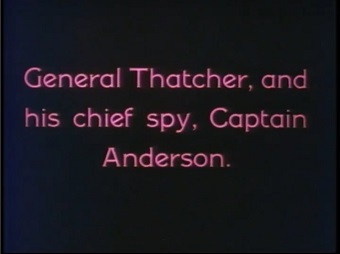 |
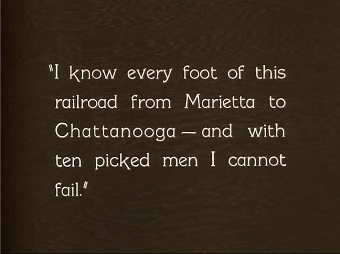 |
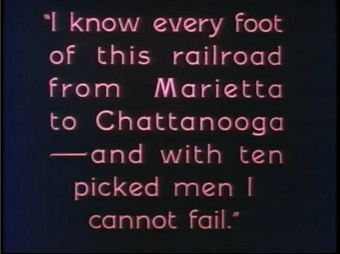 |
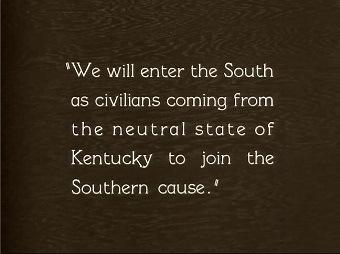 |
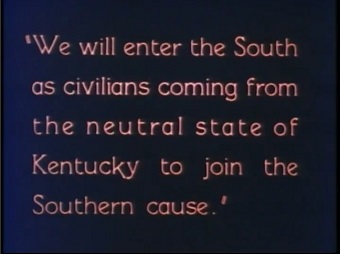 |
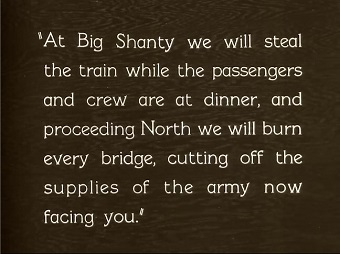 |
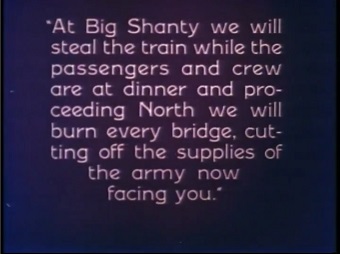 |
| AUTHENTIC | KILLIAM |
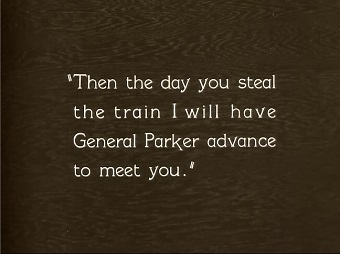 |
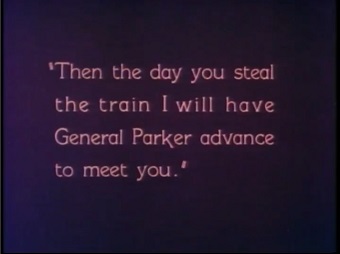 |
 |
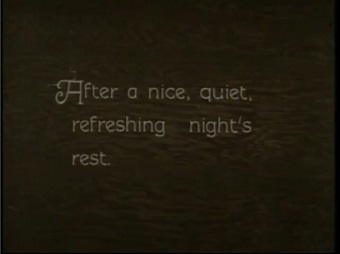 |
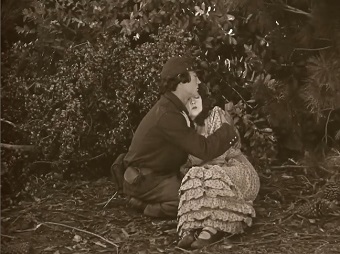 |
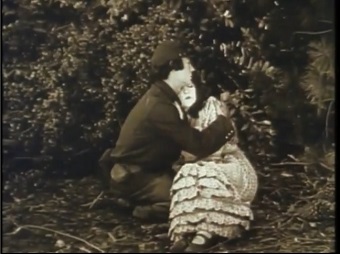 |
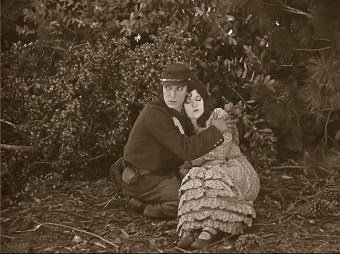 |
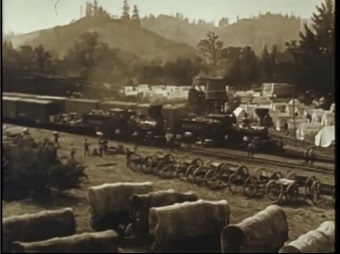 |
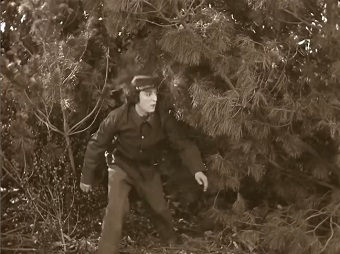 |
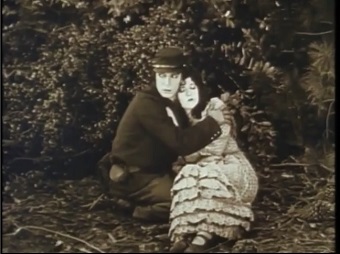 |
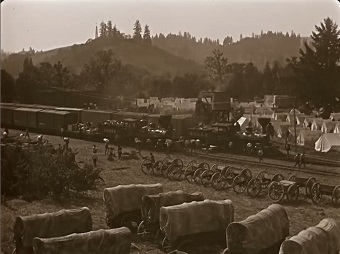 |
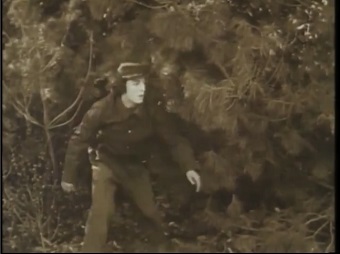 |
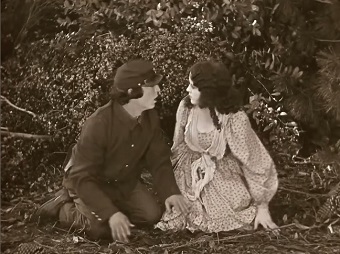 |
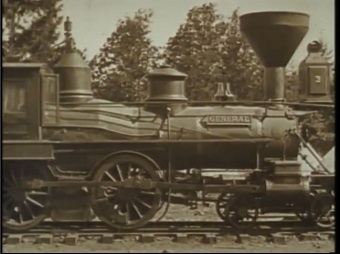 |
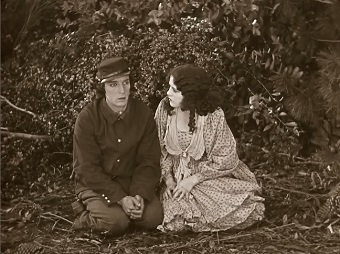 |
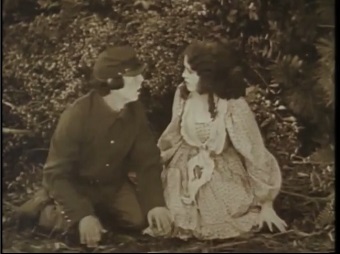 |
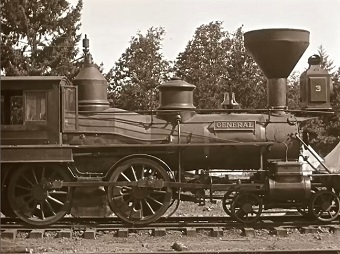 |
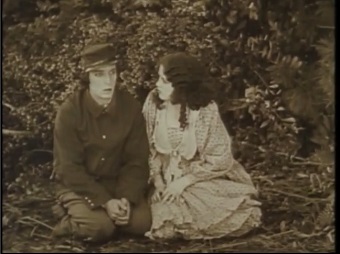 |
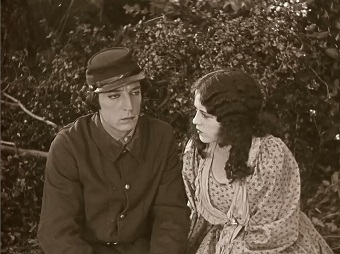 |
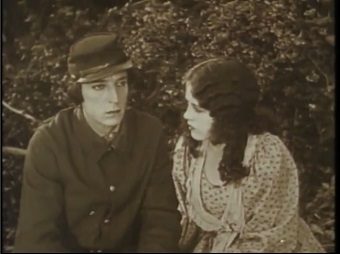 |
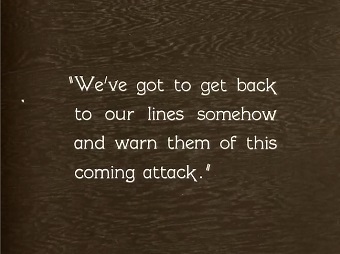 |
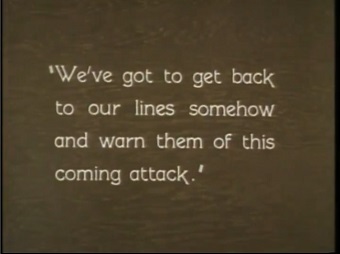 |
|
The above alterations are just small samples.
The alterations occur throughout the film, from beginning to end.
|
|
We need to ask ourselves Why?
Why did a staff editor get so much wrong?
Partly because there was nothing to check the work against,
but even so, some of the reconstruction should have been obvious.
Yet we need to take into account Buster’s filming techniques,
which were a byproduct of his editing technique, which was his alone,
it was a technique that, in those years, nobody else exercised, as far as I can tell.
|
|
A typical filmmaker making a typical film shoots scene 1 a couple of times until it is right,
and orders the preferred take to be printed and the rejected takes to be discarded without review.
Then it’s on to scene 2, ditto.
Then scene 3, and so on.
Each day, the editor works on the preliminary assembly by simply trimming the heads and tails off of the scenes and gluing them together.
Each day, the editor adds the previous day’s scenes to the growing assembly,
and then, a day after filming is completed, the preliminary assembly is ready for review.
There will be a few further trimmings or intercuts, and then the movie is done.
Simple.
|
|
Buster didn’t do it that way.
He did not just have one scene follow the next only to progress the plot.
He wanted sinuosity, intercutting not so much to show two simultaneous actions, but intertwining emotions.
That is why he added brief shots that a typical editor would have tossed out as redundant or meaningless.
A good example is in Our Hospitality, when, in the midst of dramatic action outdoors,
we see a brief glimpse of Mr. Canfield pacing in his parlor.
That adds nothing to the plot.
It adds nothing to the action.
It tells us nothing about the story.
That brief moment serves another purpose, and that is to show an evolving emotion,
which is not connected with the action but which comments upon it.
That is what we call subtext,
a concept that too many editors find incomprehensible.
A typical filmmaker would never show us such an image.
A typical editor would toss that image into the rubbish bin as meaningless waste.
For Buster, such images were crucial.
Another, of somewhat less significance, occurs in Sherlock Jr.,
when we see Ruth Holly smiling out the candy shop’s window.
That image is not connected to anything in the story;
it simply adds texture, flavor, mood, atmosphere;
it establishes a feeling, it shows us that another character, of whom we catch only a few glimpses, has her own story,
a story we shall never learn, just as we never learn the stories of most people we ever see.
A typical filmmaker would never think to create such an image,
and a typical editor would never use such an image, but would toss it out as meaningless.
The General has such moments,
such as the first shot in Reel 2, which simply shows Johnnie sitting on the coupling rod,
a beautiful diagonal composition, much more evocative than the standard
|
|
Where did Buster learn this technique?
As I say, I am absolutely CONVINCED that, upon getting a contract to make feature films,
he studied the art of narrative, either from books on the subject or, more likely, from one or more instructors.
He probably attended lectures on the topic.
When he learned that novels have interior dialogue, he decided to invent a visual equivalent.
That, above all else, accounts for the monumental leap forward from Three Ages to Our Hospitality.
|
|
It is hardly surprising that an editor, confronted with over 7,000 feet of disassembled film fragments,
would not know how to piece Humpty Dumpty back together again,
especially a Humpty Dumpty as subtly complex as a Buster Keaton feature.
|
|
Paul licensed his collection to
Blackhawk Films of Davenport, Iowa, for home use only.
In July 1970, Blackhawk issued Killiam’s three editions of The General in 8mm, Super 8, and 16mm.
There was the 49-minute “Hour of Silents” edition, which had a soundtrack.
It could no longer be printed from the copy negative, because
the copy negative by now had been chopped and chopped again and recut and then filled out again and discombobulated.
So “Hour of Silents” was printed from a dupe.
As for the 25-minute “Silents Please” edition, the contracts for the narration
created for the TV series and later for The Great Chase
probably did not cover sales for home use, or, perhaps, the license had expired altogether.
The spoken commentary was here inserted as new title cards in a version that was strictly mute.
There was also the full feature, which was issued strictly silent,
surely because Paul Killiam had not yet contracted for a music score.
My guess is that Blackhawk was interested only in the fullest edition,
but that Paul insisted “all three or nothing.”
Just a guess. I don’t know.
|
|
This was the very first time that Paul’s feature-length edition of The General was seen by the public.
Casual viewers surely noted some horrendously awkward editing,
but, unfamiliar with the authentic film, they would not be able to assign blame,
and they quite possibly thought the film was like that from its 1926 release.
It was so frustrating, disheartening, demoralizing to spend good money for the Blackhawk-Killiam edition
and then to see Anobile’s photonovel of the Rohauer edition.
There was simply no comparison.
The Rohauer edition had poor contrast, but otherwise it was far better,
with greater sharpness, and it was noticeably more complete.
It was even more disheartening then to see the slightly trimmed Jay Ward edition at the cinema,
with its almost dazzling visual quality and with more material than Killiam would ever offer.
|
|
(By the way, the commemorative film, Return of the General,
is online. Just click the link.
The original film from which it was adapted,
Here Comes the General, produced by the Louisville & Nashville Railroad,
well, sorry, no idea where to find it. Does it still exist?)
|
|
Those of you who have seen Blackhawk Films prints know all too well that each film began with a written historical introduction.
Why?
For use in schools.
When I was a teenager, these irritated me.
They would have been fine as printed handouts,
but I didn’t want my screen experience to be interrupted by these intrusions.
I feel a bit differently now.
The introduction to The General was authored by none other than Paul Killiam himself.
Let us take a look:
|
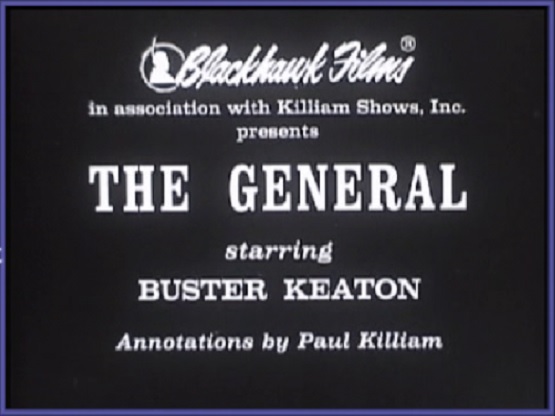 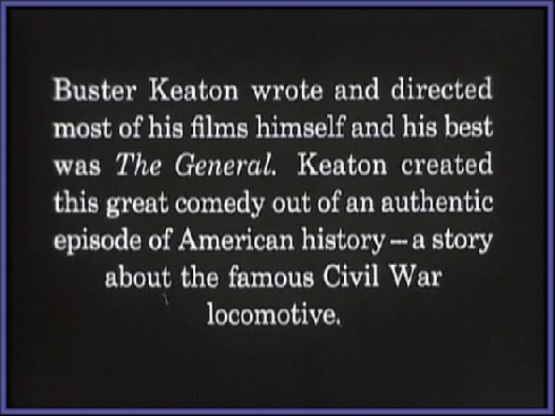 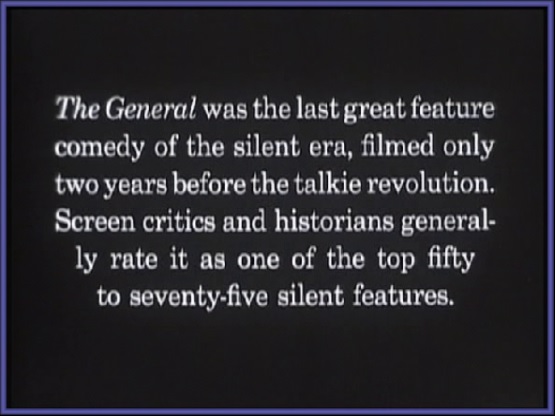 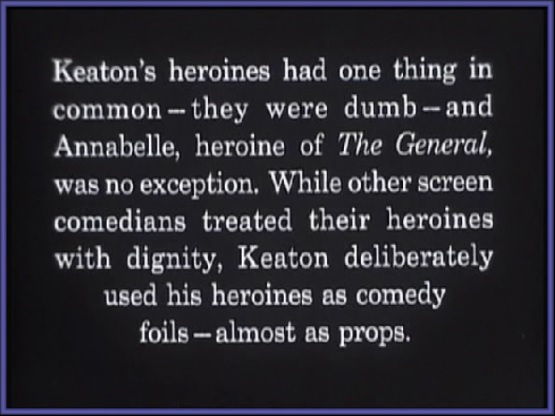 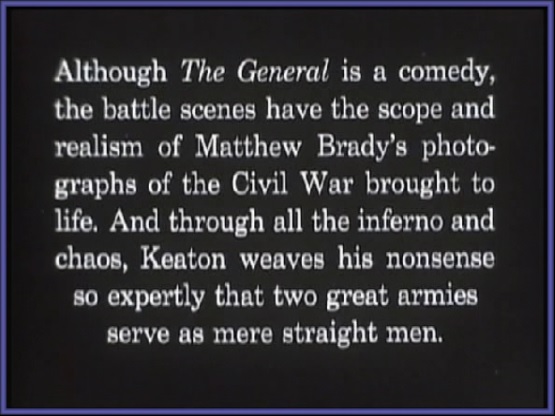 
|
|
You will notice that this text is pretty much the same text used in the Blackhawk Films Bulletin.
It was also pretty much the same text that was printed on the later VHS and Beta covers.
The bit about the leading ladies being dumb, that was from Joe Franklin’s Classics of the Silent Screen,
which was one of the few statements in that book with which I completely disagree.
|
|
Daniel Moews, “Bibliographical and Filmographical Comments,”
Keaton: The Silent Features Close Up
(Berkeley, Los Ángeles, London: University of California Press, 1977), pp. 328–330:
The General is another film in which I have noticed differences
among available prints, enough differences, I suspect, to make a
collation of the prints a highly desirable project. In particular, my
impression is that the Blackhawk Films print, which is probably the
most widely purchased, is edited a little more tightly than most
others and is perhaps as much as a few minutes shorter. Again to
limit comments to places where my memory is certain, I can point
out two deletions in the Blackhawk version.
First, there is the joke of Johnnie’s handcart travels. In the Blackhawk
print, he starts his forward roll, there is then a shot of the
Union train passing the Kingston station, and in the next shot
Johnnie and his handcart reach the missing section of rail and go off
the track. In some other prints, there is an additional shot: Johnnie
starts his forward roll, Johnnie is shown from a side view moving
down the track, and only then is there the shot of the Union train
passing the Kingston station.
Second, when Johnnie escapes from northern headquarters, in the
Blackhawk print he is shown crawling toward the outside door with a
small log in his hand, obviously aiming to attack the sentry there.
There is then a cut to Annabelle in her bedroom, and this is followed
by a shot of a second sentry by a window, who is approached and
knocked out by Johnnie, now dressed in the first sentry’s uniform. In
other prints, there is also a shot of Johnnie reaching through the door
and clubbing the first sentry.
In both these instances, though I wish I knew who made the deletions
and when, the Blackhawk print seems to me better than the
longer versions. The handcart gag is made more emphatic. There is
no unnecessary filler movement between the start and the almost
instantaneous end of Johnnie’s handcart journey. Similarly, the
implied rather than shown clubbing of the first sentry seems to me to
improve the escape episode. It increases the comic surprise with
which Johnnie appears in Union uniform beside the second sentry.
Also, the fact that the audience was denied the sight of the first blow,
which it had been expecting, makes all the greater its gratification at
being allowed to see the second blow, the unexpected and comic
swing of Johnnie’s shouldered rifle. Although both cuts seem to me
good ones, if they were not approved by Keaton (as I assume they
were not), I would prefer that they had not been made.
There is, finally, evidence of another deletion, one present in all
prints of The General. The music cue sheet originally released with
the film contains one action cue to a shot not now there. Cut 19,
“JOHNNIE SNEAKS INTO HOUSE,” refers to his entry into northern
headquarters; cue 21, a title cue, “IT WAS SO BRAVE OF YOU,” is
spoken by Annabelle after she and Johnnie have escaped into the
woods. In between, however, there is action cue 20, “OFFICERS
LEAVE TRAIN,” and this shot is missing in all currently available
prints. Since it is an interruptive and unnecessary one, it might have
been removed long ago, perhaps even as a result of some last-minute
editing at the time of the film’s original release.
My real complaint, I suppose, in this minute brooding over the
possible completeness and authenticity of currently available prints,
is that films cannot be preserved and studied as easily as books, that
all editions from the first to the most recent are not available to the
different audiences who might be interested in them. Also, I worry
that no record of any sort may even be kept, that eventually, with a
film like Sherlock Junior, only
As a last note on the state of present-day prints, it should be added
that since The General is a film available in many
|
|
In 1977, that was the extent of our knowledge.
Nearly half a century has rasped by us in the meantime,
and so now we can answer the questions.
It was an editor on Killiam’s crew who made the changes to The General in 1970,
and the changes were far more extensive than mere shortening.
The missing cue, “Officers leave train,” is a typo.
It should be “Officers leave table,” and that cue is still there.
What Moews thought was a
|
|
Incidentally, it was not only The General that Killiam altered.
In 1970 he claimed a copyright on a new version of Chaplin’s 1925 film, The Gold Rush,
which was a strange composite.
It went back and forth, every shot or two, from a copy of the MoMA print
to a copy of the 1942 reissue,
back and forth and back and forth,
and the whole was abridged by several minutes.
What other changes his editor made, I do not know.
Someday I’ll examine it side by side with the other versions
so that I can see for myself precisely what he and his crew did.
I suppose that all the Killiam releases suffered these sorts of revisions.
|
|
Here’s a poster for the follow-up series in 1975:
|
|
Then, in 1971, Paul began a new TV series on educational television.
It was first broadcast in NYC on the NET/PBS outlet WNET Channel 13.
It was called “The Silent Years,” hosted at first by Orson Welles,
later by Lillian Gish, and it ran through 1975.
This series was different from the previous two, for this one played the full-length films.
Paul hired
Karl Malkames
to film the intros and outros and to perform the restoration work preparatory to broadcast.
I can only assume that this restoration work consisted primarily of tinting the movies.
The broadcast editions did not match the tints of the original releases.
Malkames just tinted the films any old which way he wanted to.
He could not utilize the original obsolete and unavailable technology,
but instead used color filters on color stock.
The scores were by William P. Perry, who accompanied on piano.
(He wrote a sweet score for The General.
Unfortunately, it was miked poorly or
maybe some settings were off,
and so the sound of the piano was too harsh.
If you are an audio engineer, can you fix that?
If you can fix that, could you? And send me a copy? Pretty please with sugar and honey on it?
When I hear the Annabelle Lee waltz,
over the music my mind superimposes the words, “After the day is over, oh my dear Annabelle Lee...,”
and then my imagination crashes to a stop and no more words come.
You can listen to an interview with Bill Perry
here and
here.)
This newly tinted/scored edition of The General premièred on WNET Channel 13 in NYC on Tuesday, 3 August 1971.
The film was in the public domain, and yet it claimed a copyright.
(I have not been able to find a copyright registration.)
When Paul reconstituted the film from the cans of trims from the copy negative,
he got everything wrong, and thus he inadvertently created a new version of the movie.
Indeed, the credit reads, “COPYRIGHT 1926 BY JOSEPH M. SCHENCK. THIS VERSION COPYRIGHT 1970 BY KILLIAM SHOWS, INC.,”
which was misprinted as Killiams Shows in some prints.
|
|
“The Silent Years” broadcast the film from a 16mm print that had been reformatted.
The center of the image was enlarged and all four edges were trimmed off, noticeably.
|
|
If you want to see the Blackhawk edition with the Blackhawk intro, mostly but not entirely accompanied by the Bill Perry score,
it’s available on
|
|
When did Paul release 35mm full-aperture silent (.723"×.980") prints of this film to cinemas?
Not in 1957. Not in 1960.
I know for certain that it was in distribution by 1978 (which is when
it played at Don Pancho’s in Albuquerque).
It may have been as early as July 1970 that Killiam issued the movie to cinemas, but I doubt it.
I bet he issued it to cinemas in September 1971.
That would have been right after the showing on WNET/13, which would have served as his promotion.
|
|
Because it is Albuquerque, and because it was The Guild, a hole-in-the-wall dump that I adored
but which absolutely loathed me in return, I feel it only right and just to show you the following newspaper advertisement:
|
|
I had wondered which edition this was.
Was it Rohauer’s edition? Jay Ward’s? Or Killiam’s?
The advertisement is rather vague.
How was I to interpret it?
Well, let’s think this through.
The Guild ran only 35mm in them days.
There were only three distributors offering 35mm prints of The General in early 1972:
Rohauer distributed his own
|
|
Like I keep saying, it was a bit odd to issue a full-aperture silent print,
since, in those years, there were literally only three or four commercial cinemas worldwide that could accommodate that format anymore,
at the very most — more likely there were none at all.
Cinemas at that time, as I mentioned above,
would just crop the living daylights out of the movie, to .446"×.825" or, usually, a lot smaller even than that.
(I’ve seen setups of .350"×.700", and I suppose many cinemas committed even worse sins.)
The cropping rendered the film entirely incoherent.
Paul should have optically reduced the image to .620"×.864", and that would have solved many problems.
A full-aperture print of The General would be rendered senseless if shown in widescreen.
A reduced sound-aperture print of The General could withstand a widescreen crop, easily, happily.
Cinemas, which were no longer in the habit of hiring full-time musicians, would likely have run the movie without any musical accompaniment.
|
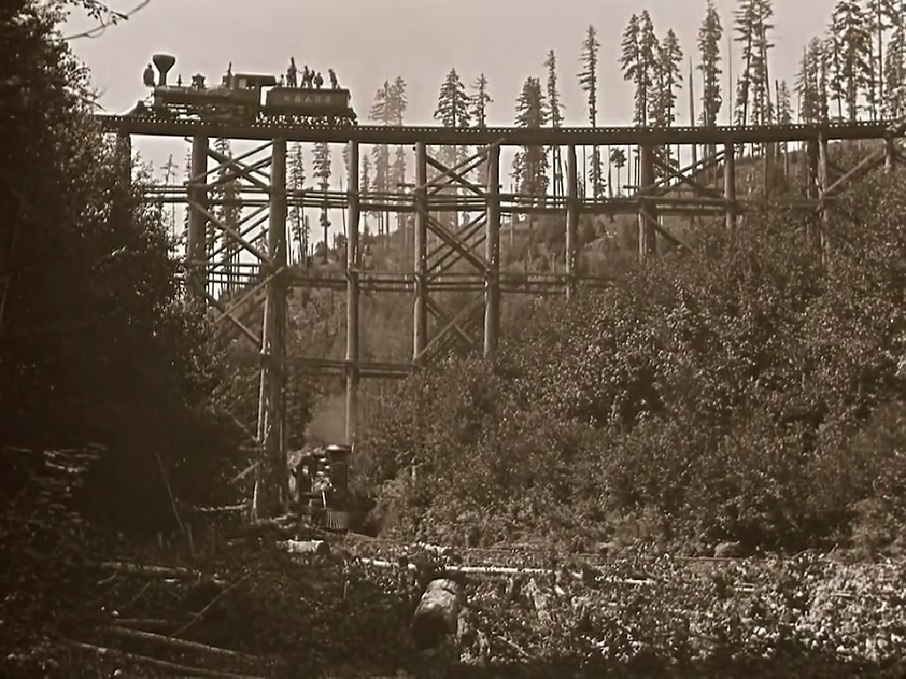 Original |
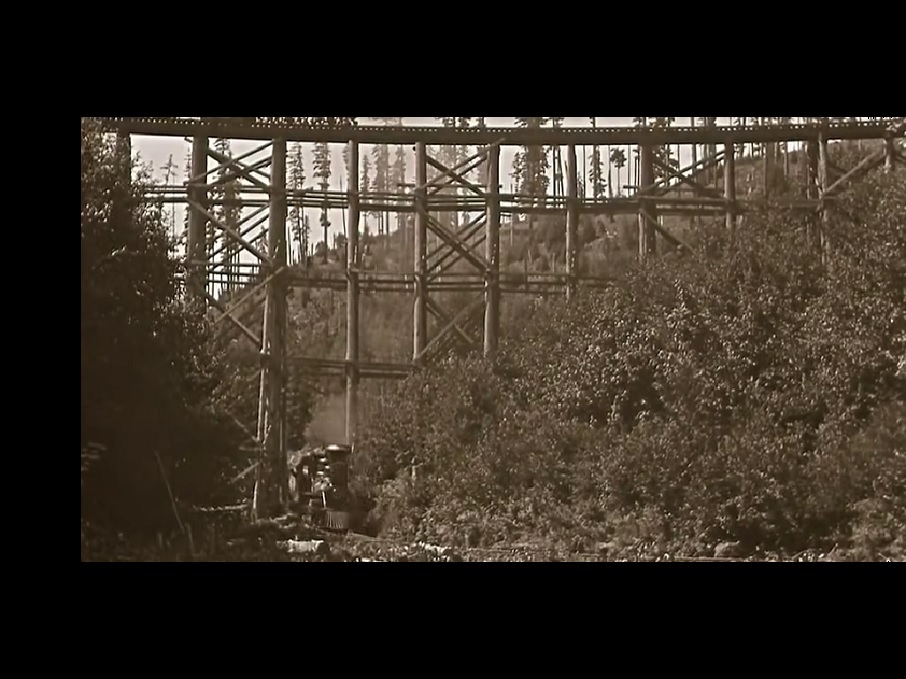 .446"×.825" widescreen crop |
Almost no commercial cinema on earth will correct this problem.
Why not?
Two reasons: 1. The vast majority of cinema owners, managers, and personnel can’t tell the difference.
2. Cinema owners, managers, and personnel are fully aware of that of the world’s 7,000,000,000+ people,
there is a grand total of 1 who cares, and that 1 no longer attends commercial cinemas.
|
|
Now that we’re looking at this image, we might as well explore it.
This was the first scene shot for The General.
Fans of The General had long wondered where this scene was filmed.
There were no over-and-under trestle bridges anywhere near Cottage Grove.
Well, the Bridgehunters finally found it!
It was at Black Rock, Oregon, just west of Dallas, about 95 miles north of Cottage Grove.
Click on that Bridgehunters link
to read the details.
|
|
|
I know for certain that Paul offered 16mm silent prints of The General for bookings to film clubs.
I know that because I saw one
in Albuquerque in January 1975, and it opened with a
Films, Inc. logo.
The 16mm edition of the movie popped up here, there, and everywhere.
When had Paul first offered the 16mm edition for rental?
I wish I knew.
Most likely between July 1970 and September 1971; that’s my guess.
|
|
A ha! The Winter 1984 catalogue was issued circa September 1983, and so that was when
Killiam licensed Bill Perry’s score to Blackhawk
for its Beta and VHS editions of the movie!
Mystery solved.
I purchased the VHS as soon as I learned about it, probably in 1985, maybe in 1986.
|
|
At some time or another, Paul added Bill’s piano score to some 16mm prints.
I never knew about that until
Juan Carlos Vicente posted this on YouTube:
|
|
https://youtu.be/UwQCFSeOmdE “El Maquinista De La General”, Buster Keaton, 1926. Película completa, subitulada en español Sep 26, 2016 When YouTube disappears this, download it. |
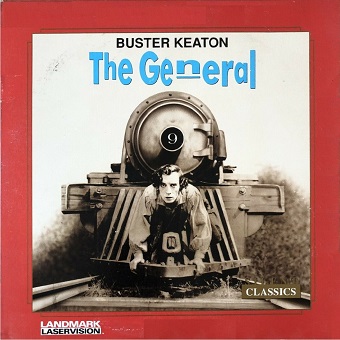
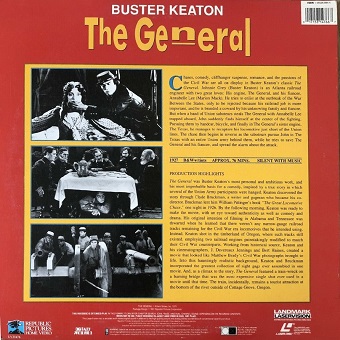 No idea why the locomotive was touched up or why 5 was changed to 9. K27-206, ???, K27-167, ??? |
|
Paul’s tinted TV edition with Bill Perry’s score
was issued on a Landmark Laservision laserdisc, #LV21476, distributed by Republic,
released 18 December 1991.
On the back cover is a publicity still that I’ve never seen anywhere else,
with Johnnie under the table at the Union rendezvous, but in a different pose.
Oh. I see it was also issued on Republic VHS in 1992.
I discover that Killiam had also licensed this tinted version to Channel 5
(1 Rockley Road, London W14 0DL) for PAL VHS release in 1986.
|
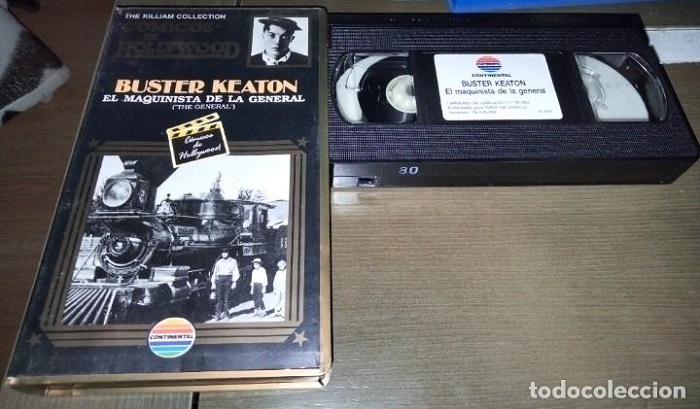 Also licensed to Continental in Spain at sometime or another. |
|
Over the next six years or so, Killiam Shows came to add a few more Buster films to its catalogue:
a copy of
Cops (organ score by Gaylord Carter) with the middle of the film deleted,
a rejected preview print of
The Blacksmith (the editing-shed edition, piano score by William Perry),
The Balloonatic (organ score by John Muri),
College (organ score by John Muri), and an alternative (export?) and a sometimes
|
|
Killiam was not the first to make such duplications.
For his 1968 16mm compilation,
The Great Stone Face,
Vernon P. Becker had surely used the MoMA materials as sources.
I have
The Great Stone Face on VHS and DVD but I am unable to watch it all the way through.
That compilation achieved the remarkable effect of making Buster entirely dull and tedious.
It is usually a bad idea to run one comedy short after another after another.
One is a delicious dessert.
Two are too rich, the second film conflicts with the effect of first,
and even if the second is far superior and far more enjoyable, it falls flat.
Three is force-feeding.
Four is torture.
It doesn’t help when the prints are many generations removed from the originals.
It really doesn’t help when a narrator talks us through to explain to us what we are seeing and why it is funny.
The surest way to make something unfunny is to explain why it is funny.
Narration can be done effectively, but only in small doses.
Bob Youngson had a nice formula for his few feature compilations;
he knew how to do it properly, and he included well-placed excerpts, not entire shorts one after the other.
I feel sorry for anyone who was introduced to Buster via The Great Stone Face.
That, I am sure, served only as aversion therapy and drove potential fans away forever.
The movie was so bad that it was not released in the US.
Rohauer gobbled up the rights and then rather bury it in an unmarked grave,
he licensed it to British television and to German VHS.
The movie seems eventually to have had some sort of brief cinema releases in
Italy and
Spain and Argentina, though, surely enlarged from 16mm to 35mm, which I am certain made the images even more painful to look at.
Oh my heavens!
The Great Stone Face WAS issued in the United States!
It played at the Harvard Exit in Seattle on
Friday, 23 December 1977.
Ouch!
|
|
Getting back to Cops, in the Killiam edition, the final minute or so of the first reel is missing.
It could be that, being tightly wound at the core, that part of the film had simply bubbled away to nonexistence.
Maybe.
I suspect that it was Killiam who snipped it out
in order to make it appear that he had used a
|
Jay Ward’s “Sound Version” of 1970 |
|
I mentioned Jay Ward Productions’ “sound version” of The General several times above.
You may even someday run across it yourselves, though it is no longer in release and has never been issued on home video, as far as I am aware.
This was optically reduced from the original
|
|
There is some background here.
It was in 1961 that Jay Ward and his business partner Bill Scott began work on a TV series called
Fractured Flickers,
featuring clips of old films licensed from Rohauer, ridiculously edited together and given preposterous
|
|
The first I knew about the Jay Ward version of The General was on Saturday, 10 April 1976,
when The Guild in Albuquerque
cropped it at undercut 1:1.66 widescreen, .497"×.800", and ran it misframed, with only the bottom of the image showing on screen.
Curious about what I had just witnessed, I visited the Hoffmantown branch of the Albuquerque Public Library,
looked through Reader’s Guide, and discovered a reference to Paul Warshow’s
negative review of this version,
“More Is Less: Comedy and Sound,”
in Film Quarterly vol. 31 no. 1 (Fall 1977),
|
|
SOME CHOICE EXCERPTS FROM
PAUL WARSHOW’S REVIEW:
...Let us deal first with the less serious change: the
changing of the intertitles to subtitles superimposed
over the images — and, in at least one case,
the complete elimination of the text of an intertitle....
In this print the text of at least one title has been
dropped entirely. Escaped from the Union men, as
well as from a bear, Johnny (Keaton) and Annabelle
huddle together (he kneeling awkwardly with
his arms around her, she sitting with her head on
his shoulder), frightened, in the woods in late
evening in the middle of a drenching storm. Fade-out.
In the original a title appears: “After a nice,
quiet, refreshing night’s rest.” Fade-in to almost
the identical shot, only better-lit, with the two in
the same uncomfortable position. Whoever decided
to eliminate the title and follow the dark shot
immediately with the brighter one may have
thought this would improve the joke by making it
“purely visual” and more subtle for they may have
decided that, since the text couldn’t work as a
subtitle, it had to be eliminated). But the title,
both as a text and as a rhythmical “beat” or
“rest,” is an essential part of the joke, and eliminating
it attenuates the joke to practically
nothing.
But the really terrible change is in the sound
track: in the addition, along with the music, of
realistic, quasi-synchronous sound. While Johnny
is trying to escape silently with Annabelle from the
Union headquarters, a window falls down on his
hands: this print supplies the realistic sound of the
window falling and landing. A group of soldiers
takes aim, smoke rises from their guns, enemies
fall dead: this print supplies the sound, as realistic
as in any sound film, of the guns going off (indeed
most of the realistic sound in this print is the sound
of gunfire).
On the face of it this change offers us More, but
in fact it gives us immeasurably Less, because it
temporarily destroys the film at its roots — as it
would with any silent comedy. For the absence of
realistic sound is silent comedy’s defining element,
its very foundation. To add realistic sound is to
destroy this foundation and throw off the delicate
balance between stylization and realism that enables
the comedy to work....
It must be admitted that the people who added
the realistic sound to this print have exercised a
certain amount of restraint. They have not inserted
realistic sound in all the places they could have,
only in some, so the comic world is destroyed only
in patches, temporarily. The musical score, on the
whole, is appropriate and, as musical accompaniment
generally does, helps push the film in the
direction of greater stylization, both when the
music is the sole accompaniment and when it is
joined by the realistic sound (which pushes the film
in the opposite direction: toward realism). The
film is still funny. It is simply less funny, funny less
often, than it was....
It’s true that the distributors also have silent
prints available.... Raymond
Rohauer says he prefers to watch the silent
“authentic” version, which he says should be
shown with live accompaniment, but says that version
is for “purists”; and he approves the showing
of the sound version to the “mass audience,” who
“just want to have a good time on a Saturday
night.” To prove that this is the version the mass
audience “wants,” he puts forth the information
that “they” have “never complained.” But this is
just a new instance of an old commercial sophistry,
fallacious on several counts. First of all, most
members of the “mass audience” aren’t conscious
of the alternatives. If they were, they might not
care or might even prefer a non-“modernized”
version. Second, only a small fraction of those
bothered are going to register a complaint. Third,
anyone who does register a complaint automatically
becomes a “purist” and outside the “mass
audience.” And, finally, even if it could be shown
that there is a “mass audience” that prefers bastardized
versions of a great artist’s work, that
would hardly prove that the right thing is to give
them these versions.
Moreover, the choice supposedly offered by the
distributors, between the showing of this sound
version and an authentic showing of an authentic
version, is more apparent than real. Besides the
bastardized sound version, the only versions the
distributors offer us have no sound track —
and, as Rohauer indicated, are meant to be shown with an
appropriate live musical accompaniment. But live
accompaniment of silent films is pretty much a
thing of the past. It is still done at New York’s
Museum of Modern Art and maybe one or two
similar places, but only a few theaters have it, and
they are ones devoted to camp nostalgia. Thus,
from the standpoint of sound, all the 35mm prints
available are inappropriate — for the choice the
distributors really offer us is between the bastardized
sound version and one of their silent versions
shown without accompaniment. The “silence” (in
other words, the sound of the audience and other
ambient sound) that occurs in the latter case,
while preferable to this sound track, is likewise
inappropriate, for silent films were meant to be
shown with a fitting musical accompaniment,
which itself provides an important element of
stylization....
It is ironic that the man who has sanctioned this
violation of The General (the changes were actually
carried out by Jay Ward Productions, to whom he
leased the rights) is Raymond Rohauer — for next
to Keaton himself, Rohauer is the person to whom
present-day Keaton lovers owe the most. Not only
is he responsible for the films’ current 35mm distribution;
he also restored the films and brought
them back into distribution at a time when Keaton’s
reputation was in eclipse. And a beautiful job
of restoration it was: whatever complaints one has
about the sound print of The General, its pictorial
quality is superb. From all the evidence, Rohauer
has been motivated not only by commerce but also
by a genuine love for Keaton’s work. But we
should not let our gratitude to Rohauer inhibit us
from protesting strongly against the desecration of
Keaton’s work that he has recently authorized.
(Incidentally, this sound print of The General has
“Produced by Raymond Rohauer and Jay Ward
Productions” in the credits, leading anyone who
doesn’t know better to think these fellows were
actually around helping Keaton make the film.)
The issue, of course, extends far beyond The General.
Jay Ward Productions, who made the
changes in this print, are now at work making
sound versions of all of Keaton’s silent features —
and these will be the only sound versions available
in 35mm. If they go on thinking that the kinds of
changes they made in The General are just fine —
are, moreover, what the public wants — they are
going to make the same sorts of changes in the
other films. They will go on changing intertitles to
subtitles and are likely to become even freer in the
adding of sound effects, the complete elimination
of titles, and who knows what other changes. And
the distributors of other silent films will follow suit.
And if the distributors decide that bastardized
versions are what the public wants, they probably
won’t bother to keep authentic versions in distribution.
In fact they might not even bother to preserve
authentic versions. Things might reach the
point — and this would be tragic — where the
authentic versions were lost forever.
One crucial difference between the desecration
of films from passivity and the desecration of films
in the name of active improvement is that the
latter, unlike the former, is based on an assumption
about what the public wants. This makes the
latter easier to deal with, for if the distributors can
be convinced that these “improvements” are in
fact something the public does not want, they will
desist. We should protest now, making it clear to
the distributors that we do not want these violations
and that we will not allow them to be made without a fight.
Rohauer’s address is Suite 16B, 44 West 62nd St., New York, NY 10025.
To my surprise, Warshow was correct to claim that the only edition in the US with a soundtrack was the Jay Ward edition.
Rohauer prints with an Erwin organ score would not be made available for regular bookings until 1979.
Is Paul Warshow still amongst us?
Is there a way to reach him?
If so, please let me know.
Thanks!
|
|
In trying, just now, to get the
|
|
No, it was most definitely not created in 1953.
Wikipedia further claims that Rohauer renewed the copyright in 1983.
Something is off there, totally off.
Whatever the case, it was The Raymond Rohauer Himself who infected the record.
Behold:
|
|
Huh? Ray backdated his copyright application and faked it. Total fraud. That’s all. Nothing more.
The above copyright registration predates Jay Ward’s edition.
|
|
I just received
Keith Scott’s book, The Moose That Roared: The Story of Jay Ward, Bill Scott, a Flying Squirrel, and a Talking Moose
(NY: St. Martin’s Press, November 2001).
When we turn to pages 299–300, we read:
|
|
Bill Scott produced a couple of commercials for various causes like the
Mental Health foundation, using Ward Productions facilities. Then in 1974,
he began work on several new compilation live-action films for release by
Ward Productions. These were along the lines of the earlier
Crazy World of
Laurel and Hardy. Taking advantage of his passion for classic motion-picture
comedy, Bill wrote, narrated, and assembled some fascinating retrospectives
on comedians Buster Keaton (The Golden Age of Buster Keaton), W. C. Fields
(The Vintage W. C. Fields), and Robert Benchley (Those Marvelous Benchley
Shorts). All featured lengthy and representative film clips, along with nice
cartoon links animated by some of Ward’s favorite artists, like Phil Duncan
and Ben Washam. The Keaton films, deposited years earlier in Ward’s vault
by Raymond Rohauer, were simply too good to leave gathering dust, while
the rights to further comedy films had slowly been acquired by Ward. As
Bill Hurtz explained, “Jay had purchased the old films as an investment.”
These compilation features were lovingly completed by Scott and Skip
Craig over several years. Skip remembered, “Bill and I didn’t have a real
system, it was pretty loose. He’s come in most days and run the films on a
Movieola, and smoke up the place with those cigars of his, which I hated.
He’d just mark a roll of film and yell for me, and I’d do whatever he
requested: sometimes he’d switch the sound track for an effect, and he’d
theme the pieces of film. The first one was the W. C. Fields movie. There
was a sequence in there that no one had seen for thirty years from Tales of
Manhattan. We finished it, but our Fields film never played; we’d done
some little animated bridges in which Bill imitated Fields’s voice. But the
Fields estate wouldn’t allow it to be released; of course, Jay refused to take
the bridges out, so that was that.
“Then we did the best of our live-action films — Keaton’s feature The
General. This time we got the full-aperture fine-grain print from
MGM, and it was beautiful quality. Rich Harrison put in the sound effects, and
Joe [Siracusa] did the music again. We recorded some narration, but we hardly
had to touch the film — except we took out most of the dialogue cards, and
stuck in some maps and explanatory things. It was a gorgeous picture, and
I actually got to fix a tiny cut that Keaton had goofed on — he used to cut
all his own pictures. It played recently on HBO.
“The last one we did was the Benchley feature....”
|
|
That’s another curious story, is it not?
So many things wrong.
So many, many things wrong.
What else is new?
Let’s do a little checking.
The Golden Age of Buster Keaton
was released in 1975.
Except that it wasn’t.
It was ready for release in 1975, but no distributor was interested.
There are some vague indications that
The Vintage W. C. Fields
was indeed released to cinemas, also in
1975, but I don’t think that happened.
It seems more as though a release was announced but withdrawn before a single booking.
The Fields movie was definitely shown on HBO, though, in
August 1979.
I have a Rohauer catalogue in my possession that makes clear that The Vintage W. C. Fields was available only on broadcast videotape.
Now it begins to look like Skip Craig’s memory is partial.
The Benchley compilation was not released.
|
|
Now we get to The General.
According to Keith Scott and Skip Craig, this was the third production,
and so could not possibly have been released any earlier than 1975.
Skip Craig mentioned the narration, but there is no narration in the release edition of the film.
Perhaps there was in a
|
|
Oh. I was just chatting with a friend, and he instantly figured out why.
In 1947 or or 1948, MGM optioned remake rights to The General.
MGM needed a reference print, and so paid United Artists to run one off.
That’s why.
Buster’s part would be played by Red Skelton, and Buster would be on staff to supply gags.
The movie never happened, probably because the cost was prohibitive.
Instead, MGM, Red, and Buster worked on a different Civil War yarn called
A Southern Yankee.
I’ve seen bits and pieces of it, and it looks bloody awful.
It doesn’t look like a movie; it looks more like third graders putting on a school play.
I guess I’ll force myself to sit through it some year.
Another tenuous
|
|
It just now occurs to me.
It was in 1969 that MGM was purchased by real-estate developer Kirk Kerkorian in a hostile takeover,
and much of the archives — paperwork, props, costumes, film, music, and so forth —
were destroyed or auctioned off.
Could that be why the
|
|
Something else occurs to me.
When Bill and Skip made a copy negative from the
|
|
Of course, I’m being ridiculous.
Bill and Skip did not make two copy negatives from the
|
|
Then we get to another problem.
Skip Craig said that this string of work on these four features began in 1974.
No it didn’t.
Take a look at the poster for the Jay Ward version
of The General, and you will see that it has a 1970 copyright date.
|
|
Detail:
|
|
Oh, that G rating, it was fake.
These flicks were never submitted to the MPAA’s rating board.
|
|
The opening credits erroneously provide a 1969 copyright, a 1969 copyright notice that would be visible on American widescreens.
Yes, the Jay Ward edition of The General was shown in American widescreen.
The entire height of the image was on the reformatted Academy-aperture film,
but I am quite sure that not a single cinema anywhere showed the full image.
Bill Scott and Skip Craig and their crew were fully aware of the format mismatch,
but it is clear what they did.
After they reduced the image to Academy .620"×.864", they tested it by running it at American widescreen .446"×.825"
in order to see what adjustments they would need to make.
To their delight, all the action fit through that smaller aperture.
Some of the cropping was too tight, but it never, not once, not for a single frame,
deleted any essential action.
So they performed no further reformatting, and, to my astonishment, it worked.
|
|
So there we go, once again: Proof that I was not only wrong, but totally, completely, absolutely wrong.
Time for rewrites.
I know from years of painful experience that pretty much any older film can be cropped to widescreen
and in most scenes it will play just fine.
Framing in most movies is quite loose and the edges can be sacrified, usually.
If you run an older movie in widescreen, though, no matter how nicely it plays that way,
sooner or later there will that that scene, that dreaded anticipated scene,
that scene that does not fit, that does not even come close to fitting,
that is utterly senseless on widescreen.
So typical. So inevitable.
If you run a
|
|
Moreover, Buster and his cameramen usually — usually —
used the rule of thirds, which makes for nicely composed images, extremely loose.
Not always, though.
The rule of thirds allows for dramatic exceptions, and those exceptions would fall off were the image cropped.
Give a small child a camera, and chances are that the small child would snap photos composed per the rule of thirds.
It’s a natural thing to do.
It’s the way we see the world.
Busyness is centered, and objects further from the center are less and less important,
until we get towards top, bottom, left, and right, where the image conveys little or no useful information.
|
|
So, I was not surprised when the first scene of the optical reduction of The General fit at 1:1.85.
I was not surprised when the second scene fit.
Or the third.
Or the fourth.
Or the tenth and running.
What shocked me, shocked me to the core of my being, is that EVERY shot in the movie fits at 1:1.85,
or comes so close to fitting that it almost doesn’t make a difference.
Not just merely fits, but really looks as though it was deliberately composed that way.
Actually, it would fit a little better at 1:1.66, but nonetheless, at 1:1.85 it looks fine,
all the way through, every moment, beginning to end.
This is not an accident.
This is not a coincidence.
If it fits that close to perfectly, with perfect consistency,
and if the heads consistently line up exactly at the 1:1.85 safe area, which they do,
that can only mean that it was intentionally composed that way.
WHY???????
|
|
I went through the Kino K669
|
|
What on earth was Magnascope?
Screens in those days were pretty small.
In a gigantic movie palace, the screen might be a mere 15'×20'.
With Magnascope, there was a change.
Enormous screens were installed, but they were mostly covered by black cloth.
To the audience’s eyes, the screen looked normal, just like the regular 15'×20' screen.
But then, lo and behold, when a particular dramatic moment or action scene would begin,
there would be a switch to a different projector
with a lamp burning at a higher amperage and with a shorter lens (or with an enlarger attached to the regular lens).
The stagehands would open up the black maskings at the top, left, and right, and the image would appear to grow to mammoth proportions.
In its original conception, there was to be no crop.
The entire image would grow.
Few cinemas could accommodate such, and so the height was cropped.
|
|
A colleague forwarded me a vintage article by Harry Rubin,
“The Magnascope,” The Motion Picture Projectionist, November 1928, p. 13.
Probably no two cinemas had an identical installation,
but Rubin published a diagram of a suggested setup:
|
|
Note that the suggested crop has a height-to-width ratio of 1:1.60 !!!!!
I am not certain about this, but it seems to me that it would have been possible to open the maskings even a little further.
If so, the resulting ratio would have been about 1:1.75, which is an even more severe crop.
|
|
Shall we quote from Carr & Hayes?
Wide Screen Movies (Jefferson, NC: McFarland, 1988), pages 5 through 9:
|
|
...A projection lens was
developed in 1924 by Lorenzo del Riccio that enabled the enlargement by
four times of any 35mm scene on the screen. Paramount put the unit to use
on North of 36 and
The Thundering Herd in 1925,
and Old Ironsides in
1926. It was utilized on several other features from that studio as well as
other distributors. Initially the idea was to cover the screen in a ratio of
1.85 × 1 or whatever shape filled the stage proscenium arch. In fact the ratio
varied from 1 × 1 (in a New York theater) to slightly over 2 × 1, depending
entirely on the layout of the theater. Magnascope was meant only for
selected scenes, though many theaters used it on many, or all, of their features
to heighten the climax regardless of the subject. Westerns particularly
received Magnascope presentation....
Despite popular belief, cropping was not limited to a few big theaters
in a few large cities. Many small neighborhood theaters had acquired enlarging
lenses and would still be using them when cropping became the
official industry standard for spherical 35mm wide screen in the early fifties.
In those theaters the wider image so hyped by Hollywood would be nothing
new. Cropping had, in fact, become so common by 1930 that veteran cinematographer
Gilbert Warrenton suggested to all in the industry that a 2 × 1
safe area be included in the framing of all features, thus allowing the many
houses already filling their wide screens the benefit of prints that did not require
constant frame adjustment by projectionists. Others also backed such
an idea, most thinking the 1.85 × 1 ratio was better. The studios, however,
ignored these suggestions and continued with 1.33 × 1 framing until cropping
was adopted as part of the war against television. Little by little most
theaters replaced their wide screens for smaller, narrower 1.33 × 1 ratio size.
But some still kept the wider shape. (The authors know of two theaters that
used undersize apertures, as the projectionists called them, to render wide screen
presentation from the late twenties on. Both these cinemas were in
small towns, one in Georgia and one in Alabama!)
|
|
The above passage includes one of Carr & Hayes’s few errors:
North of 36
premièred not in 1925, but in December 1924.
There is also a bit of careless writing.
In one paragraph, they state that Magnascope was used only for climactic scenes.
In a later paragraph, they imply that some cinemas used Magnascope exclusively, not just for select scenes.
A transition was missing, a transition that made the evolution clear.
At first Magnascope was used only for climactic or especially action-filled scenes,
but soon it came to be used for everything.
A minor quibble is the reference to Lorenzo del Riccio, an engineer/inventor employed by Paramount Pictures.
His enlarging supplement was not the only available method to fill a Magnascope screen.
Another method, employed by a few or some or most cinemas, was simply to purchase lenses of a shorter focal length,
as we learn from Harry Rubin’s article.
|
|
The Bell & Howell 2709 had only a parallax viewfinder available as the camera was running.
Yes, it also had a more accurate viewfinder, true, but it was not available during the actual shooting; it was only to line up shots.
Nonetheless, the parallax viewfinder had
|
|
When did Magnascope make its first appearance?
One source suggested December 1926.
Well, if that was true, then the framing of The General must have had another explanation, certainly æsthetic.
Then I learned from that Carr & Hayes passage above that, no,
Magnascope had been in use for a year and a half before The General began production.
Once I learned that, it all made sense.
The General, with camera apertures of about .723"×.980",
was absolutely designed to withstand something like a .566"×.90625" crop.
Now, it does not follow that the film should be cropped.
Some scenes look better with a crop, but other scenes look better without a crop,
especially the routine with the railroad cannon.
Please do not crop the movie.
|
|
Thirty years later, that photographic compromise led to a happy result,
for the safe area almost exactly matched the 1:1.66 crop so common in the US beginning in 1953 and for the five or so years afterwards.
From about 1960 through about 1985, 1:1.66 was the most common crop outside the US, Canada, and Italy.
Since the framing was mostly quite loose, even a 1:1.85 crop did not harm the film.
(1:1.85, .446"×.825", was the most common crop in the US and Canada beginning in the late 1950’s,
and in Italy beginning around 1963.)
Though such a crop was too tight in some scenes of The General, the movements on screen told us what was happening just inches away.
Thus, even when cropped to 1:1.85, a 28% loss of image, it works, it’s presentable, and it’s every bit as enjoyable.
My mind is totally boggled.
Most video editions, by the way, crop the film, zooming right in to the center of the image and losing all four sides.
|
|
I have now checked all of Buster’s features from Three Ages through Steamboat Bill, Jr.,
and I used the Kino
|
|
Below is a poor copy of a VHS recorded from the Showtime cable transmission.
This is courtesy of a collector I met online.
Sorry about the defects, the darkness, the softness, and the
|
|
The General was released by Joseph Brenner Associates, Inc.,
which seems to have had a prior agreement with Ward to be exclusive US distributor.
I’m learning a little bit.
One thing I learn is that in 1968 Rohauer released The Best of W.C. Fields through Joseph Brenner Associates.
If you’re curious, The Best of W.C. Fields was merely three short films one after the other:
The Golf Specialist, The Fatal Glass of Beer, and The Dentist.
At least, that was the
|
|
Then remember the program notes that Ray wrote for the BFI’s National Film Theatre in January 1968?
Look again.
Ray gave his address as c/o Joseph Brenner!
|
|
Despite Rohauer taking a production credit on this new edition of The General, this was not a Rohauer release.
Despite this being a Rohauer title in the Rohauer Collection, this edition was not derived from any of Rohauer’s materials.
I just spent the better part of a day trying to trace down some bookings
of this package of The General and A Night with the Great One.
|
| OPENING | CITY | VENUE | RUN | NOTES | |
| Fri 25 Sep 1970 | Scranton, PA | Courthouse Square | 1 day | Outdoor screening during a concert | |
| Wed 30 Sep 1970 | Ferndale, MI | Radio City | 7 days | ||
| Wed 07 Oct 1970 | Doraville, GA | Doraville Mini Cinema | 7 days | ||
| Wed 07 Oct 1970 | Doraville, GA | Peachtree Battle | 7 days | ||
| Wed 07 Oct 1970 | Minneapolis, MN | Varsity (Mann) | 7 days | ||
| Wed 07 Oct 1970 | St Paul, MN | Grandview (Mann) | 7 days | ||
| Wed 07 Oct 1971 | Milwaukee, WI | Downer Theatre | 14 days | review | |

| |||||
| Fri 16 Oct 1970 | Memphis, TN | Guild (Art Theatre Guild) | 7 days | ||
| Fri 16 Oct 1970 | East Lansing, MI | State (Butterfield) | 7 days | ||
| Fri 16 Oct 1970 | Minneapolis, MN | Campus (Mann) | 7 days | move-over | |
| Fri 23 Oct 1970 | Kenosha, WI | Roosevelt Theater (Indep.) | 5 days | review | |
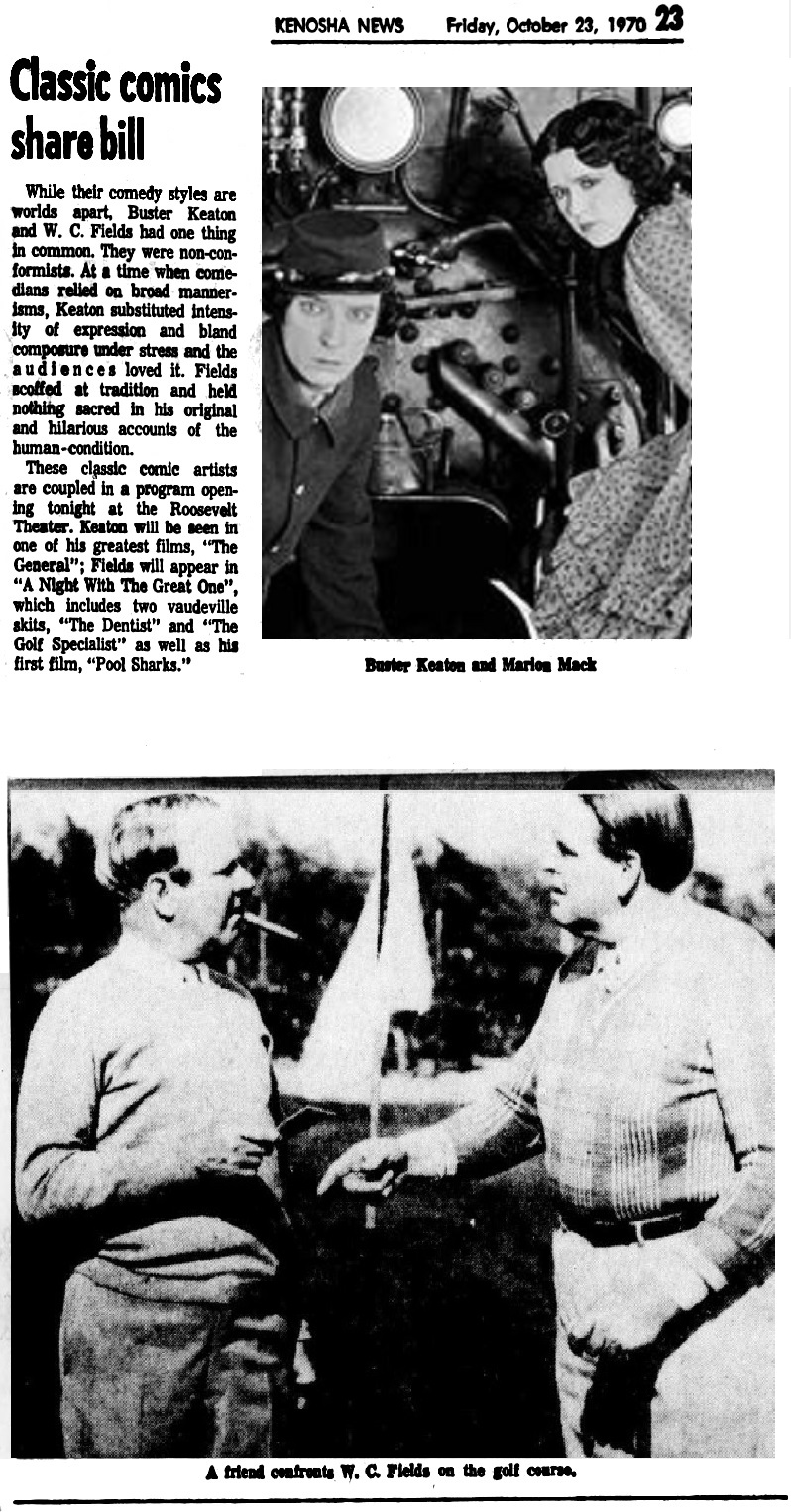 K27-200 | |||||
| Wed 28 Oct 1970 | Petersburg, VA | Bluebird (Indep.) | 7 days | ||
| Wed 28 Oct 1970 | Richmond, VA | Westhampton (Neighborhood) | 7 days | PR, review | |
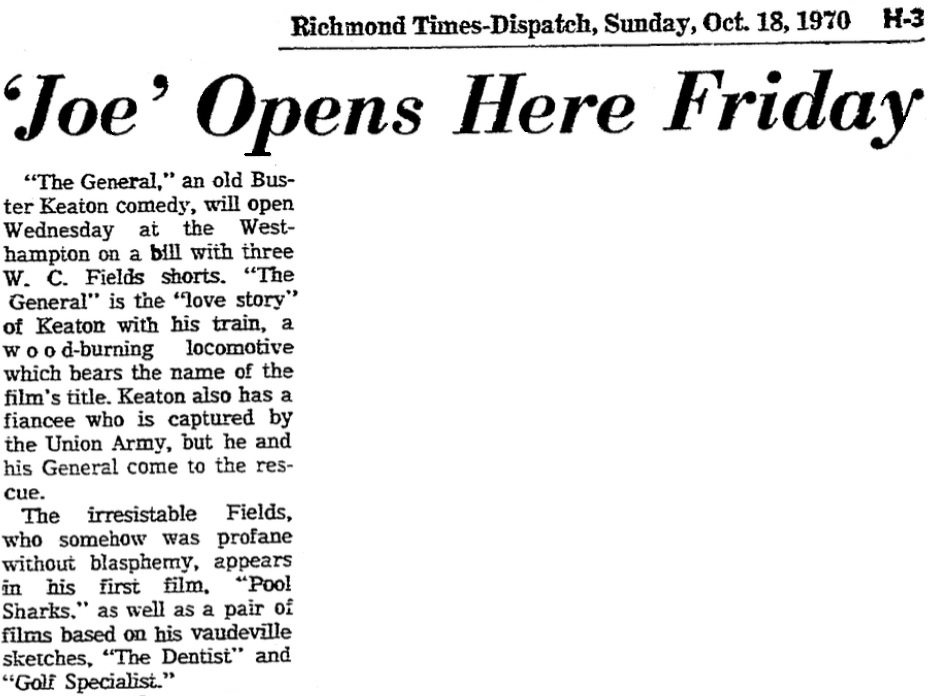
| |||||

| |||||
| Wed 04 Nov 1970 | Annapolis, MD | Capitol | 7 days | ||
| Wed 04 Nov 1970 | Columbus, MO | Hall Theatre (Commonwealth) | 7 days | ||
| Wed 04 Nov 1970 | Eau Claire, WI | Cinema 1 (Indep.) | 4 days | ||
| Fri 06 Nov 1970 | Wilmette, IL | Wilmette (Indep.) | 21 days | ||
| Fri 06 Nov 1970 | Omaha, NE | Dundee (Wide World) | 7 days | ||
| Wed 11 Nov 1970 | Cincinnati, OH | Esquire (Neighborhood) | 7 days | ||
| Thu 12 Nov 1970 | Charlottesville, VA | University | 3 days | ||
| Wed 11 Nov 1970 | Cincinnati, OH | Hyde Park (Neighborhood) | 7 days | ||
| Fri 13 Nov 1970 | Raleigh, NC | Varsity (Indep.) | 7 days | review | |
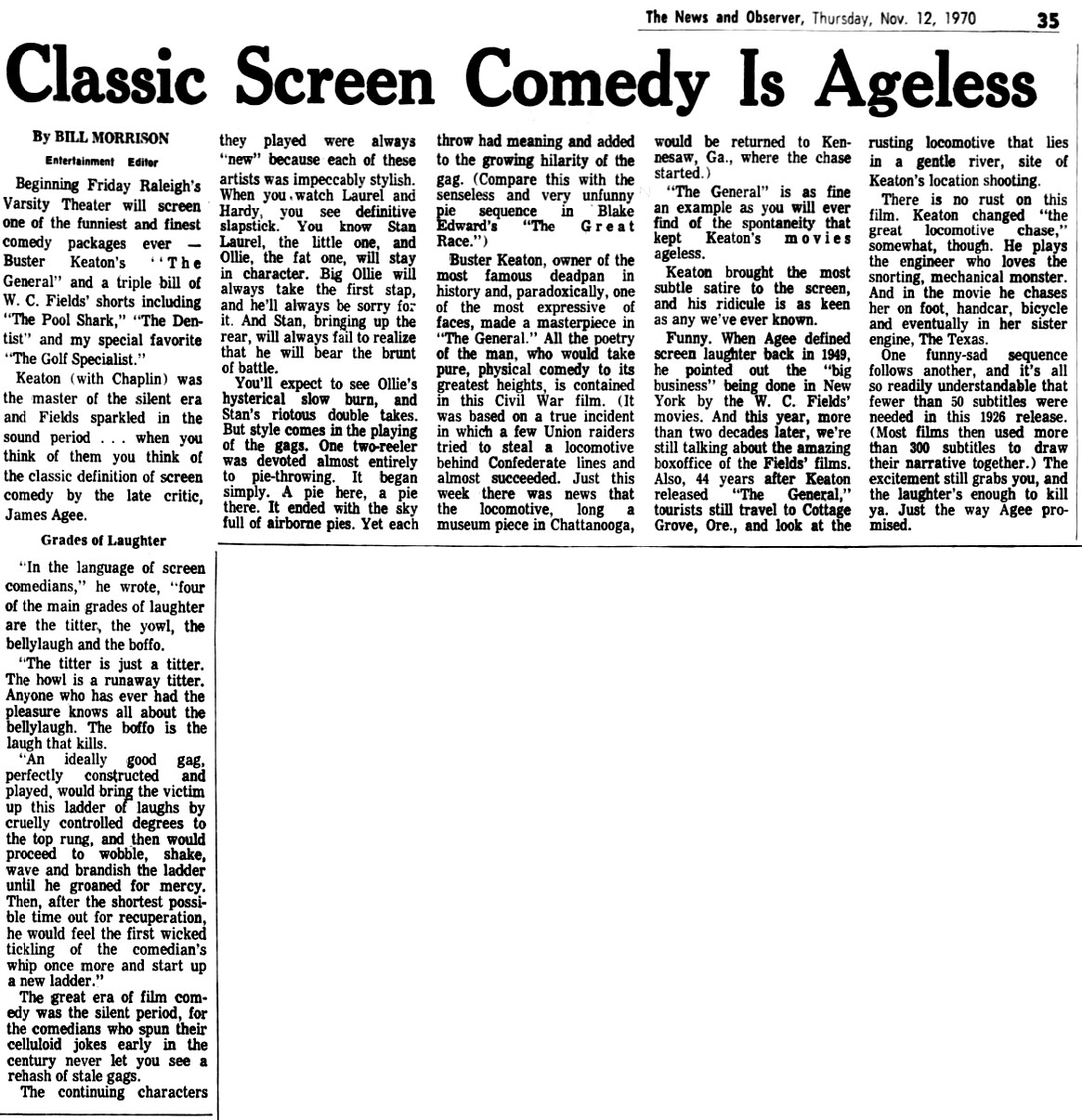
| |||||
| Fri 20 Nov 1970 | Rochester, NY | Fine Arts (Jo-Mor) | 12 days | ||
| Wed 02 Dec 1970 | Columbus, OH | University Theatre (GCC) | 4 days | PR | |
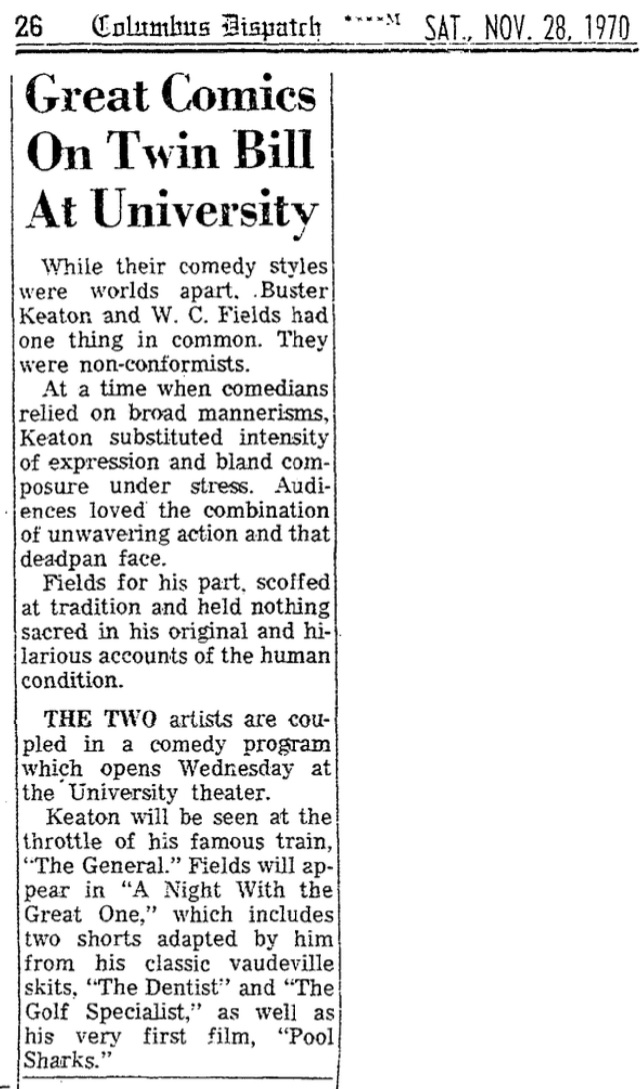
| |||||
| Wed 02 Dec 1970 | Kansas City, MO | Waldo (Commonwealth) | 14 days | review, review | |
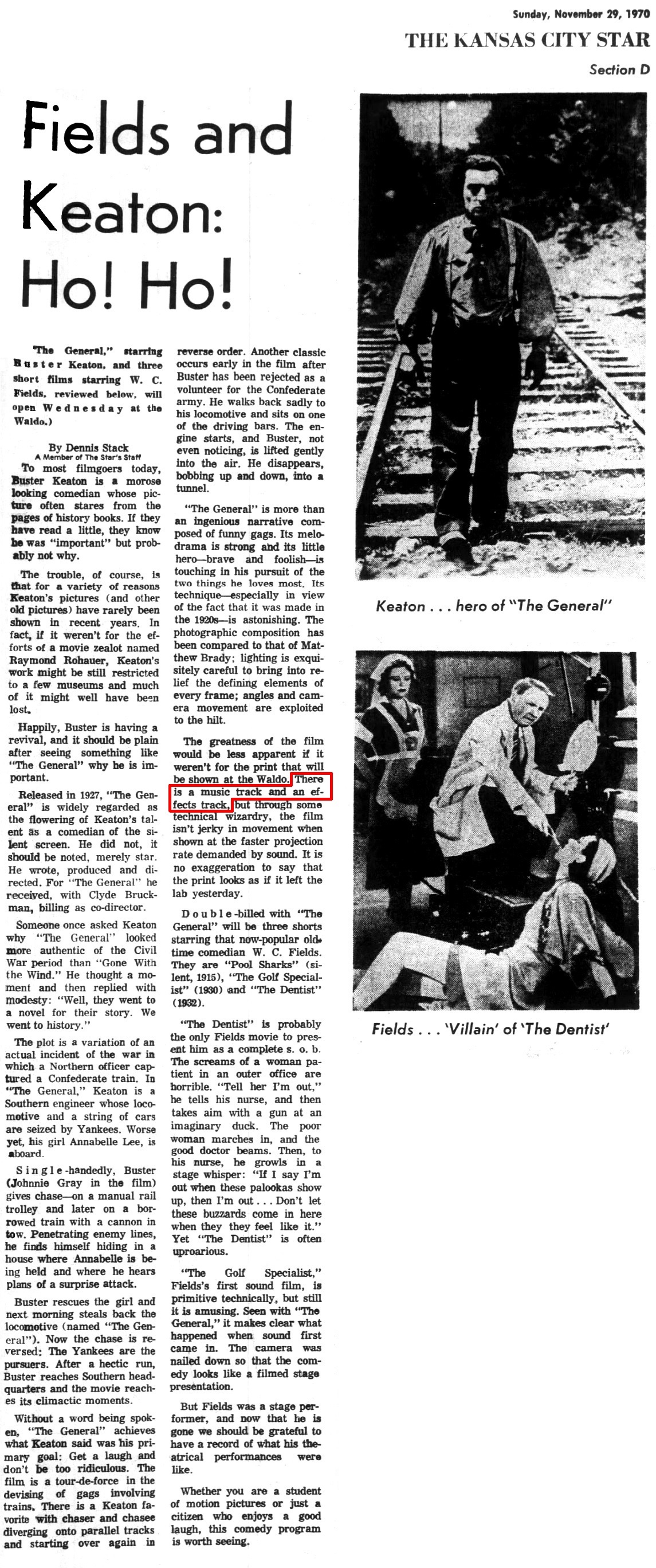
K27-90 | |||||
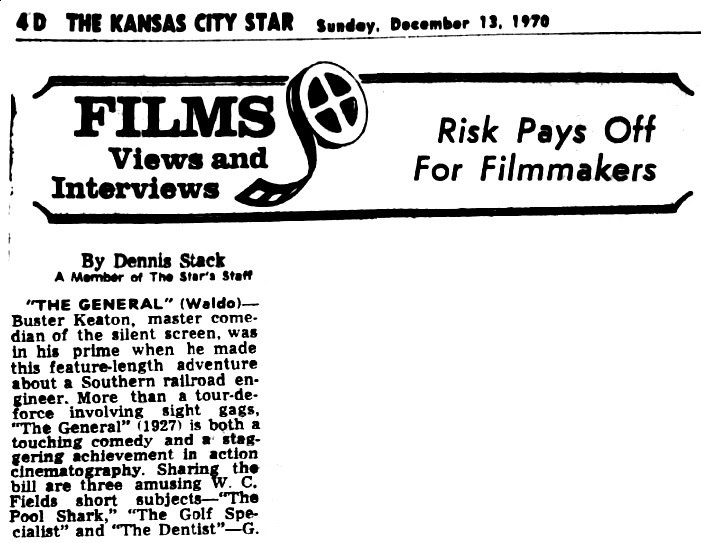
| |||||
| Fri 04 Dec 1970 | San Francisco, CA | Richelieu (Indep.) | 7 days | ||
| Wed 09 Dec 1970 | Des Moines, IA | Varsity (Davis) | 7 days | letter | |
 The Birth of a Nation (modified 1930 version) was also distributed by Joseph Brenner Associates, Inc. | |||||
| Chapel Hill, NC | Carolina Theatre (Indep.) | press release; this booking seems to have been canceled. | |||
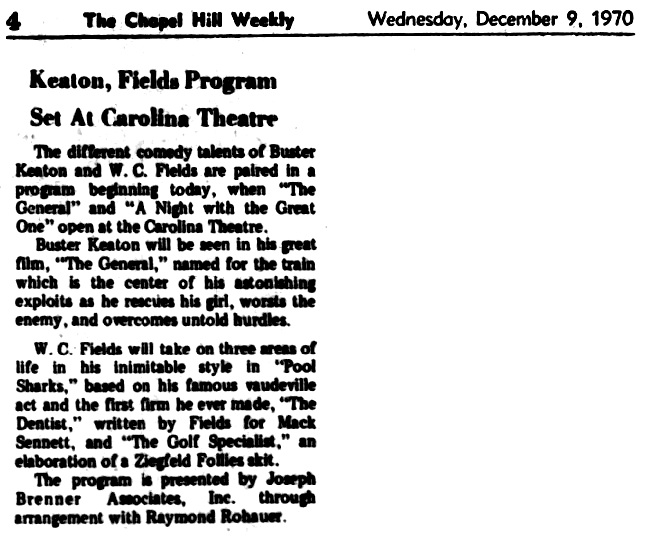
| |||||
| Wed 16 Dec 1970 | Wichita, KS | Uptown (National General) | 7 days | PR, PR, Barry Paris | |
|
The Birth of a Nation (modified 1930 version) was also distributed by Joseph Brenner Associates, Inc. | |||||
|
| |||||
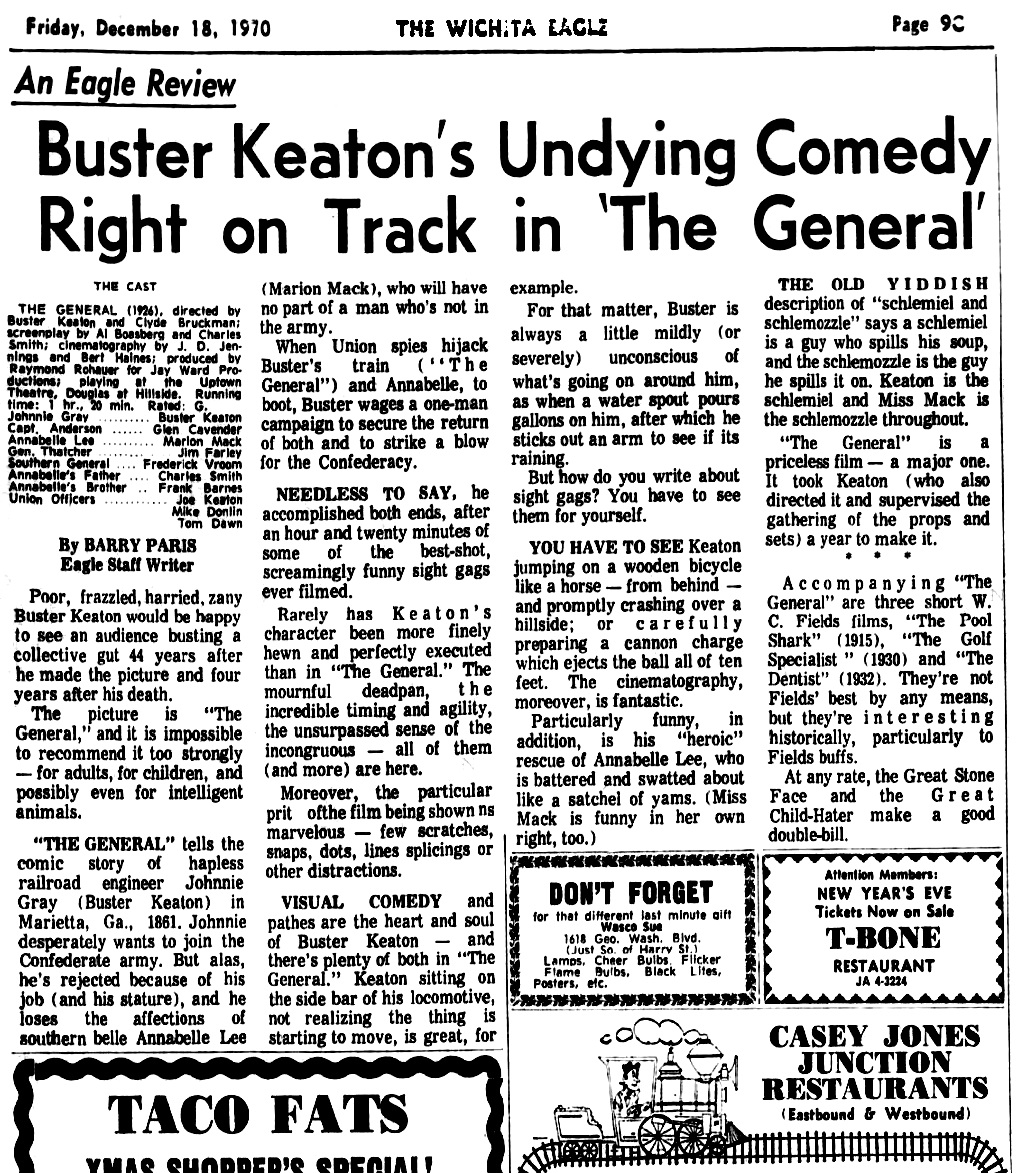
| |||||
| Wed 16 Dec 1970 | Davenport, IA | Coronet (Indep.) | 8 days | ||
| Sat 19 Dec 1970 | Greensboro, NC | Janus 1 | 6 days | PR | |
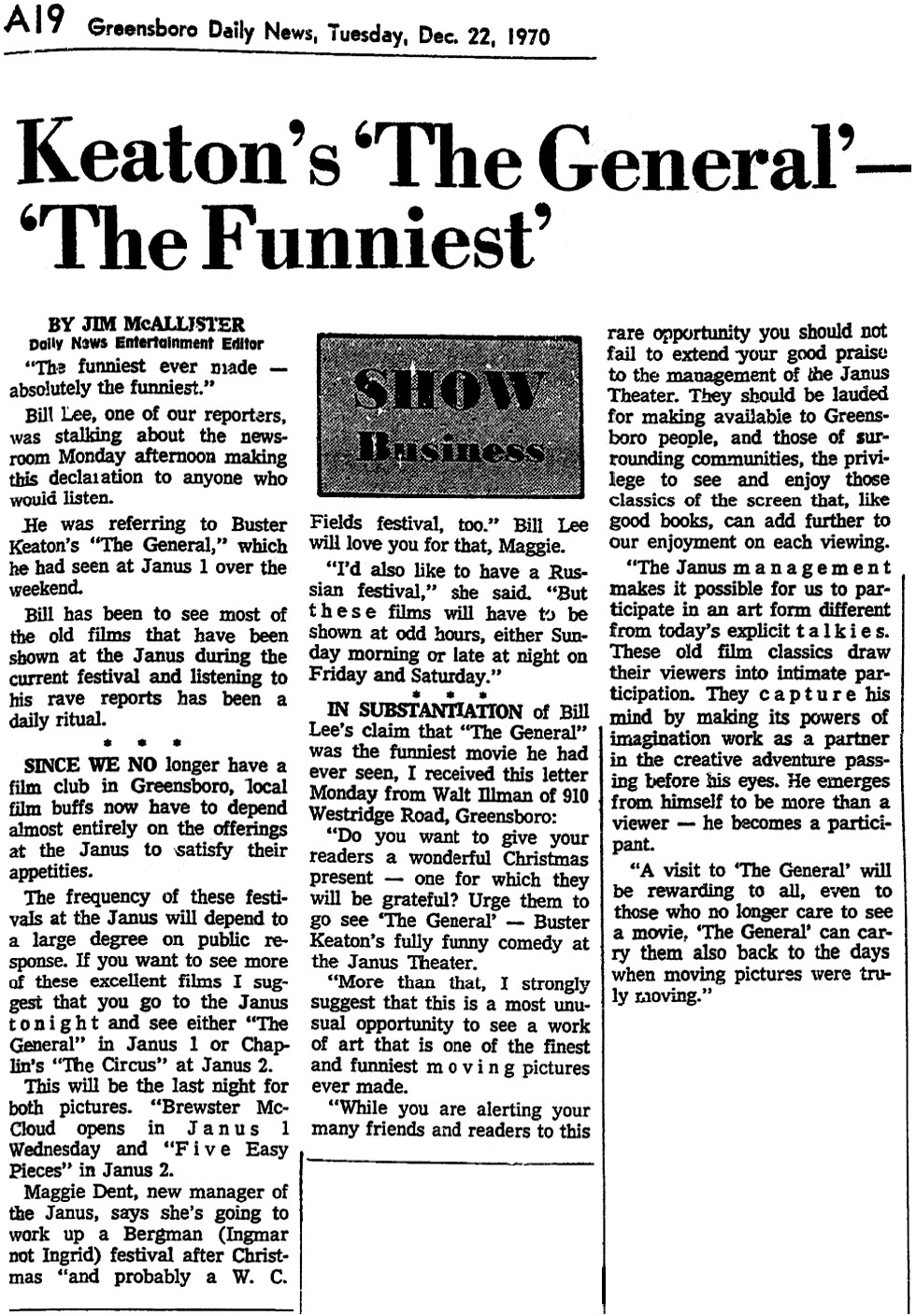
| |||||
| Fri 18 Dec 1970 | Salt Lake, UT | Capitol (Intermountain) | 7 days | PR, review | |
| Fri 18 Dec 1970 | Salt Lake, UT | Motor-Vu (Intermountain) | 7 days | ||
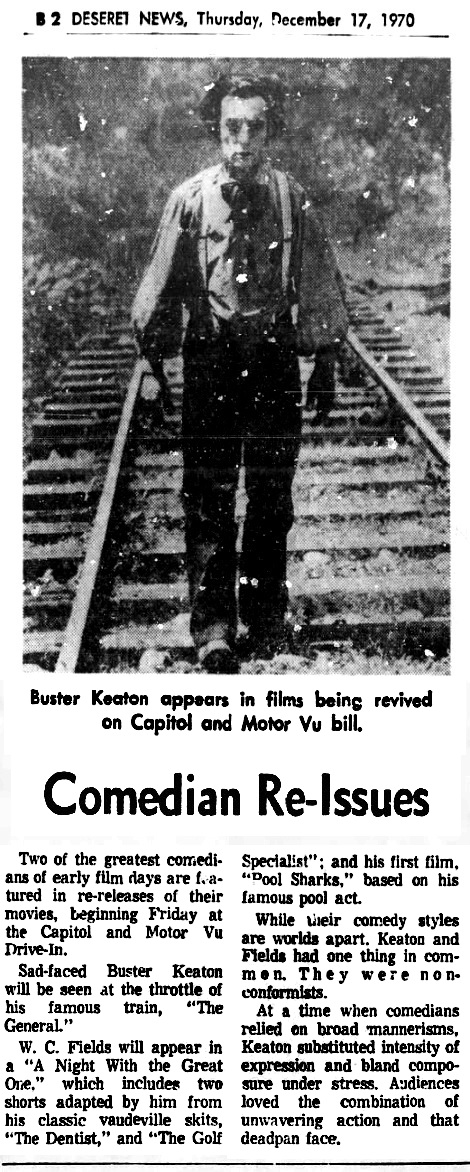
K27-90 | |||||
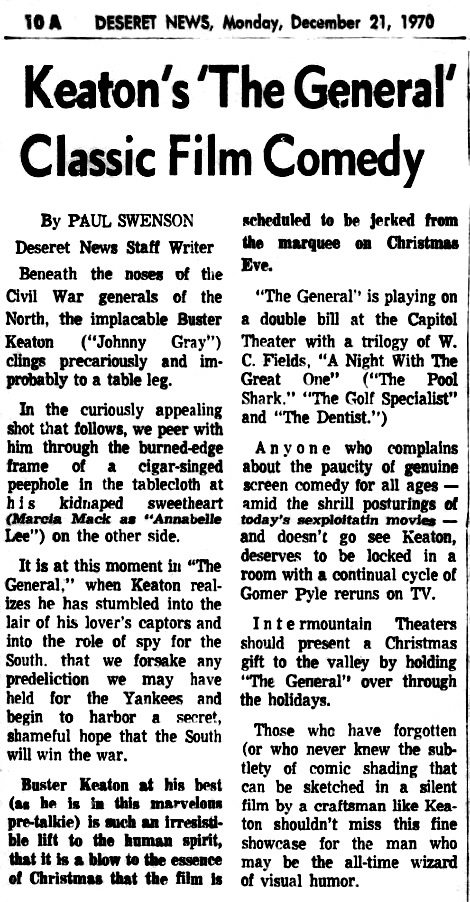
| |||||
| Wed 23 Dec 1970 | Baltimore, MD | Little (Trans-Lux) | 15 days | review | |
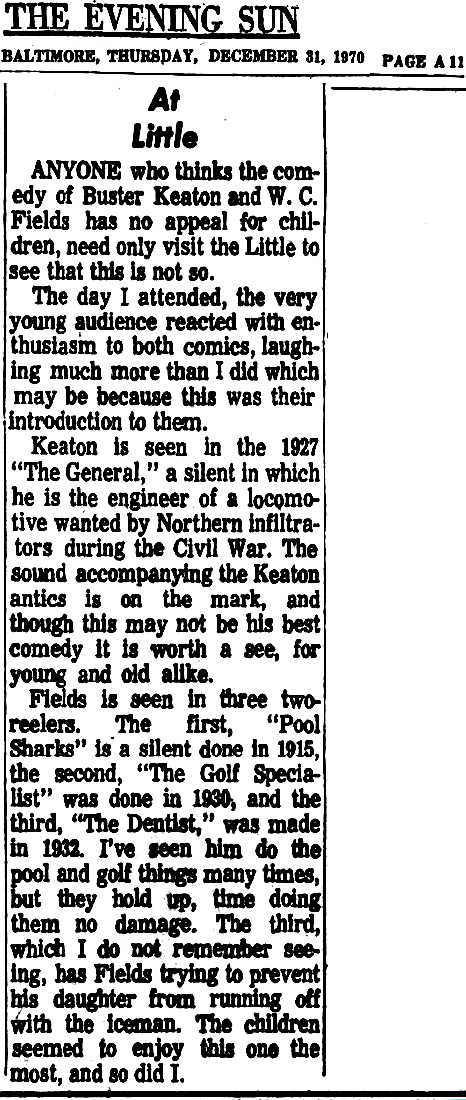
| |||||
| Wed 06 Jan 1971 | Winona, MN | Cinema (Indep.) | 7 days | ||
| Fri 08 Jan 1971 | Kansas City, MO | Ruskin 2 (Commonwealth) | 5 days | ||
| Wed 13 Jan 1971 | Palo Alto, CA | Paris | 51 days | ||
| Wed 20 Jan 1971 | Lawrence, KS | Hillcrest 3 (Commonwealth) | 7 days | PR | |
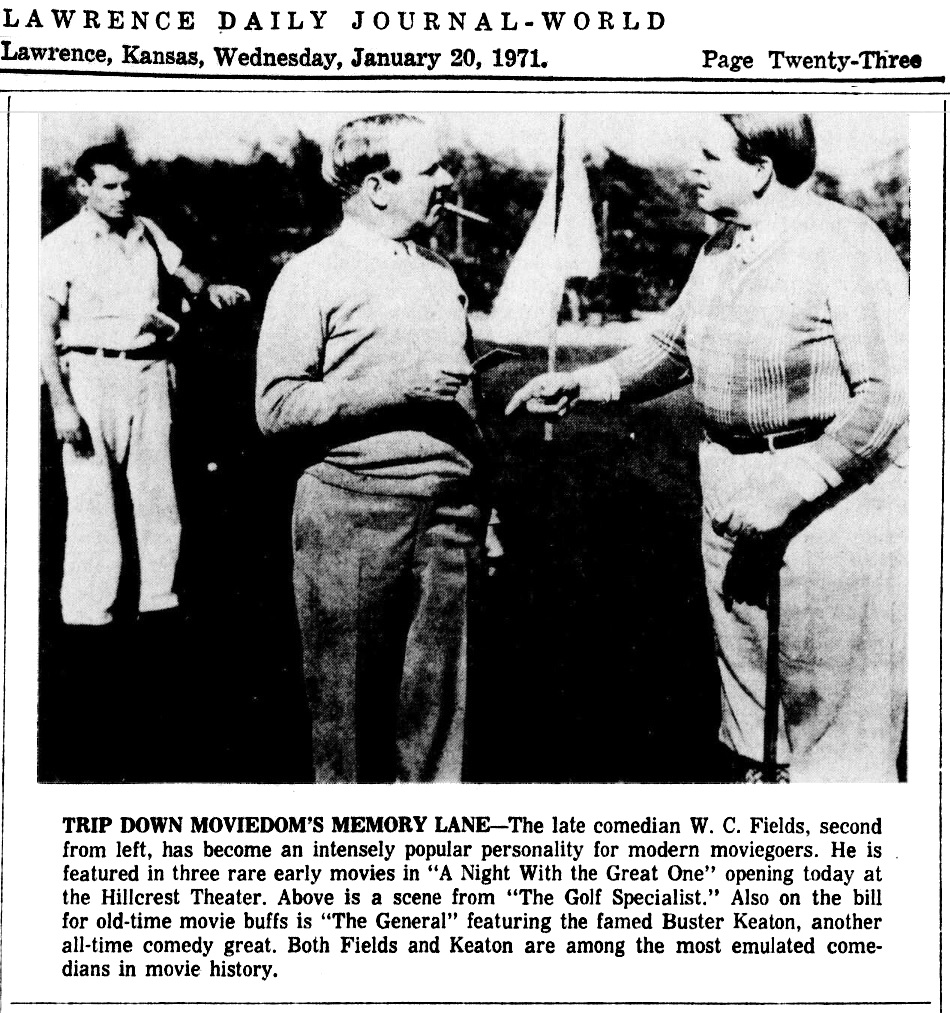
| |||||
| Thu 04 Feb 1971 | Danville, VA | Park Theatre (Indep.) | 3 days | ||
| Wed 10 Feb 1971 | Buffalo, NY | North Park (Dipson) | 7 days | review | |
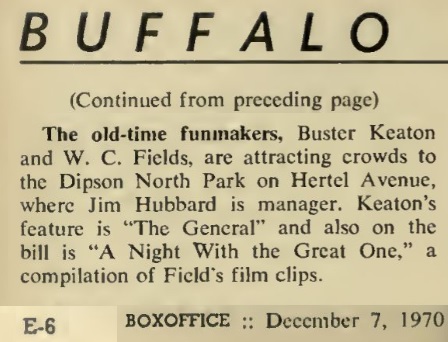 The above notice was a bit premature, yes? 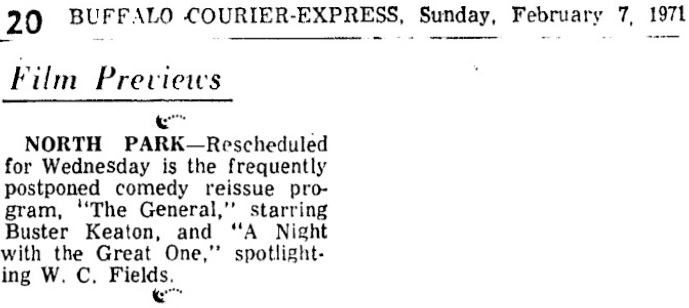 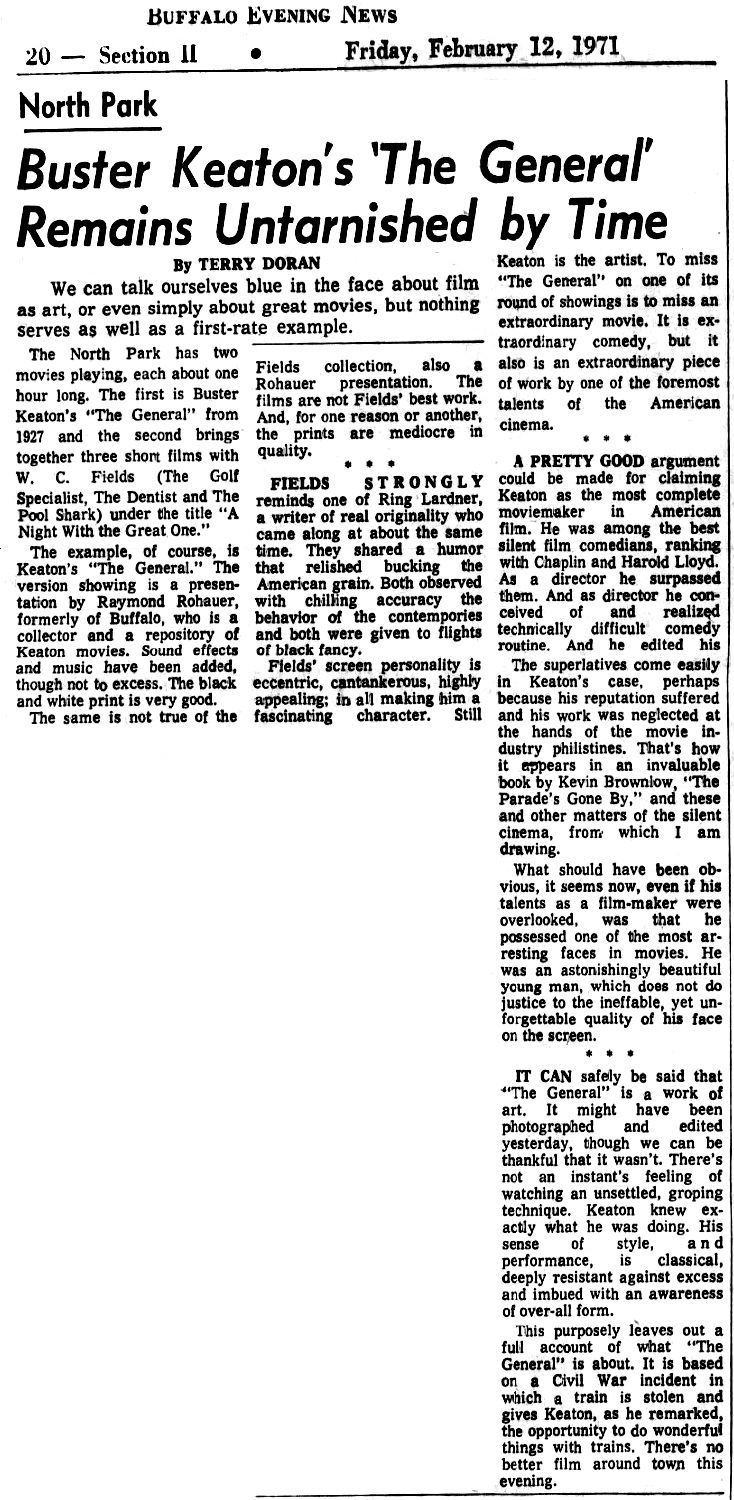
| |||||
| Wed 10 Feb 1971 | Burlingame, CA | Encore (Indep.) | 7 days | ||
| Wed 10 Feb 1971 | Fredonia, NY | Cinema 1 | 7 days | ||
| Thu 11 Feb 1971 | Dubuque, IA | Strand (Bradley) | 7 days | ||
| Wed 17 Feb 1971 | Carbondale, IL | Fox | 4 days | ||
| Thu 25 Feb 1971 | Woodstock, NY | Tinker Street Cinema (Indep.) | 6 days | ||
| Fri 02 Apr 1971 | St. Louis, MO | Magic Lantern Cinema (Indep.) | 5 days? | ||
| Fri 02 Apr 1971 | Springfield, IL | Roxy (Frisina?) | 6 days | press releases | |
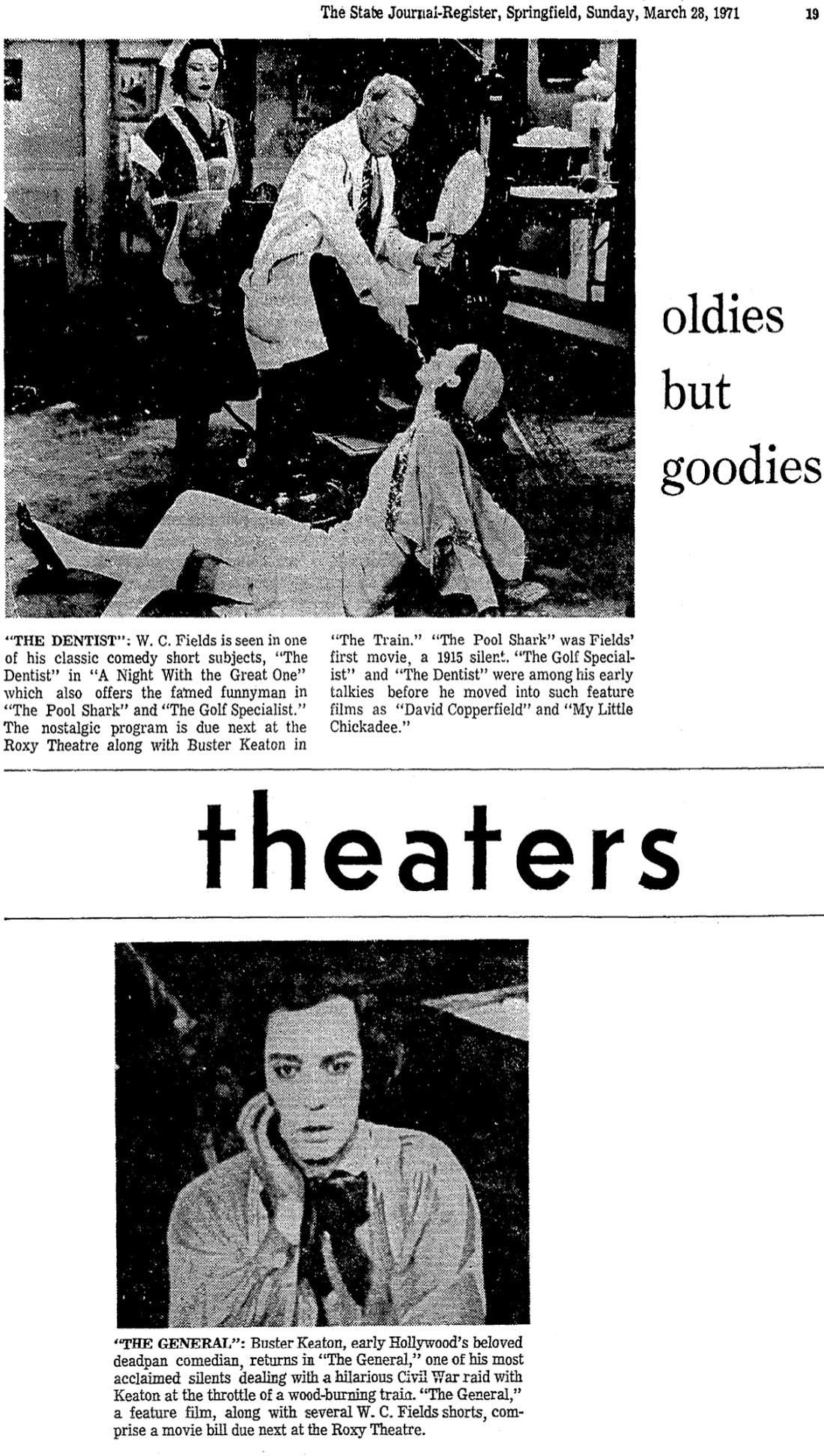
| |||||
| Wed 14 Apr 1971 | Oak Park, MI | Towne 1 | 7 days | ||
| Wed 21 Apr 1971 | Baltimore, MD | 7 East | 14 days | Boxoffice 03 May 1971 p. E-8 | |
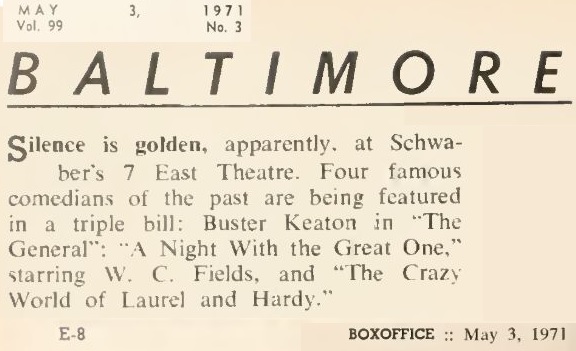 The Crazy World of Laurel & Hardy was also distributed by Joseph Brenner Associates, Inc. | |||||
| Wed 21 Apr 1971 | Pittsburgh, PA | Shadyside (Indep.) | 9 days | PR, review, review | |
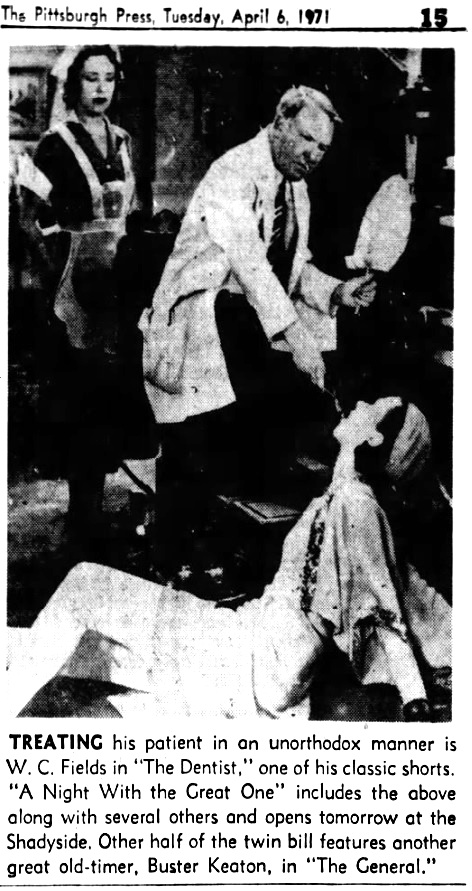
| |||||
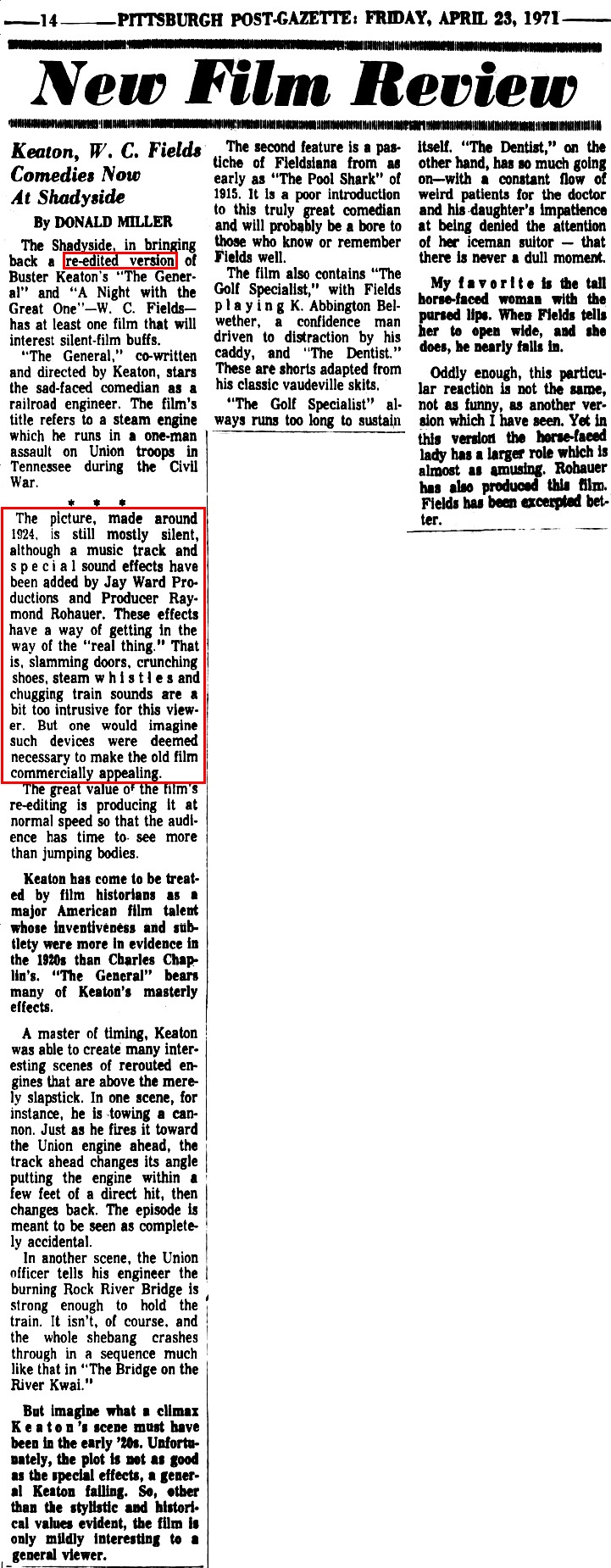
| |||||
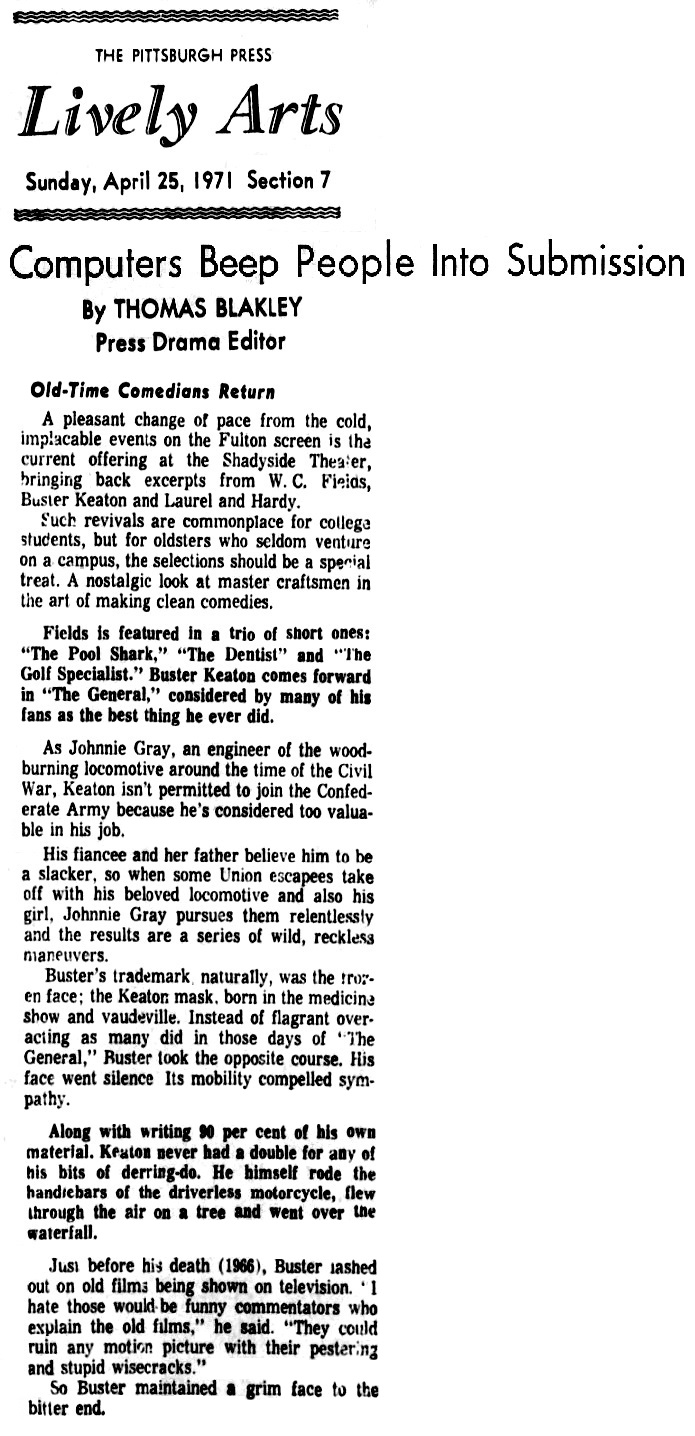
| |||||
| Wed 05 May 1971 | State College, PA | Cinema II (Associated Theatres) | 7 days | ||
| Wed 12 May 1971 | Minneapolis, MN | Varsity (Mann) | 7 days | ||
| Wed 12 May 1971 | Minneapolis, MN | Riverview (Volk) | 7 days | ||
| Wed 19 May 1971 | Sacramento, CA | Arden Fair 3 (Indep.) | 7 days | ||
| Fri 21 May 1971 | Ogden, UT | The Movie | 7 days | ||
| Fri 28 May 1971 | Seattle, WA | The Harvard Exit | 13 days | Booked 6 days, held over another week | |

| |||||
|
That was the last booking of “The Greats” that I can find anywhere.
Afterwards, The General was booked separately from A Night with the Great One,
but it was often doubled or tripled with other films, which were often also from the Rohauer or Jay Ward catalogues.
| |||||
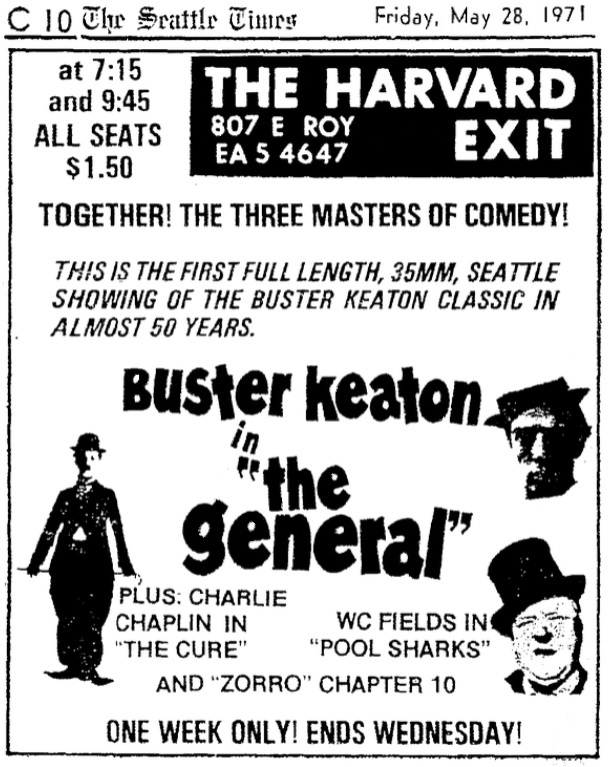 First time since January 1927, which was 44 years, not 50. | |||||
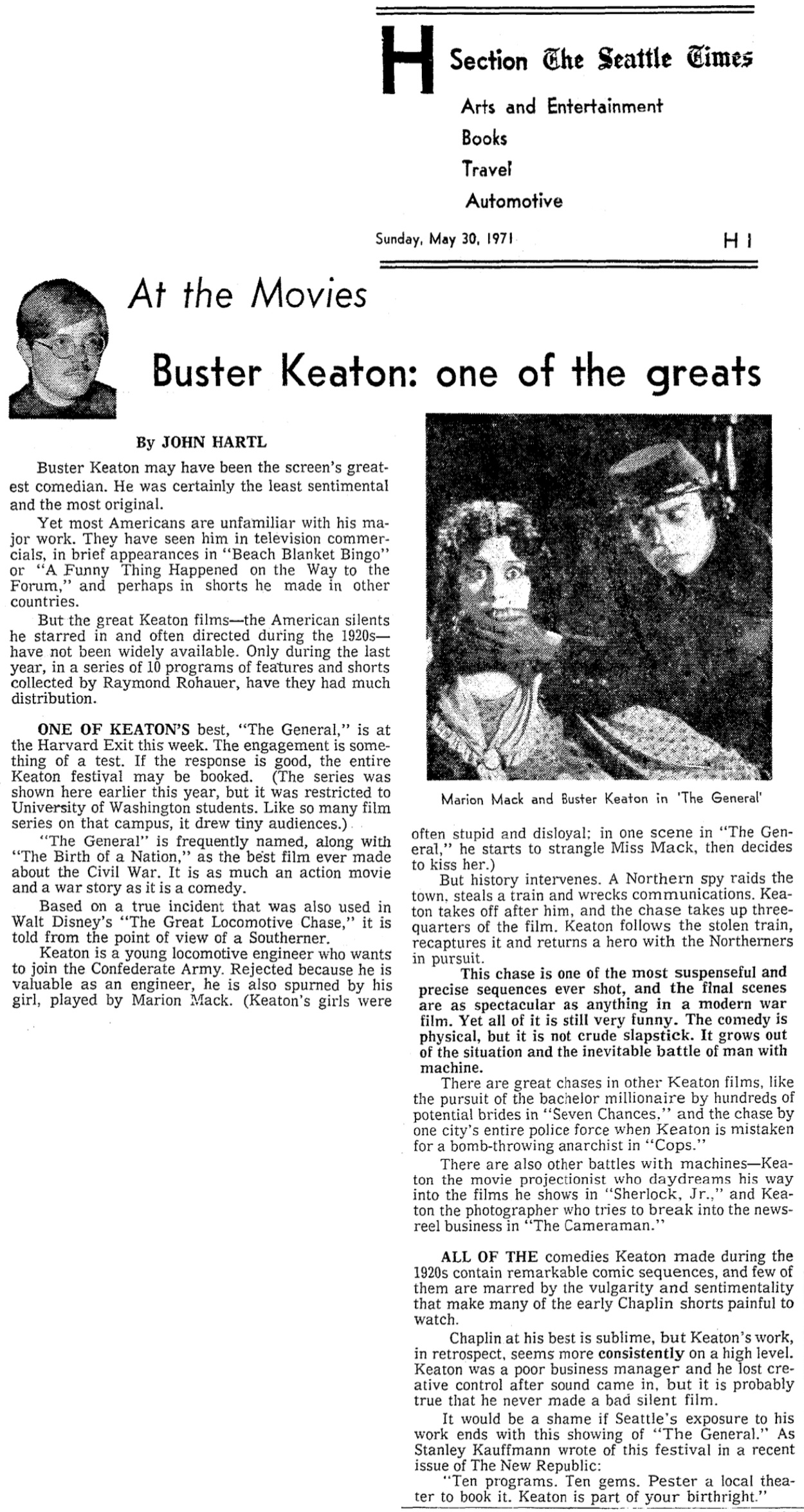
| |||||
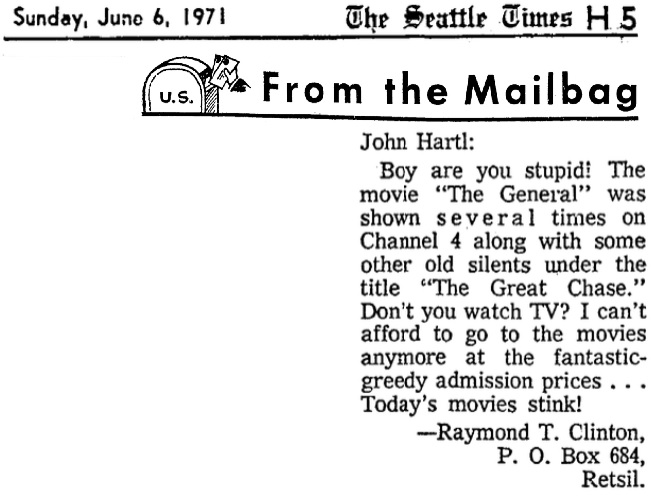
| |||||
| Fri 18 Jun 1971 | Wilmette, IL | Wilmette (Indep.) | 7 days | Boxoffice 21 Jun 1971 p. C-7 | |
| Thu 02 Nov 1972 | Richmond, VA | The Biograph | 3 days | ||
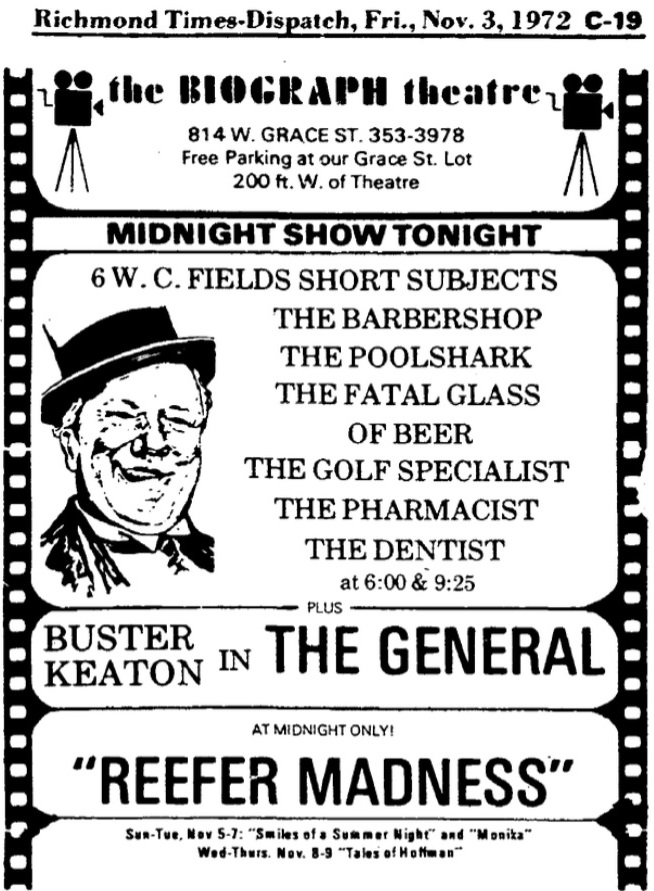
| |||||
| Wed 22 Nov 1972 | Seattle, WA | The Harvard Exit | 9 days | ||

| |||||
| Wed 22 Aug 1973 | Portland, OR | 5th Ave. Cinema | 14 days | ||

| |||||

| |||||
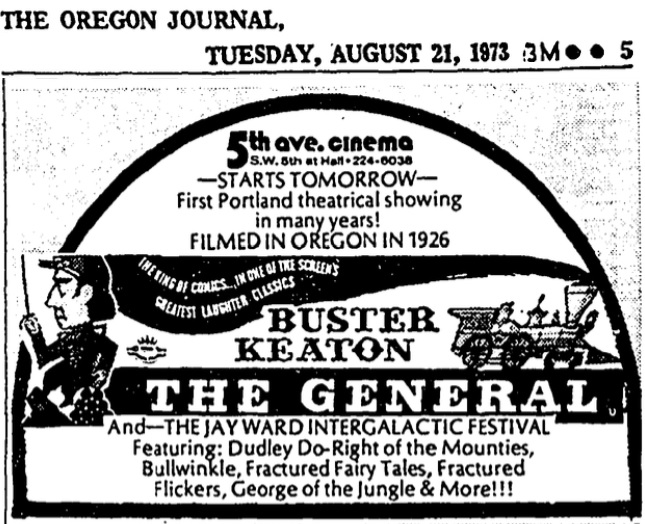
| |||||
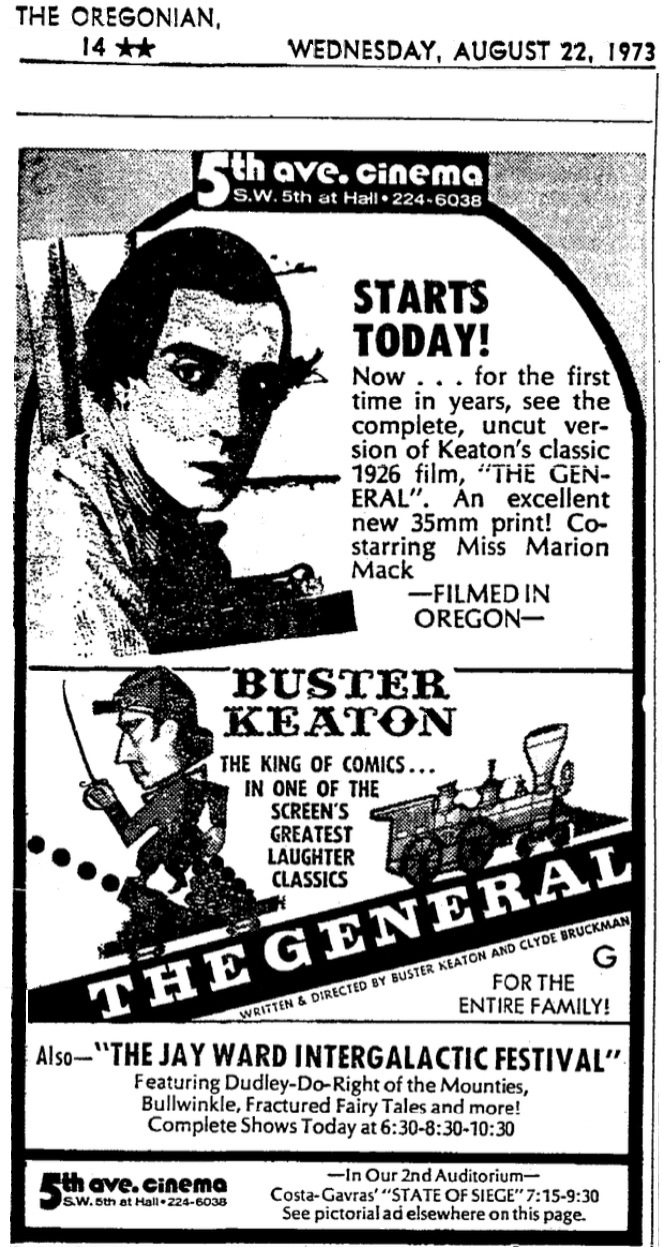
K27-96 | |||||
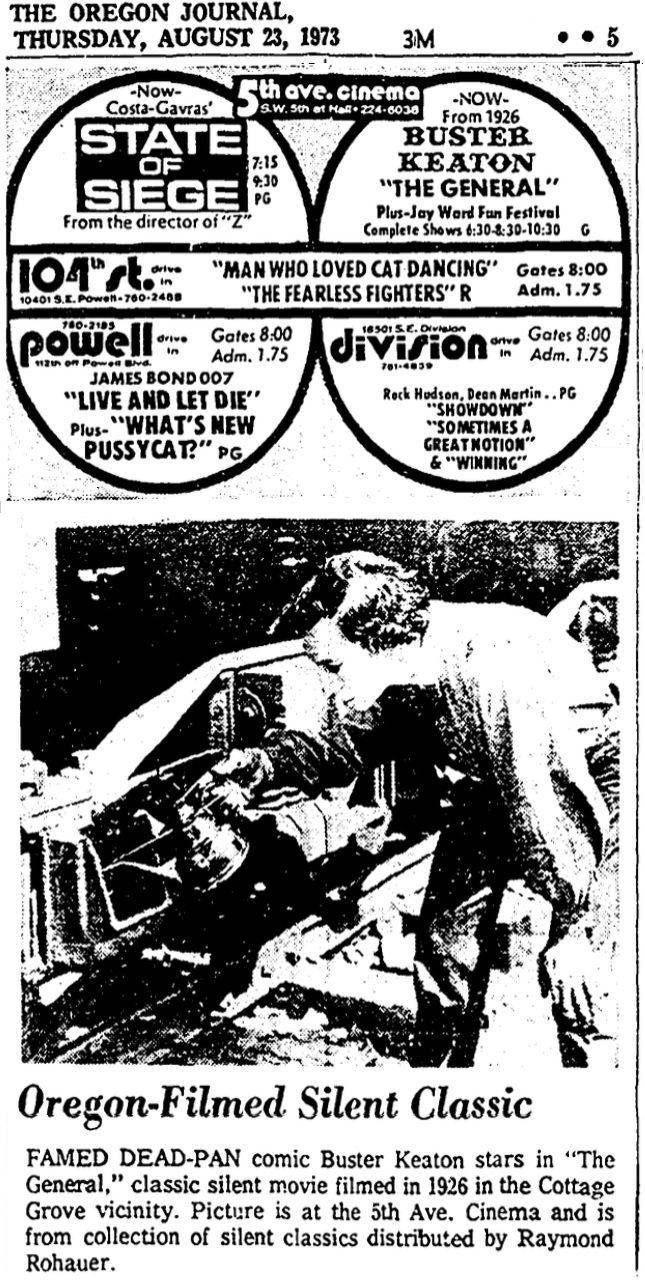
K27-204 | |||||

| |||||

| |||||
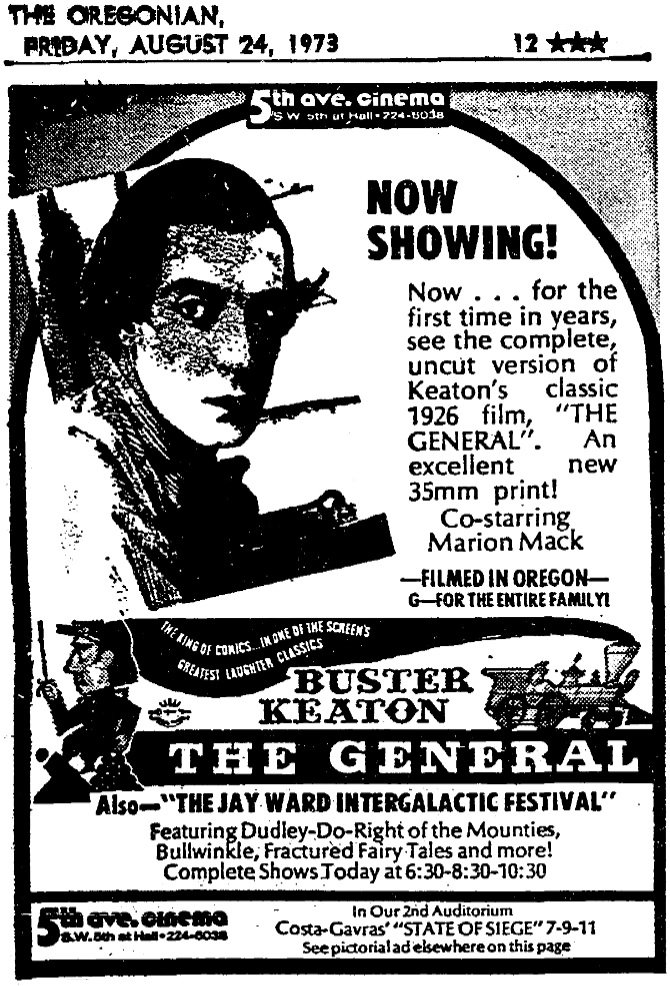
K27-96 | |||||

| |||||
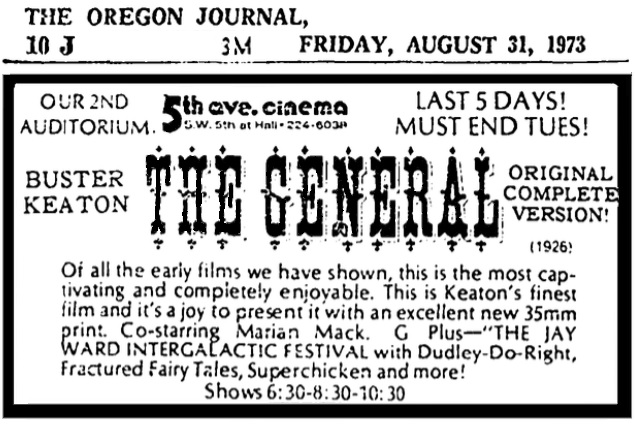
| |||||
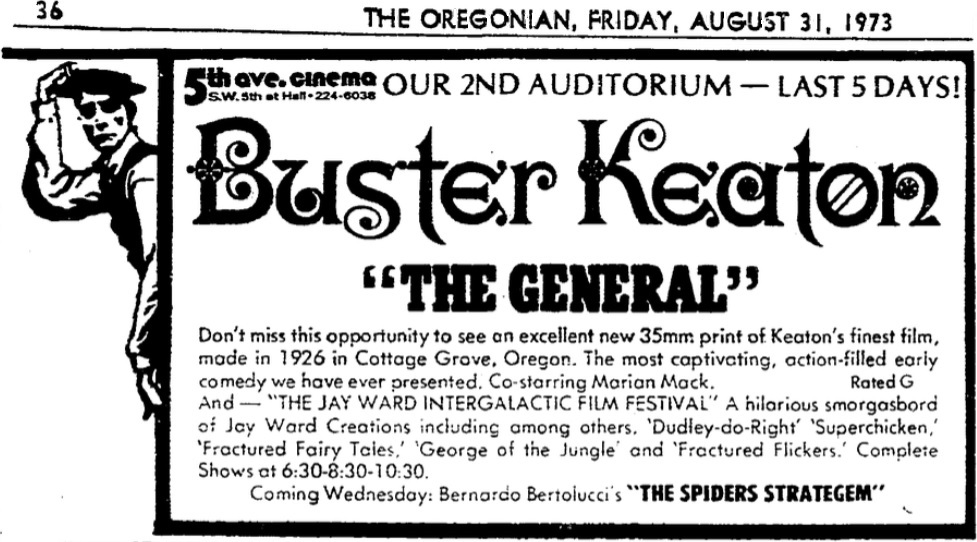
| |||||
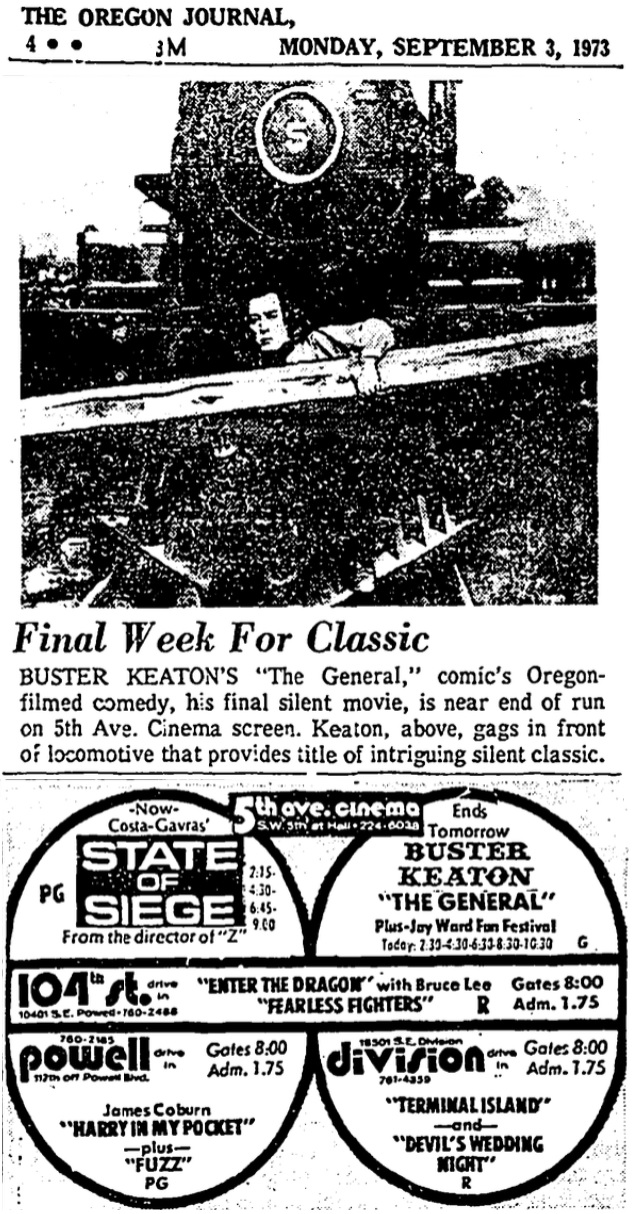
K27-168 | |||||
| Wed 10 Oct 1973 | Seattle, WA | The Harvard Exit | 7 days | ||
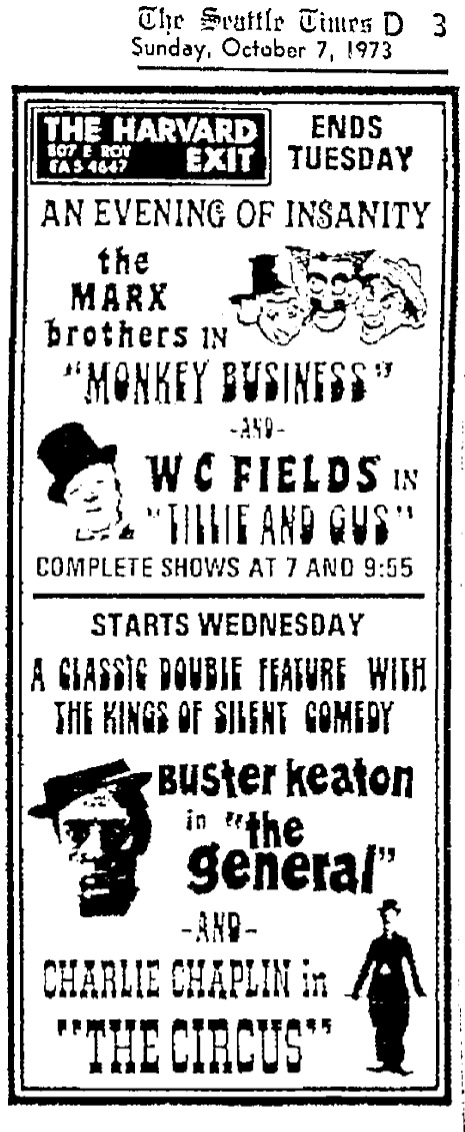
| |||||
| Thu 22 Aug 1974 | Greensboro, NC | Janus 2 | 2 days | ||

| |||||
|
That’s when it appears to have petered out.
|
|
Was it a coincidence that
MGM reissued The Cameraman in April 1968 and Spite Marriage not long afterwards?
Neither had been publicly available
since the 1930’s.
Rohauer had been coining an income with his traveling show.
Maybe it was time for MGM to jump onto the bandwagon?
The Cameraman, or what’s left of it, is really nice, but totally different from anything Buster had done before,
different in style, construction, humor, characterizations, and in every other way.
Watch it on TV, and it’s not so hot, and, actually, it’s pretty sappy.
Watch it with a thousand other people on the big screen with an orchestra accompanying, and it’s a laff riot.
Its Albuquerque première was at the Pastime in
|
|
As I play the
|
|
Jay Ward’s edition of The General made another appearance
as part of the Buster Keaton Festival at the Lincoln Plaza Cinema in NYC,
|
|
|
|
When I saw the Jay Ward version of The General,
it was not on the same program as the Fields shorts.
It was double billed with Sherlock Jr., the reformatted version with the jazz track.
|
|
Huh?
|
|
I don’t know.
I don’t understand, but I’ll try to do the best I can with my limited knowledge and my faulty memories.
|
|
Per contract, Buster chopped this movie down from six reels to five, each reel lasting about nine minutes.
So Buster’s original preview print was up to about nine minutes longer than the current versions.
Probably it was only about five minutes longer, really.
He shot with two and most likely three cameras side by side,
to create a domestic negative, an export negative, and an emergency backup.
|
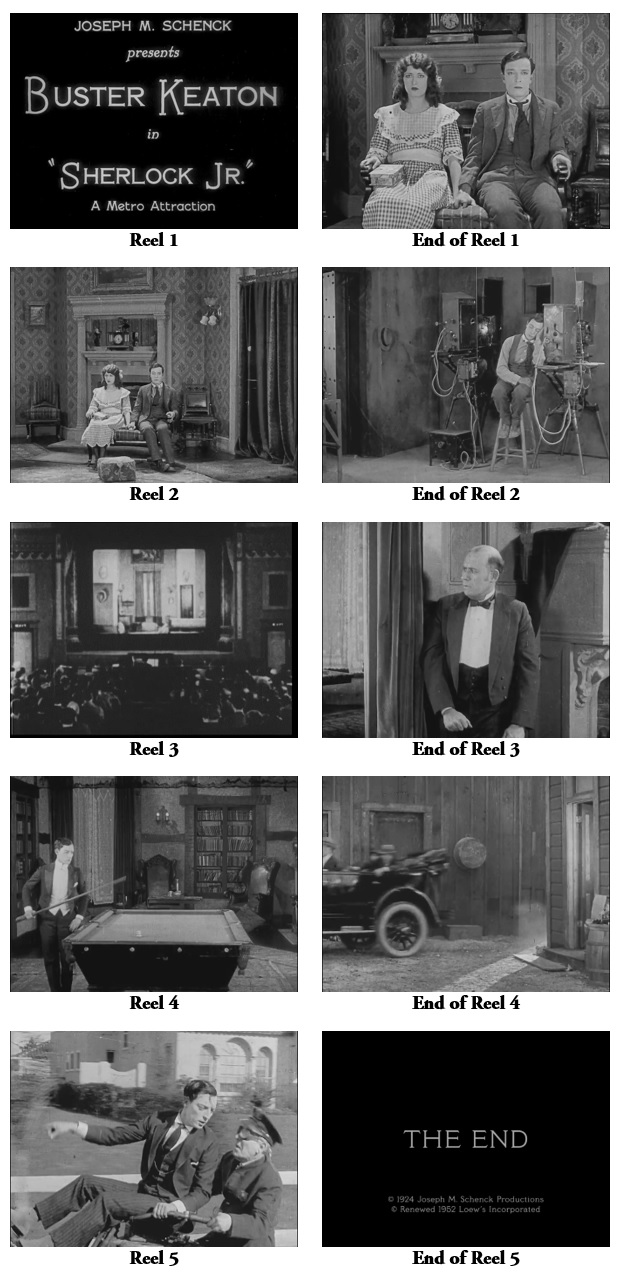
|
|
It was probably in about 1937 that MGM sold a lavender to MoMA,
and if people wanted to see the movie, MoMA was the only game in town.
|
|
In 1960, Ray Rohauer borrowed from the Academy of Motion Picture Arts and Sciences the nitrate
that James Mason had donated, and he made a dupe negative, but one reel was missing.
In all likelihood, Ray already had another print of the film in his
|
|
Rohauer presented his full collection of Buster flicks at the Venice Film Festival of 1963,
and he called his series “The Golden Years of Buster Keaton.”
This included Sherlock Jr., almost certainly an authentic edition,
|
|
He presented it a few times afterwards,
but by the time he unveiled it at the BFI National Film Theatre in London in January 1968
for a series called “The Films of Buster Keaton,”
he had probably altered the film,
adding spurious titles and making choppy edits.
|
|
It was probably in 1972 that Rohauer assigned Lee Erwin to record an improvised score to the film.
He had the film lab optically reduce the image to the Academy format and mixed in Erwin’s music.
For this edition, the spurious titles were not included,
but it was almost certainly at this time that all the genuine titles were reset and most were rewritten.
This was a
|
|
Then we get to 1975.
|
|
Sherlock Jr. was Bill and Skip’s followup to The General.
Well, I presume it was Bill and Skip who worked on this,
for the simple reason that can be summarized with a rhetorical question:
Who else would have?
They used extremely fine materials (including MoMA’s lavender?).
Well, yes, extremely fine, but there were scratches everywhere.
Not enough scratches to spoil the viewing experience or to compromise one’s enjoyment of the show,
but, yes, there were lots of scratches everywhere.
Still, though, the image was very clear and the detail in the images was remarkable.
The Jay Ward crew instructed the lab to reduce the
|
|
How on earth can we compare the MoMA edition
against Rohauer’s 1963 print and his 1968 print and his 1972 print and Jay Ward’s 1975 edition?
|
|
Well, lo and behold, I just stumbled upon a mention of an episode of “Camera Three” entitled
The Metaphysics of Buster Keaton, a little presentation by Professor Andrew Sarris,
who spent a few minutes allowing Raymond Rohauer to spout a pack of lies.
This was broadcast on Sunday morning, 1 November 1970.
For our purposes, Sarris doesn’t matter,
and for our purposes, Rohauer doesn’t matter.
Please click on that link and take a look at the program.
It includes an excerpt from Rohauer’s 1968 edition of Sherlock Jr.,
cropped, of course, since TV stations were unable to accommodate
|
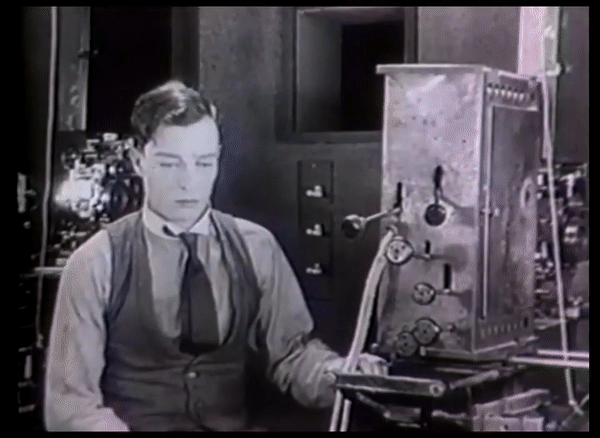 1968 ROHAUER EDITION Here we have a typical example of the needless titles that Rohauer so commonly added to the movies he released. |
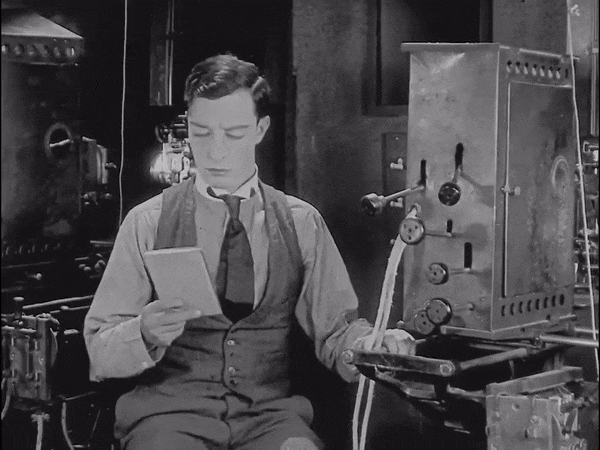 1975 JAY WARD EDITION The original, which did not have any titles here. Note that the top of the image is missing. I don’t think that’s a fault with the film-to-video scan. I think it’s a fault with film print, which was wrongly cropped when it was optically reduced to the Academy format. |
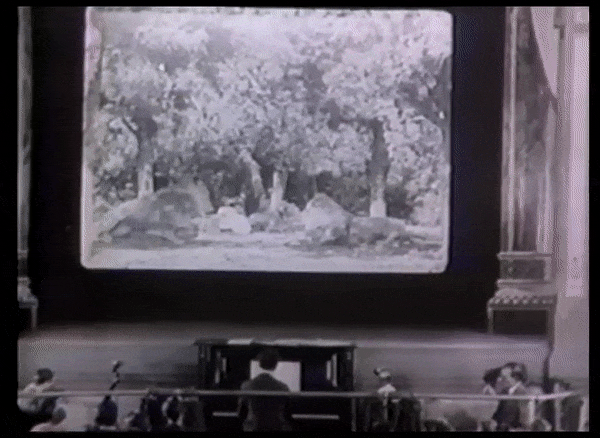 1968 ROHAUER EDITION Note that the action on the inner screen is from a single camera. You will see a jump in the position of the image. That indicates where different fragments of different copies of the movie were pieced together. |
 1975 JAY WARD EDITION Note the jump in the perspective, where the camera is suddenly positioned differently. Apparently, for this scene only, the Jay Ward edition starts with Camera A but cuts to Camera B, or the other way around. |
In both of the latter clips, both |
|
|
The
|
|
Here are a few details that will fascinate one person in every 768,431,
and that will make everybody else lose all patience with me and refuse to speak with me ever again.
In common with Jay Ward’s 1975 edition, Rohauer’s 1968 and 1972 editions were missing the opening of the scene
when Buster’s dreamself walked into the auditorium.
That was the scene that opened Reel 3,
and so we can suppose that someone simply shattered the beginning of the reel prior to the new prints being made.
Rohauer’s 1981 edition was missing a trick shot at the billiard table.
Was that also missing in his 1972 edition?
Since both were scored by Lee Erwin, we might think they were identical,
but we learned from the 1972 versus the 1979 edition of The General
that Rohauer did not simply port over Erwin’s score.
He paid Erwin to record a new score.
I suppose the same held true with Sherlock Jr.
Though the 1972 edition and the 1981 edition both sport a score by Erwin,
the likelihood is that Erwin recorded his score anew for the 1981 edition.
So, the 1972 edition could well have included that nice trick billiard shot that was missing from the 1981 edition.
Was that moment also missing from the 1963 and 1968 editions?
I bet it was there, but until I can find the prints or verified copies thereof, I cannot say that with certainty.
I suppose it is included in the MoMA edition, but I really don’t know.
It was in Jay Ward’s 1975 edition,
but Rohauer deleted it by 1977 and remixed the soundtrack to cover the gap.
|
|
Daniel Moews, “Chapter 4: Sherlock Junior: The Fantasizing of Reality,”
Keaton: The Silent Features Close Up
(Berkeley, Los Ángeles, London: University of California Press, 1977), p. 86:
...the boy starts projecting
the afternoon’s film, Hearts and Pearls or The Lounge Lizard’s Lost
Love. Possibly because it is a Veronal Pictures production, Veronal
being a popular but dangerous soporific of the period (two younger
sisters of the novelist Ivy Compton-Burnett committed suicide by
taking overdoses), he soon tires of it and yawns. A title states, “A
projectionist’s job is tedious . . . and the monotony makes him fall
asleep.” Soon, “he dreams.”
|
|
Daniel Moews, “Bibliographical and Filmographical Comments,”
Keaton: The Silent Features Close Up (Berkeley,
Los Ángeles, London: University of California Press, 1977), pp. 327–328:
In a
The criminals having been disposed of with a grenade, Sherlock
Junior and the girl continue to race along in their car. Then she says,
in a title, “Oh, we forgot Gillette. Shouldn’t we go back for him?”
In the Audio-Brandon print, there follows some awkwardly edited
action. In the shot immediately after the title, Sherlock continues to
drive. There is then a cut to a new shot as he approaches a curve and
slams on his brakes. The awkwardness is caused by a visual
ambiguity in the action, an uncertainty whether his slamming on the
brakes is a response to the girl’s question and signals an intention to
turn around, or whether he has ignored her and is simply responding
to the curve. Since the car chassis detaches and flies over the curve
and into the water, the uncertainty is quickly obliterated in laughter.
In the
My opinion about such editing as this is mixed. Since it may have
been recently done, after Keaton’s death, it could be considered a
violation of the integrity of his work. But then, it also seems reasonable.
The cuts were minimal, discreet, and sensibly managed; the
awkward action described might have resulted from damage to whatever
surviving print lies behind present ones rather than from original
intention; and with the titles removed, the film does have a more
modern and therefore more accessible look to it, even a more Keatonesque
look (critics, including this one, have perhaps too often
applauded Keaton’s ability to construct long action sequences that
need and use no titles). The editing could also be compared to the
handling of an early book in which dated spelling and punctuation
(and also occasional misprints) are apt to be silently changed by
modern editors to conform to present usage. And if such changes help
preserve the film as a viable one, one that is more likely to be
accepted, watched, and enjoyed by present-day audiences, they are
to be encouraged. But then again, part of the charm of Sherlock
Junior, it seems to me, is its deliberately casual, deliberately primitive
look. To
|
|
We have that single clip from the 1968 edition,
and we can see, obviously, that the two extra titles are Rohauer extras, not part of the original film.
Not only are they needless and in a different font,
they are not in a dialect that Buster would have used:
“projectionist” would have been “operator”;
“tedious” would have been “dull,” maybe;
“monotony” he would not have used at all;
“fall asleep” would have been “dreamed”;
but really now, Buster would never have inserted such pointless titles.
They do nothing to help; rather, they hinder the action, which is quite clear without words.
Besides, note that in the Jay Ward edition, there are no splices
where the titles were inserted in the earlier Rohauer edition.
That’s the dead giveaway that the titles were not in the original 1924 edition of the film.
|
|
The clumsy and primitive editing is not something I have had an opportunity to witness,
since Rohauer’s 1963 and 1968 editions have vanished,
but my educated guess is that the
“casual jump cuts and raggedly joined pieces of action”
were also the work of The Raymond Himself and were not leftovers from the original film.
Extra frames during those rought spots?
I doubt it.
If there are any extra frames in Rohauer’s 1968 edition,
it is highly unlikely that they might be ragged cuts where Buster removed sequences from his workprint.
If they are, then it would be invaluable to locate this edition
so that we can study the small remains of what Buster deleted.
My educated guess, though, is that Buster never made ragged cuts, not even to workprints.
What I would really love to get, though, is something nobody will ever find, because it was destroyed a century ago;
namely, the first preview print.
|
|
Now we can begin to understand what happened. In
1973,
Randy
Finley founded a new, short-lived company, The Film Group,
soon renamed Specialty Films.
It was Randy who had been negotiating with the Doyle estate for several years
to license The Hound of the Baskervilles,
and when all was agreed, the film proved to be unusable.
The negative had vanished and the several surviving prints were fragmentary.
They had to be pieced back together.
When the jigsaw puzzle was reassembled and when the rights were cleared,
Randy opened it at his Guild 45th in Seattle on Thursday, 15 May 1975,
where it ran eight weeks, accompanied by a 1927 Fox Movietone
|
|
Then the Sherlock Holmes Society of Portland presented a
benefit screening of The Hound of the Baskervilles
at Randy’s cinema, The Movie House, on
Sunday, 1 June 1975.
The beneficiary was the Burnside Community Council.
The film, together with the Movietone reel and the BK featurette, began its regular commercial run on
Thursday, 12 June 1975.
|
|
Randy offered these three items as a single program.
Randy was, I suppose, the one who commissioned Jay Ward Productions to update Sherlock Jr.
only so that it could be combined with these reissues.
The material that Jay Ward used was not the same as the material that Rohauer was presenting at his touring shows
and occasionally renting out to cinemas and classrooms.
Whatever it was that the Jay Ward people used was different from that.
Was it another copy that Rohauer somehow found somewhere and deposited with Ward?
Or was it, perhaps, yet another print that was not in Rohauer’s collection at all?
For reasons that I cannot even imagine,
Jay Ward and his crew got no credit at all on Sherlock Jr.,
though print ads revealed,
“By special arrangement with Raymond Rohauer” —
or Ruhauer as one misspelled ad proclaimed.
Oddly, not even
|
|
Randy ordered 28 prints.
After his Seattle and Portland bookings at his own cinemas, he began to offer the package to other houses.
Some cinemas did not book the full program, but only one or two pieces of it.
Here’s what I can find:
|
| Thu 15 May 1975 | Seattle, WA | Guild 45th | 56 days | doubled with BK Festival | |
 | |||||
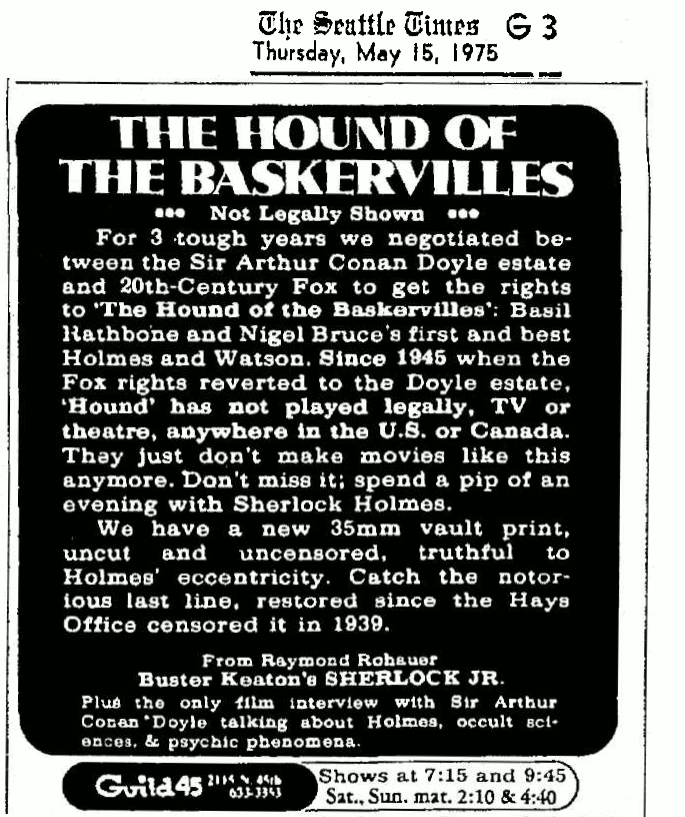 | |||||

| |||||
| Thu 12 Jun 1975 | Portland, OR | Movie House Theatre | 13 days | ||
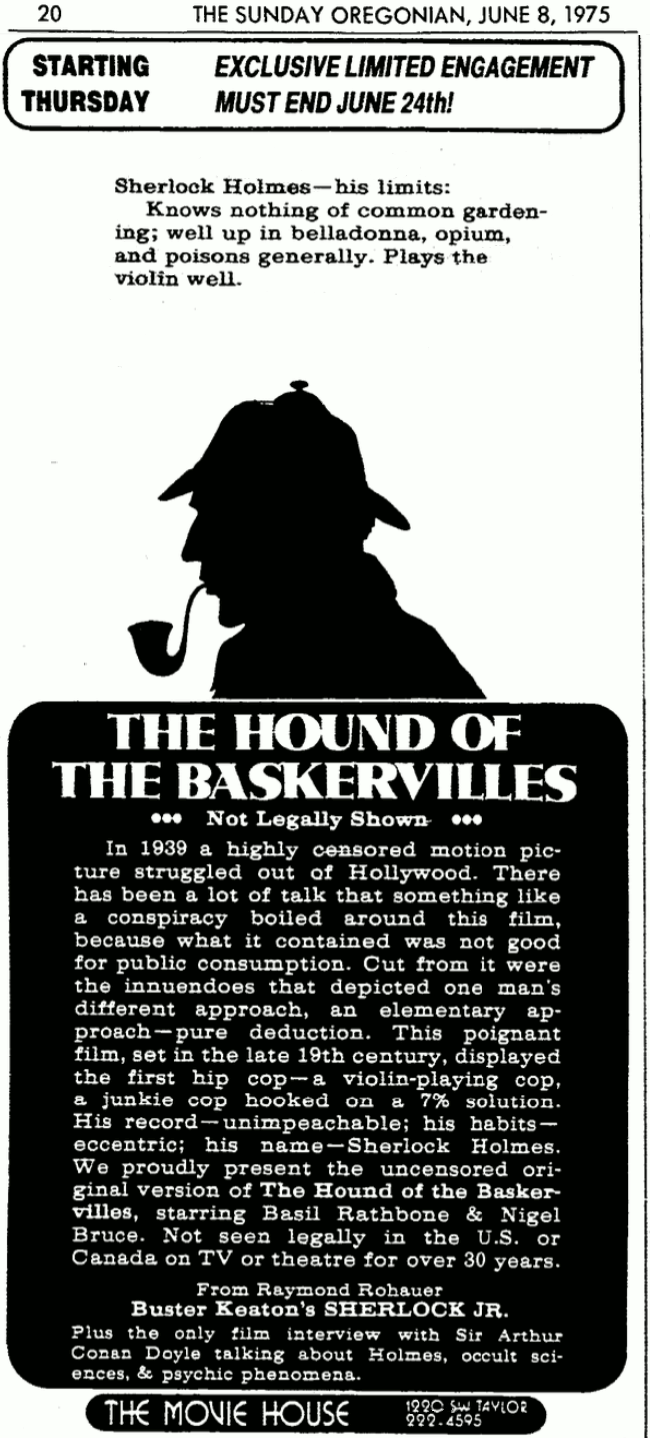 | |||||
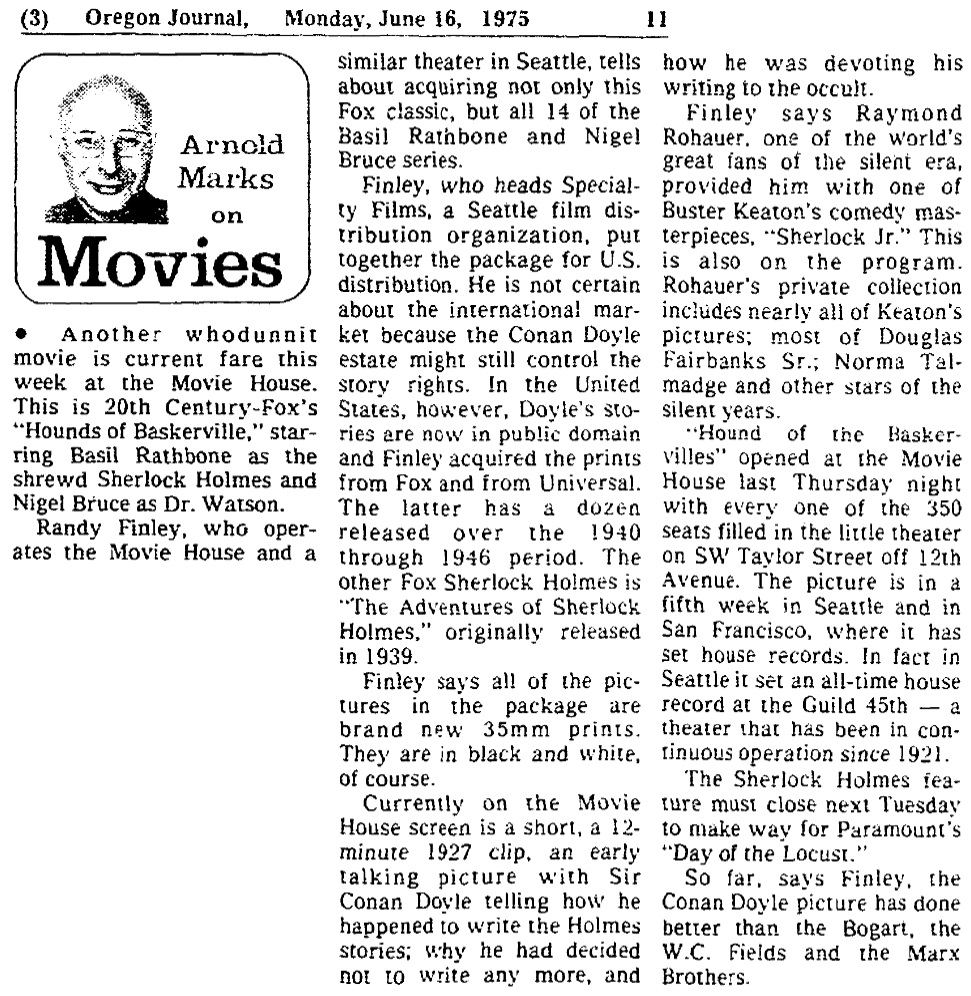 | |||||
| Wed 25 Jun 1975 | Berkeley, CA | United Artists Cinema 3 | 7 days | ||
| Wed 01 Jul 1975 | Beverly Hills, CA | Music Hall | 35 days | ||
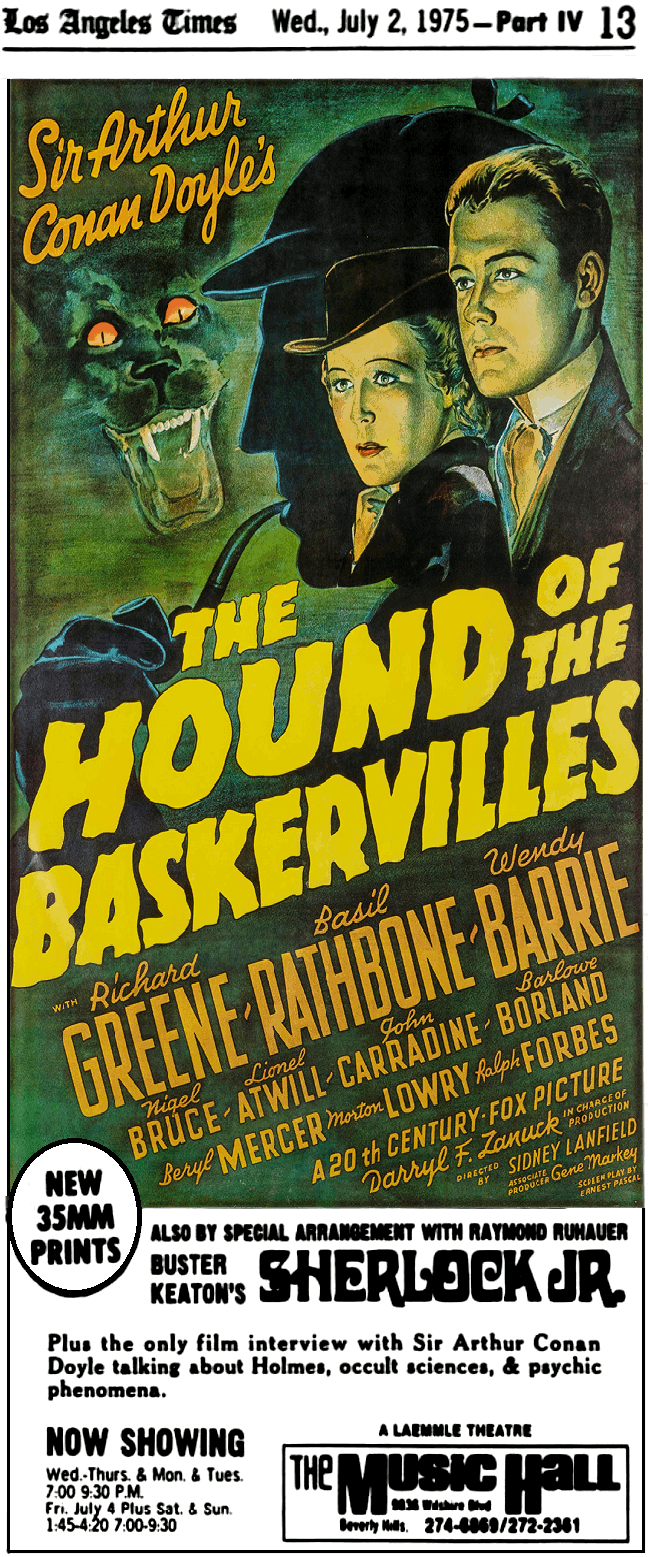
| |||||
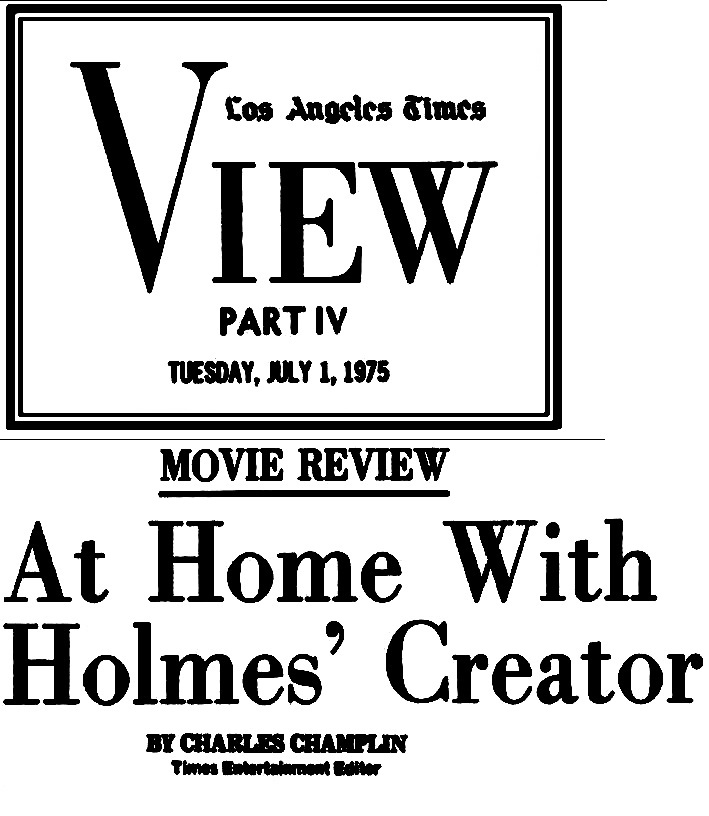 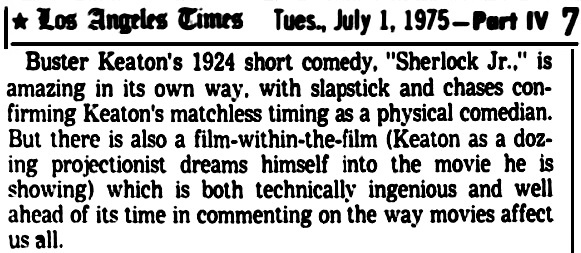
| |||||
| Wed 09 Jul 1975 | Minneapolis, MN | St. Louis Park | 28 days | review | |
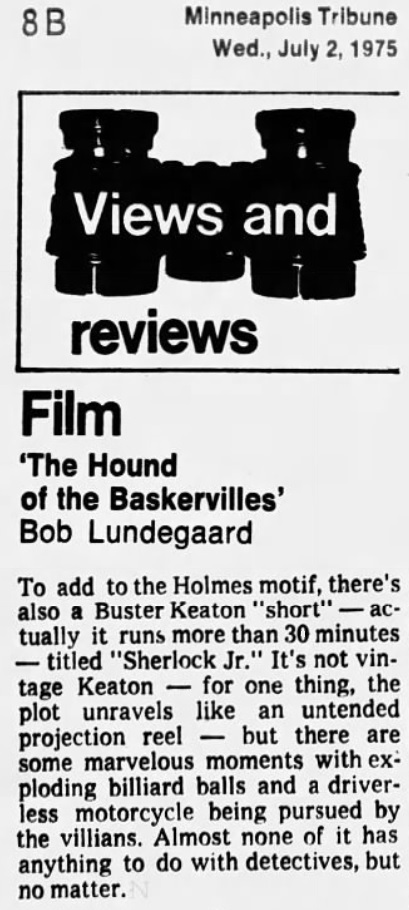 | |||||
| Thu 17 Jul 1975 | Manhattan NY | D.W. Griffith | 14 days | ||
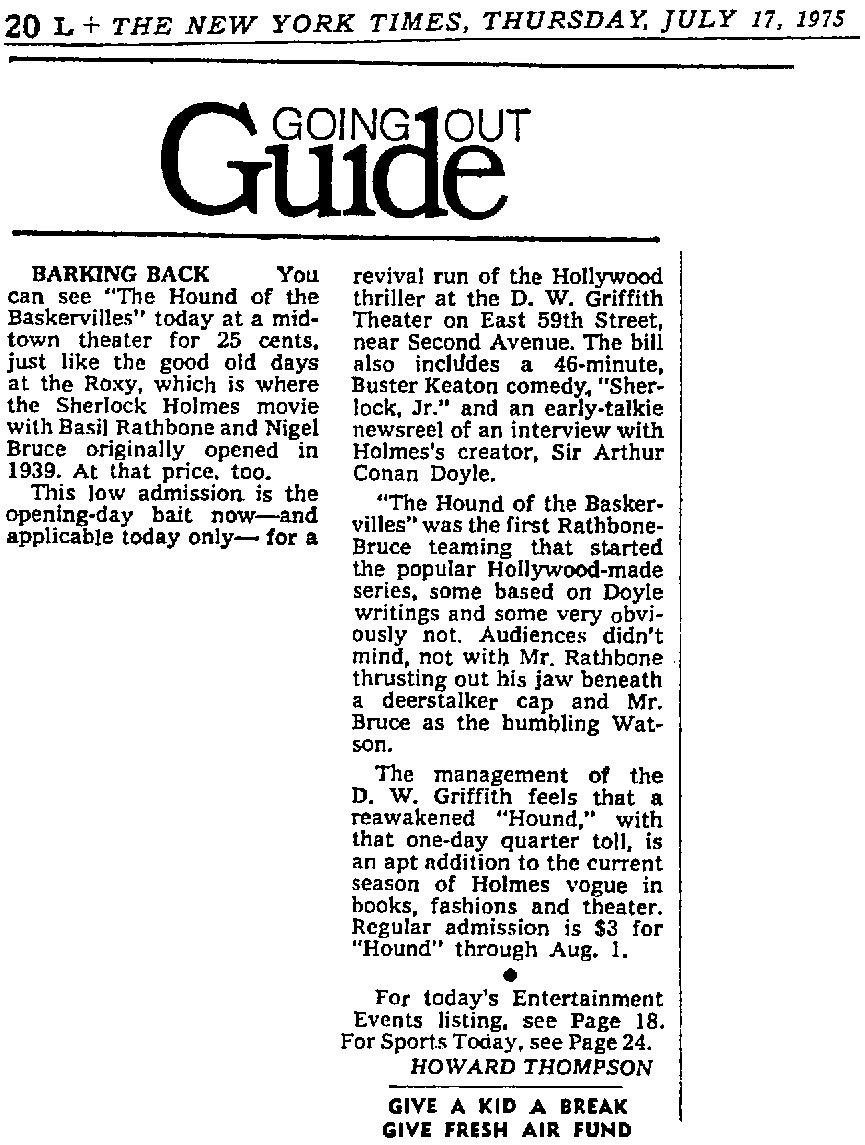 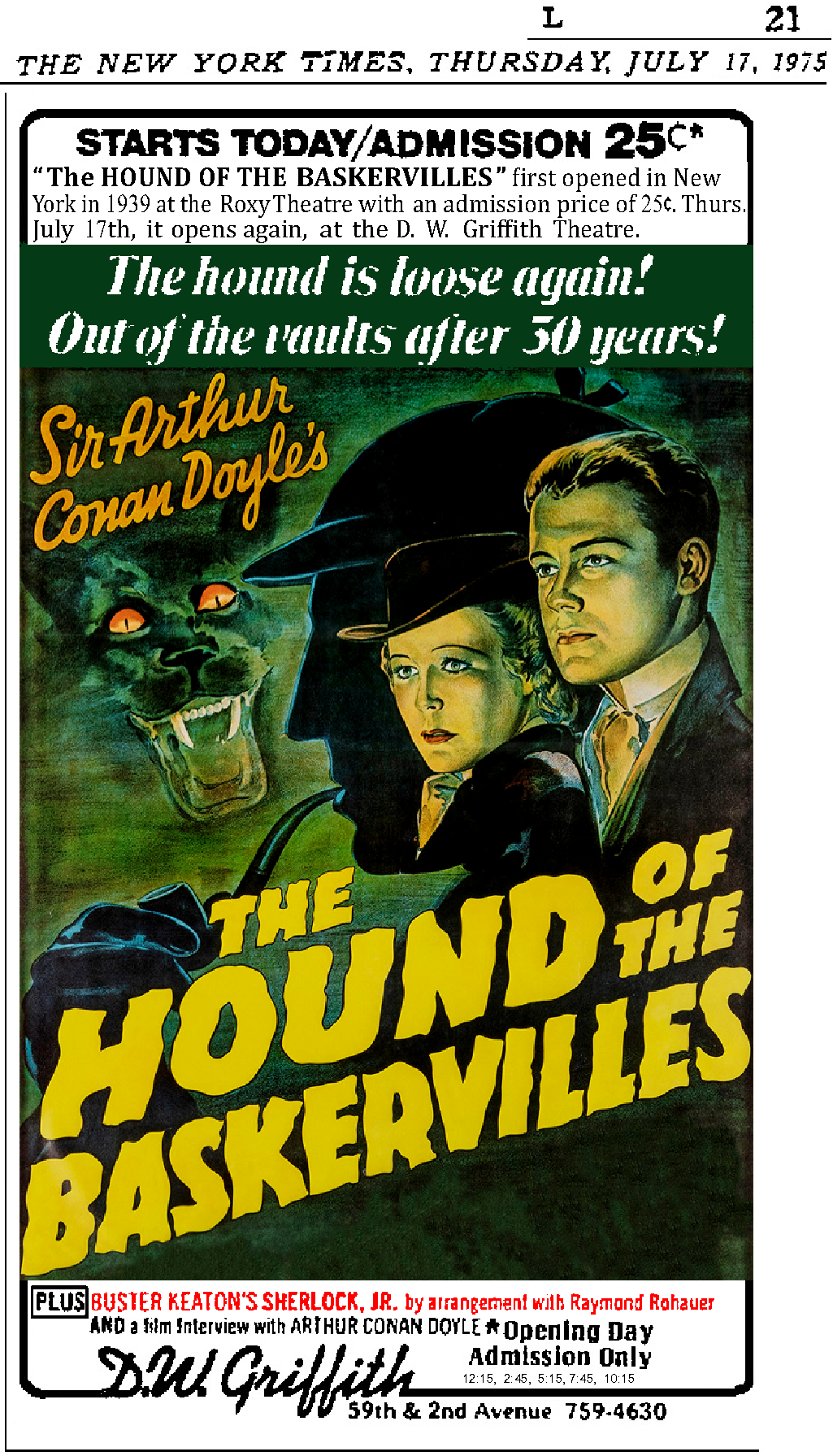 
Don McGregor in his booklet, Buster: The Early Years, tells of his own conversion at the opening-day screening,
though he gets the date off by a year:
| |||||
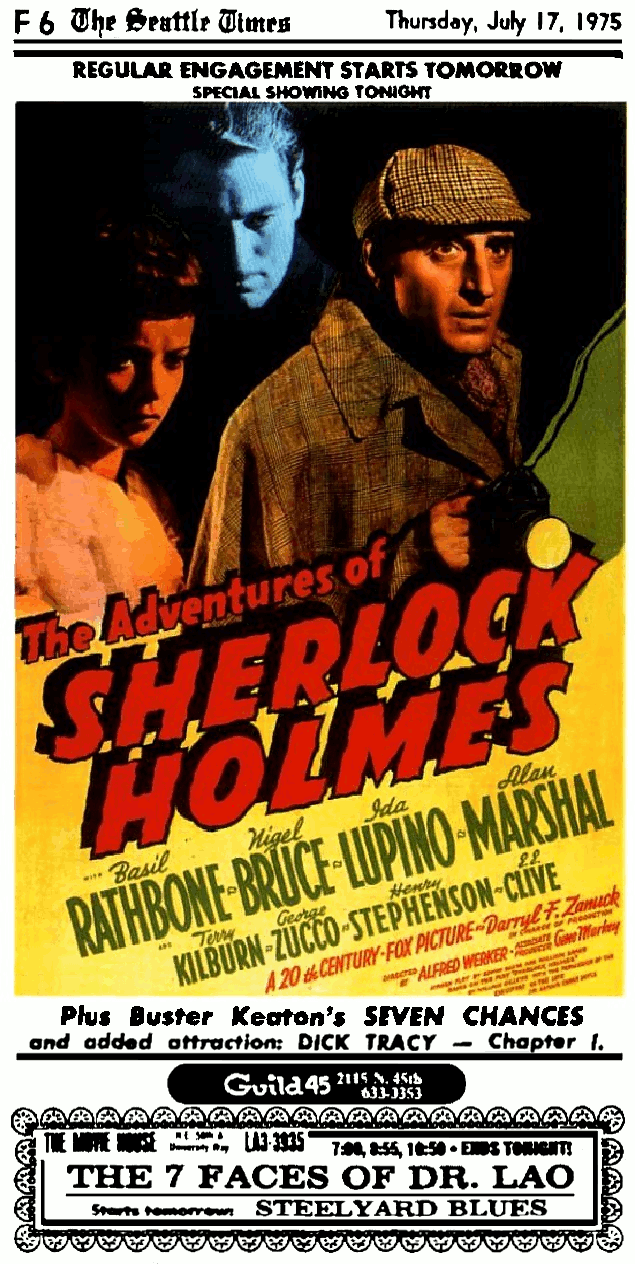 ¿Interesting, que no? Ran through Wednesday, 6 August 1975 | |||||
| Wed 23 Jul 1975 | San Francisco, CA | Metro II | 7 days | ||
| Wed 23 Jul 1975 | Portland, OR | The Guild | 8 days | ||
| Fri 25 Jul 1975 | Washington, DC | K-B MacArthur | 42 days | ||
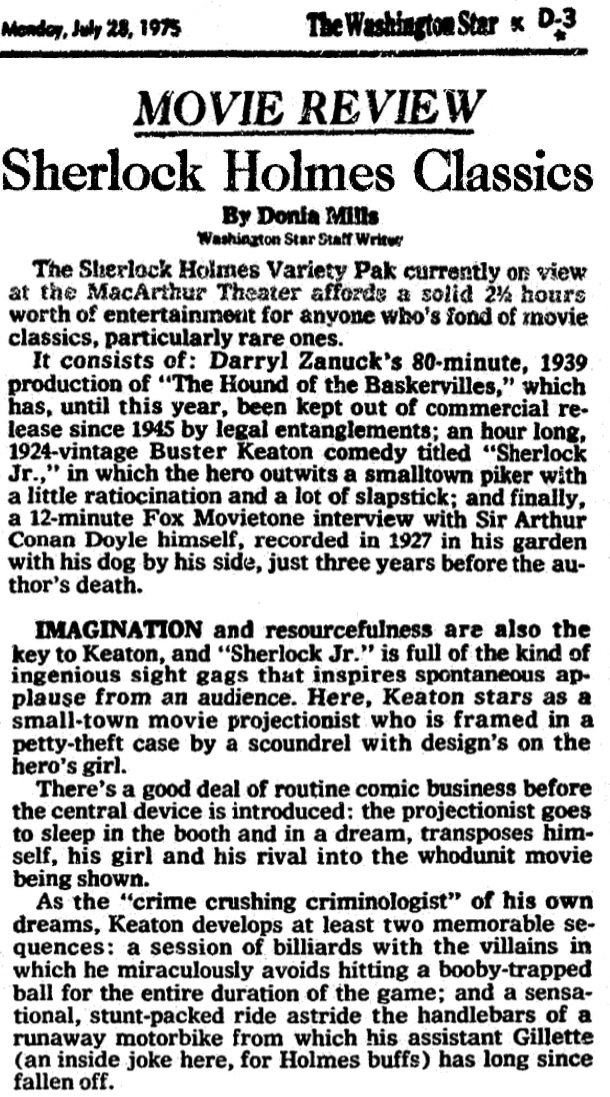 | |||||
| Fri 25 Jul 1975 | Chicago, IL | Playboy | 21 days | ||
| Wed 06 Aug 1975 | Philadelphia, PA | New World | 14 days | review, mini-review | |
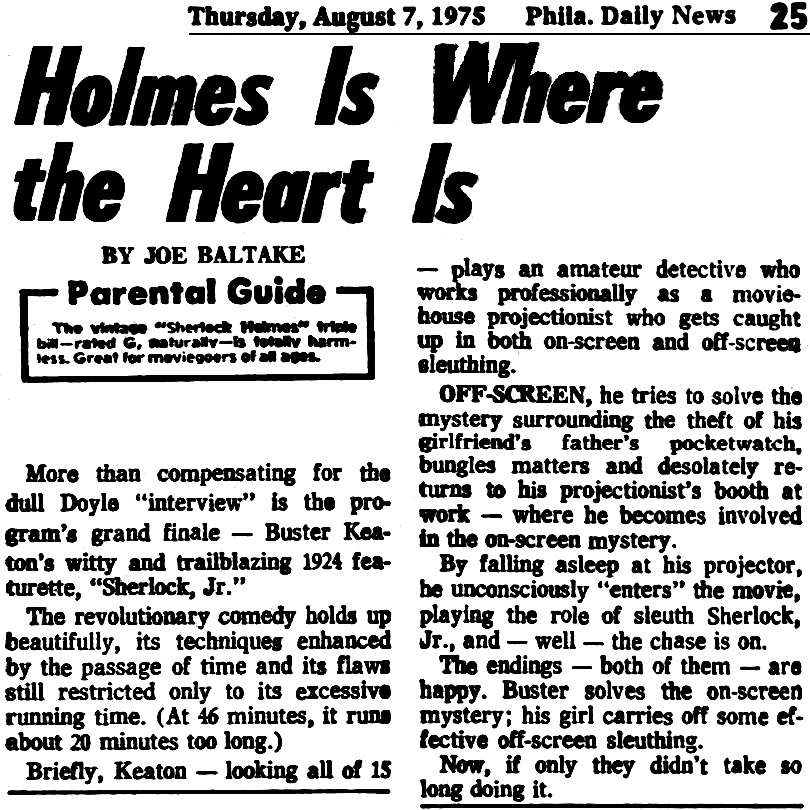 | |||||
| Wed 06 Aug 1975 | Philadelphia, PA | Budco Bryn Mawr | 14 days | replaced by The Railrodder on 20 Aug 1975 | |
| Fri 08 Aug 1975 | Charlotte, NC | Charlottetown Cinema II | 14 days | review | |
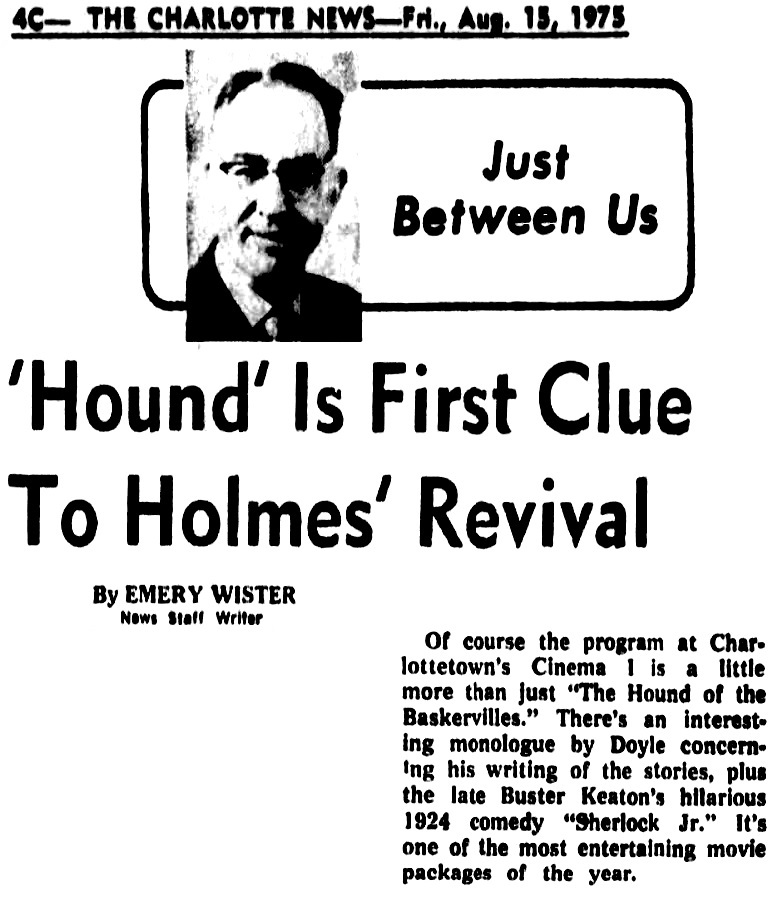 | |||||
| Fri 08 Aug 1975 | Columbus, OH | World | 42 days | review | |
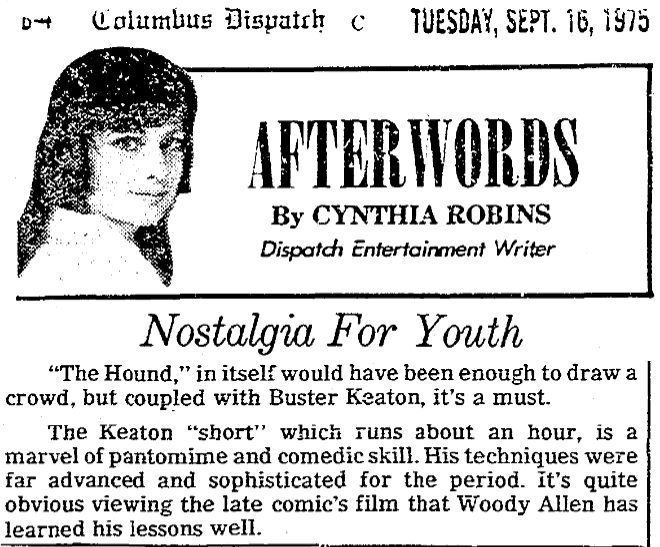 | |||||
| Wed 20 Aug 1975 | Boston, MA | Sonny & Eddy’s Exeter St. | 21 days | review | |
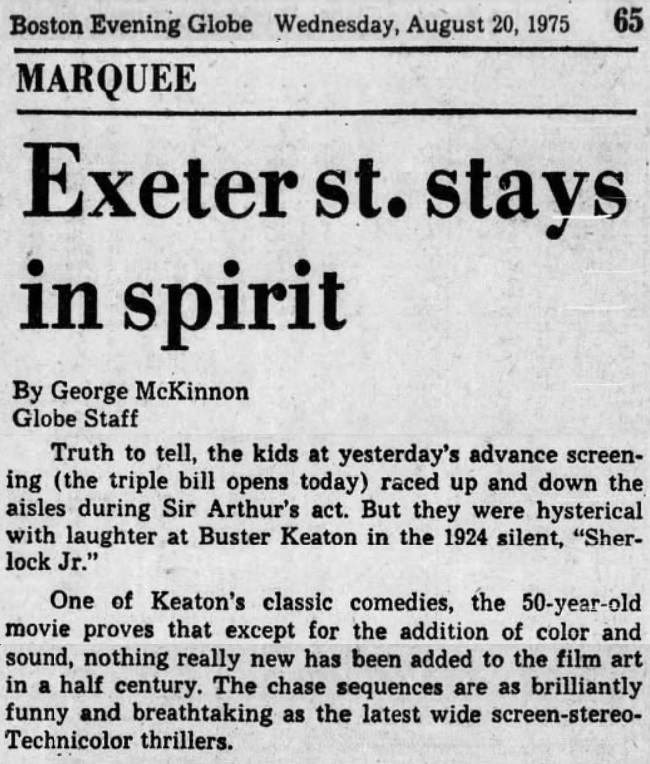 | |||||
| Fri 22 Aug 1975 | Indianapolis, IN | Glendale IV | 21 days | review | |
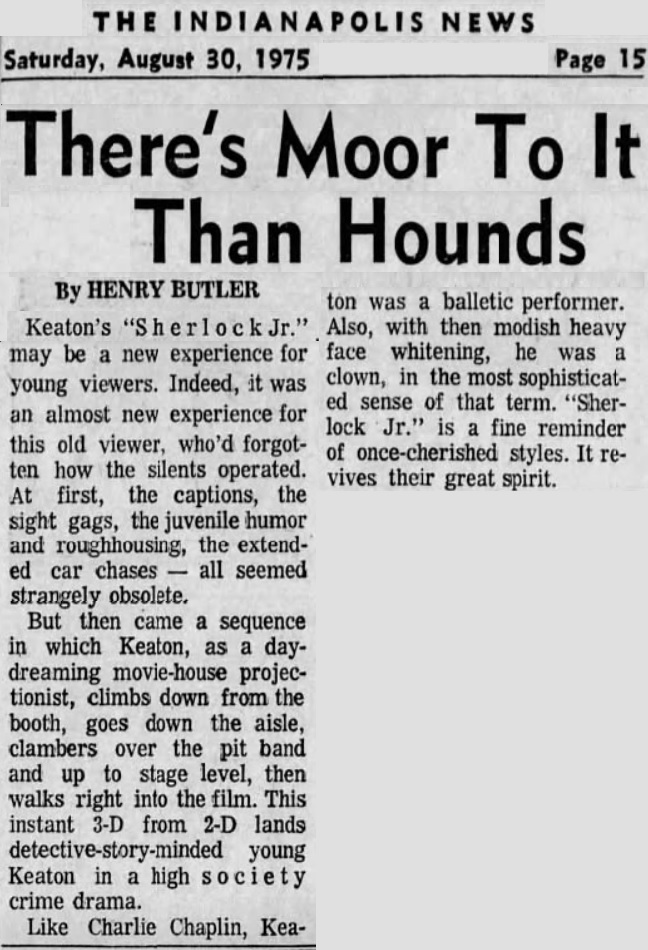 | |||||
| Fri 29 Aug 1975 | Jonesboro, GA | Arrowhead | 5 days | ||
| Fri 29 Aug 1975 | Atlanta, GA | Storey’s Rhodes | 21 days | ||
|
|
Atlanta, GA |
|
0 days | CANCELED | |
| Wed 10 Sep 1975 | Milwaukee, WI | Downer Prestige | 25 days | ||
| Fri 12 Sep 1975 | Memphis, TN | UA Southbrook 4, scr 1 | 14 days | ||
| Fri 12 Sep 1975 | Memphis, TN | Raleigh Springs Mall Cinema II | 14 days | ||
| Wed 17 Sep 1975 | Boston, MA | Sonny & Eddy’s Allston 1 | 7 days | ||
| Wed 17 Sep 1975 | Madison, WI | Orpheum | 9 days | syndicated review | |
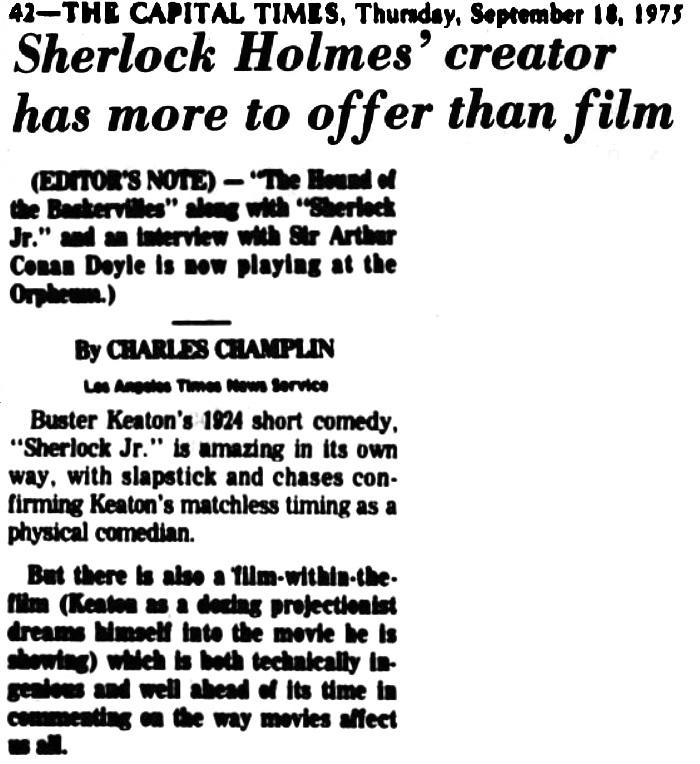 | |||||
| Wed 17 Sep 1975 | Santa Cruz, CA | Sash Mill Cinema | 7 days | Not with Hound, but with Adventures of SH | |
| Fri 19 Sep 1975 | Memphis, TN | GCC Plaza, scr. 2 | 7 days | ||
| Wed 24 Sep 1975 | Arcata, CA | Minor | 4 days | also as kiddie matinée w/ Silent Running | |
| Thu 25 Sep 1975 | Madison, WI | University Square Four, scr. 1 | 7 days | ||
| Wed 08 Oct 1975 | Uniondale, NY | Mime Cinema | 7 days | ||
| Fri 17 Oct 1975 | Erie, PA | Cinema World | 11 days | ||
| Fri 17 Oct 1975 | Terre Haute, IN | GCC Honey Creek Square Cinema I | 7 days | ||
| Fri 17 Oct 1975 | Salina KS | Vogue | 7 days | ||
| Wed 22 Oct 1975 | Pasadena, CA | Hastings | 7 days | ||
| Wed 22 Oct 1975 | Los Ángeles, CA | UA Cinema Center 1 | 7 days | ||
| Wed 22 Oct 1975 | Cerritos, CA | UA Los Cerritos Mall Cinemas 1 | 7 days | ||
| Wed 22 Oct 1975 | Hollywood, CA | Egyptian 3 | 7 days | ||
| Wed 22 Oct 1975 | Marina del Rey, CA | UA Cinema | 7 days | ||
| Wed 22 Oct 1975 | Torrance, CA | UA Del Amo | 7 days | ||
| Wed 22 Oct 1975 | Costa Mesa, CA | UA South Coast Plaza Cinemas 3, scr. 2 | 7 days | ||
| Wed 22 Oct 1975 | Northridge, CA | Cinema Center | 7 days | ||
| Wed 22 Oct 1975 | Redondo, CA | Marina Cinema | 7 days | ||
| Wed 22 Oct 1975 | Riverside, CA | UA Cinema | 7 days | ||
| Thu 06 Nov 1975 | Venice, CA | Fox Venice | 1 day | ||
| Wed 12 Nov 1975 | Winston-Salem, NC | Janus III | 4 days | ||
| Fri 14 Nov 1975 | Louisville, KY | Alpha 3 | 12 days | review | |
 CONGRATULATIONS, WILLIAM MOOTZ! You are probably the only movie critic anywhere in the world at any time who ever noticed this ubiquitous problem. | |||||
| Fri 14 Nov 1975 | Little Rock, AR | UA Four | 12 days | ||
| Fri 14 Nov 1975 | Santa Mónica, CA | Nuart | 1 day | ||
| Fri 14 Nov 1975 | Fort Walton Beach, FL | Palm | 7 days | ||
| Wed 26 Nov 1975 | Port Jefferson, NY | Port Jefferson Twin Mini-East | 7 days | ||
| Fri 02 Jan 1976 | Cleveland, OH | Heights | 7 days | ||
|
I saw Jay Ward’s edition numerous times, in 35mm and in 16mm.
In April 1976, at The Guild in Albuquerque, the trick shot at the billiard table,
when the cue ball miraculously makes a
|
|
Rohauer revived his Buster Keaton Festival in NYC at the Lincoln Plaza Cinema from 12 August through 19 September 1981.
The show opened with Rohauer’s 1977 revision of the Jay Ward edition,
doubled with what may well have been Three Shorts!
|
|
It must have been immediately afterwards that Rohauer retired the 1977 edition
to replace it with his new 1981 edition with Lee Erwin’s 1972 score.
|
|
On Sunday, 4 March 1990, I saw the movie again in 35mm at Shea’s Buffalo.
The print was Academy format and projected that way, surprise surprise surprise.
It definitely traced its ancestry back to Jay Ward’s edition,
but, as I feared, that marvelous
|
|
When I saw the movie again in Toronto at the Art Gallery of Ontario’s Jackman Hall in 1995,
I once again heard the scratchy 78rpm fox trots, and, to my exquisite delight,
the
|
|
When I saw it in 35mm at UCLA in 2004 or thereabouts, it was the 1977 edition and the
|
|
So, I was entirely befuddled.
What had happened?
What are the details?
|
|
Oh. Oh. Oh. Duh. I should know.
As I write, I scratch my head.
After scratching my head for several days, I know what happened.
Jay Ward’s prints in 1975 all included that
|
|
When I saw Sherlock Jr. and The General at The Guild in April 1976,
both films were still under the control of Jay Ward.
When I saw Sherlock Jr. at UNM, it was under the control of Rohauer,
but it definitely traced its ancestry back to Jay Ward’s edition.
When I saw Sherlock Jr. at Jackman Hall in 1995,
Rohauer was dead, and so someone sent out a 1975 Jay Ward print, probably in error.
By the time Kino issued its
|
|
Oh, yeah, that time I saw it at Shea’s Buffalo.
I brought two acquaintances along.
There were over a thousand people in the audience, and there was screaming laughter throughout —
except from my two acquaintances.
One of them found nothing amusing about it at all.
The other, a professional magician, was mortified.
He thought that Buster was a maniac for risking his life over and over and over again, right on camera.
He found the movie horrifying, not funny.
Very odd. He was a professional magician.
He should have recognized how the illusions were done.
It was all acrobatics, magic tricks,
|
|
Oh. I remember. The print that arrived at Shea’s Buffalo had some damage.
The bit where the motorcycle hurls Buster into the shack and he inadvertently
|
|
Anyway, in a nutshell, I was quite accustomed to Jay Ward’s edition,
even though I had no idea it was Jay Ward’s edition.
Jay Ward’s name was nowhere on it.
Then David Shepard and Kino issued Volume One of “The Art of Buster Keaton”
on Wednesday, 1 February 1995, and I knew that David used a different source, I think from France.
He did not use any Rohauer/Ward source for this movie, or so he thought.
As soon as I saw what was on my TV screen, my jaw dropped to the floor.
Let’s start by looking once again at Jay Ward’s edition:
|
|
|
|
Now let’s look at David Shepard’s edition for “The Art of Buster Keaton” from February 1995:
|
|
|
|
I was flabbergasted. Immediately.
And what flabbergasted me even more was that NOBODY ELSE COULD SEE ANY DIFFERENCE!!!!!!!!!
|
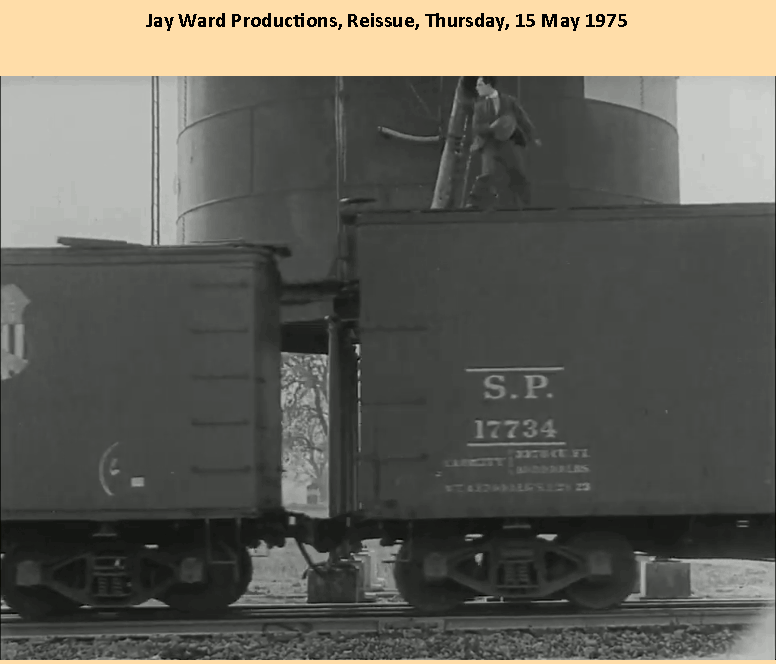
|
|
So, the lab that Jay Ward hired captured a little more width, though by no means all of it, and a smidgin more of the bottom.
The lab that David Shepard hired, on the other hand, captured more of the top, but lost a lot of the width and a smidgin of the bottom.
Why? Why do so many labs have such difficulty capturing the entire image?
It’s not like it’s a complicated concept.
|
|
The current editions — release prints and
|
|
As for the scratchy 78rpm
|
|
Clarence Williams,
Long, Deep and Wide
(Broadway (9) – 1347, 1928)
Fletcher Henderson, Houston Blues (Columbia – 164-D, 1924) Fletcher Henderson, Muscle Shoals Blues (Columbia – 164-D, 1924) Fletcher Henderson, That’s Georgia (Columbia – 202-D, 1924) The Georgians, Mindin’ My Bus’ness (Columbia – 102-D, 1924) Kansas City Five, Louisville Blues (Ajax (6) – 17072, 1925) Perry Bradford’s Jazz Phools, Hoola Boola Dance (Paramount – 20309, 1924) The Georgians, Doodle Doo Doo (Columbia – 142-D, 1924) The Georgians, Savannah (Columbia – 142-D, 1924) The Georgians, My Best Girl (Columbia – 252-D, 1925) Fletcher Henderson, Naughty Man (Columbia – 249-D, 1925) The Chicagoans, Chicago Blues (feat. The Bucktown Five) (Gennett – 5418, 1924) Bix Beiderbecke, Really a Pain (Gennett – 5419, 1924) The Bucktown Five, Hot Mittens (Gennett – 5518, 1924) Fletcher Henderson, Feelin’ the Way I Do (Silvertone – 3023, 1924) |
|
This makes me super-curious.
Why was not Joe Siracusa commissioned to add vintage mood music to the film?
Why, instead, did someone on the Jay Ward crew opt merely to add
|
|
Bill and Skip, again, did not windowbox the result.
Why?
That might be because they tested the result and discovered that,
if framed exactly at center, audiences would be able to follow the story and the action,
even though, admittedly, the images looked HORRIBLE when cropped, and I mean
HORRIBLE.
I can assure you that some cinemas did not get the framing exactly at the center,
and that rendered the film incomprehensible.
Another possibility is that Randy saw no need, since he was confident that “art houses”
and repertory houses surely used the Academy format appropriately.
If that’s what he thought, then little did he know.
Never. Never. Never. Never. Never. Never.
Never. Never. Never. Never. Never. Never.
Never. Never. Never. Never. Never. Never.
Never. Never. Never. Never. Never. Never. Never.
|
|
Did The General and Sherlock Jr. constitute a common double bill?
Were the two movies traveling together as a package?
No, not exactly.
I can find only two bookings for that double bill:
|
|
No. Not sent out as a package. The Loft booked a double feature in Tucson,
and so The Guild booked the same two flicks before they would be returned to whatever exchange.
Probably got a cut rate.
And, in the meantime, The Guild made mincemeat of both movies by cropping them at 1:1.66U .497"×.800",
and misframed to boot.
Not just a little misframed. Oh no. Outrageously misframed.
For Sherlock Jr., only the top of the image in some reels and only the bottom of the image in other reels.
For The General, the projectionists cranked the framing knob all the way
until the bottom of the image lined up with the bottom screen masking,
and so they showed us only the bottom half of the image.
For Sherlock Jr., they tried to center the image but overdid it.
For the first two of the three reels,
I could see them, each time, turn the framing knob up and down
until they thought they had reached the middle, but they totally bungled it and got it all the way up or all the way down.
I remember that, for one screening,
the projectionist reframed the billiard scene and completely cropped off the pool table!
Now, courtesy of Handbrake, I tested the Jay Ward edition of Sherlock Jr. at 1:1.85,
and, as horrendous as the result looks,
as much as it would make you want to scream, you can still follow all the action from beginning to end.
It is a
brutally unpleasant experience, but you can still follow the story.
When it was projected at The Guild, you absolutely could NOT follow the story. Impossible.
The framing was too far off.
The three or four other people at each showing were bored and irritated, unable to follow what was happening on (or off) screen,
and simply concluded that these were rotten movies.
To say the very least, the owners of The Guild could never have competed against Werner Schwier.
Werner knew the art of ballyhoo and could attract hundreds of thousands of people,
while The Guild was lucky if it could sell ten tickets on a Saturday together with a bucket of popcorn.
The Guild and its sister cinema made some profit for a while just by announcing movies and opening the doors,
but business could have been stratospheric if only they had employed ballyhoo.
I tried to explain, but all I got in response were facial expressions exhibiting exasperation.
|
|
If you’re curious about it, you can Google
“Sherlock Jr.”
and see a whole bunch of unit stills of abandoned sequences.
Here’s a fascinating discussion.
Buster and his peeps, as always, used the Kodak raw stock as a scratch pad.
They changed the story multiple times and they tried scenes in different ways.
They started off with complicated situations with ridiculous ideas that stretched all credulity,
and then they finally settled on the simplest, most believable, and most direct way of telling the story.
Lots of the story ideas were completely jettisoned and characters were swapped.
When Buster finished his movie, it was six reels long, but his contract stipulated five reels max.
He had already breached that term in his previous two movies, and so for this one he didn’t dare push it.
He abridged it himself, and you can see evidence of trimming from beginning to end.
One loss that I regret is when he somehow knocks the reel rack off the wall.
|
|
I wish somebody would identify all the extras, especially that scary guy who lost his wallet.
Kathryn McGuire’s plaid dress with all the bows and ribbons is one of the greatest costumes in movie history.
If you’re curious: Powers 6A
|
|
Sequences that Buster shot but revised or abandoned:
|
|
Buster is sweet on Kathryn McGuire.
Kathryn’s dad and his hired hand seem to be farmers and Buster seems to be their assistant.
Buster’s rival is Ward Crane. Only the briefest flash of this sequence survives in the final film,
when we see only Kathryn and her dog.
It seems that Buster was trying to do three things at once:
Projectionist, detective, and gardener.
My guess is that after three days of enduring Roscoe’s temper tantrums,
Kathryn resigned in tears.
Buster replaced her with Ruth Holly,
but then changed his mind and moved Ruth to the candy shop.
Buster’s new Kathryn was Rosalind Byrne.
Then Kathryn came back, and so Buster approached Rosalind and said, “Sorry, maybe next time.”
Just a guess.
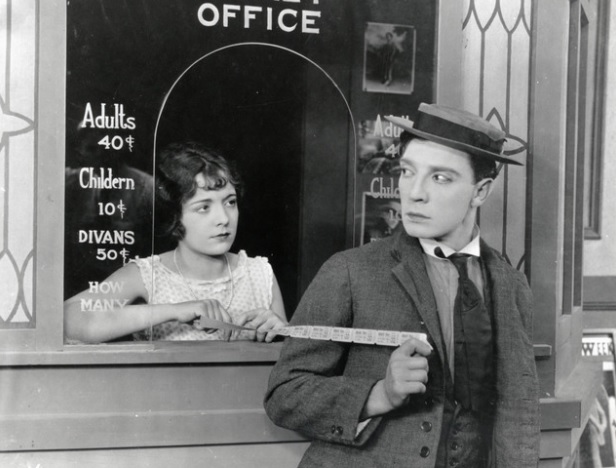 K22-6 Ruth Holly in the ticket booth. It seems that in an early conception, Buster was so sweet on Ruth that he decided to be near her by taking a job at the cinema. 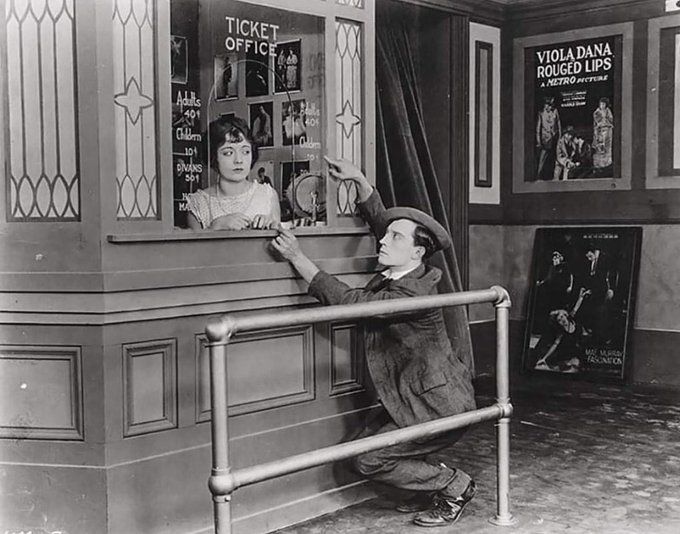 Buster tries to get in at the reduced moppet rate. Viola Dana in Rouged Lips. Viola and Buster were dating off and on until Schenck told him to marry his sister-in-law instead. Buster got along much better with Viola. 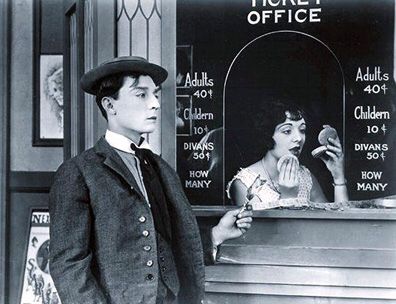 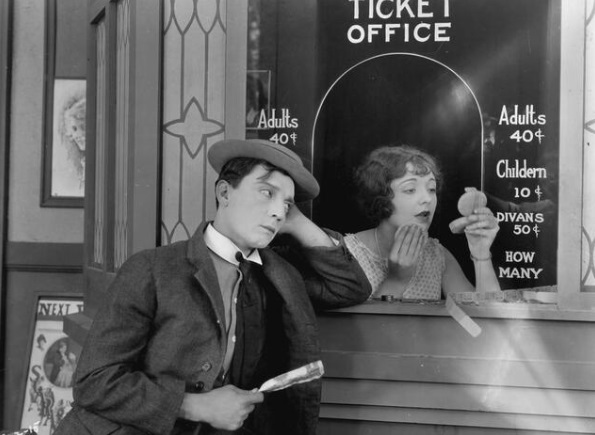 K22-15 Buster buying a ticket just to have an excuse to say Hi to the object of his attention. 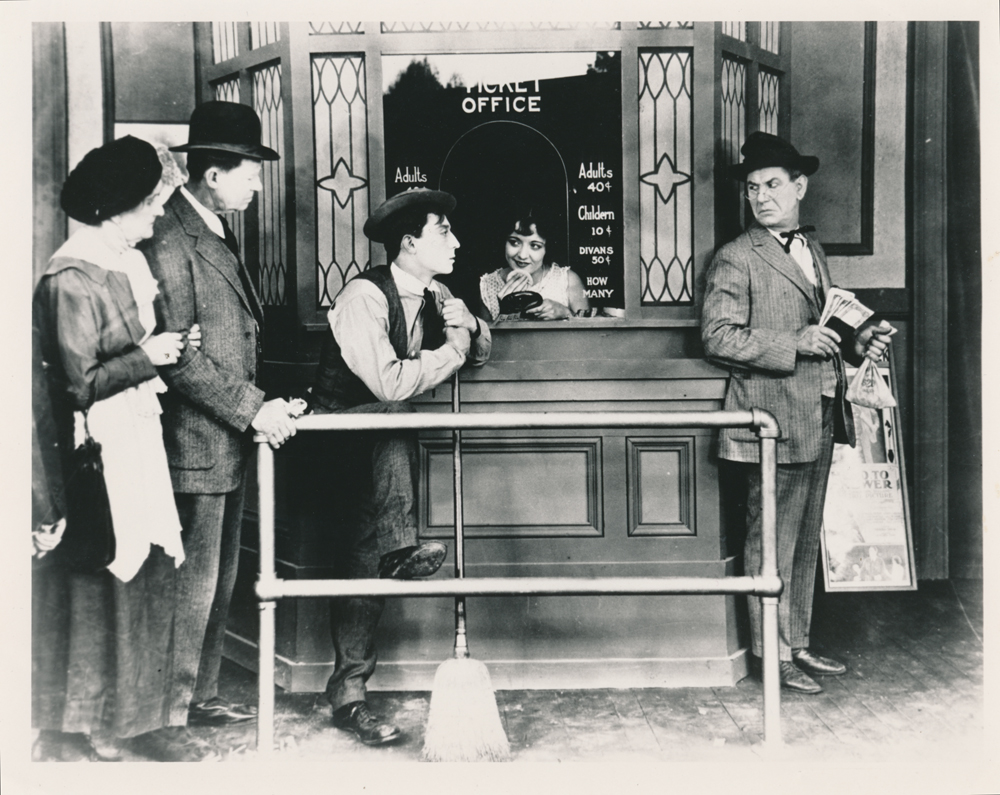 Buster has a new job, and he blocks the queue. That looks like Joe Keaton in queue, standing beside the lady who was destined to lose a dollar. Ford West is not happy about Buster getting in the way of the customers. 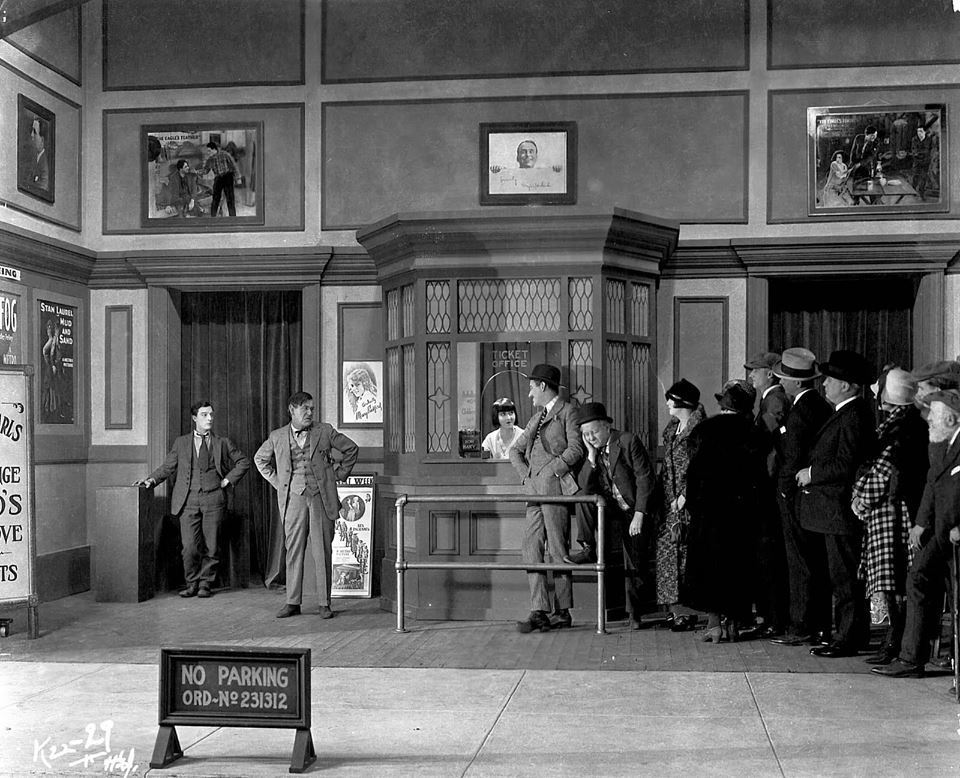 K22-29 New idea. Move Ruth Holly out of this scene. Put her in the candy store instead. This time around, Buster is sweet on Rosalind Byrne, who works the box office. We see that The Sheik has his eye on her, too. We see that Buster notices. 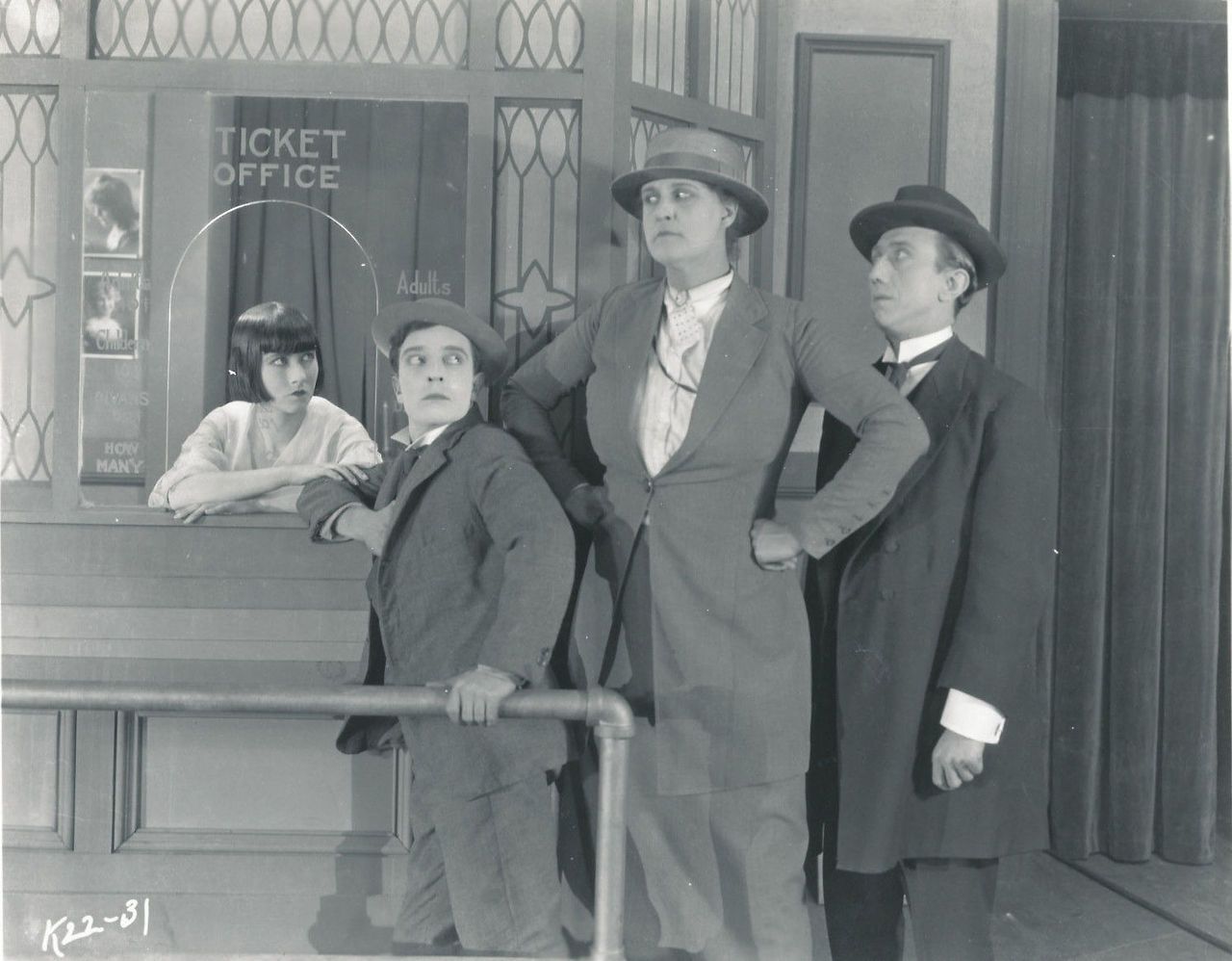 K22-31 Blanche Payson is impatient at this nonsense and just wants to purchase her ticket. George Davis seems apprehensive at the potential for violence to break out. 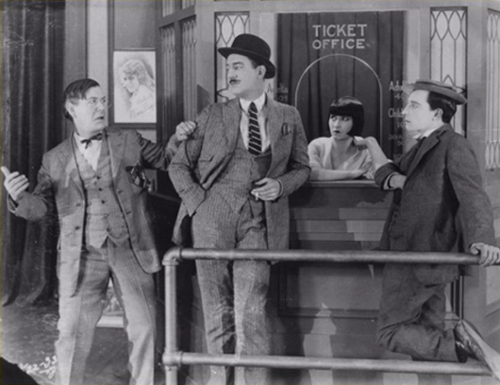 K22-33 Ford West already knows that Ward Crane is bad news. Rosalind and Buster look on. 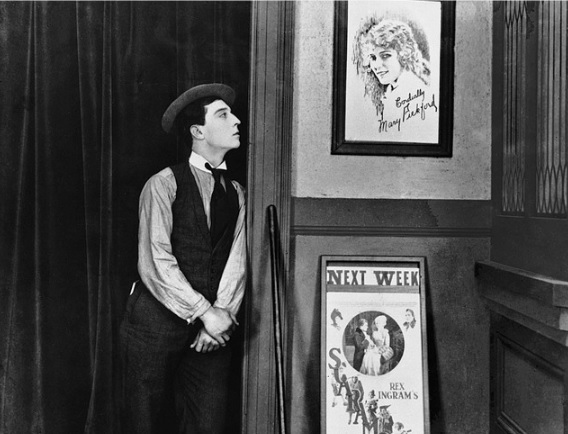 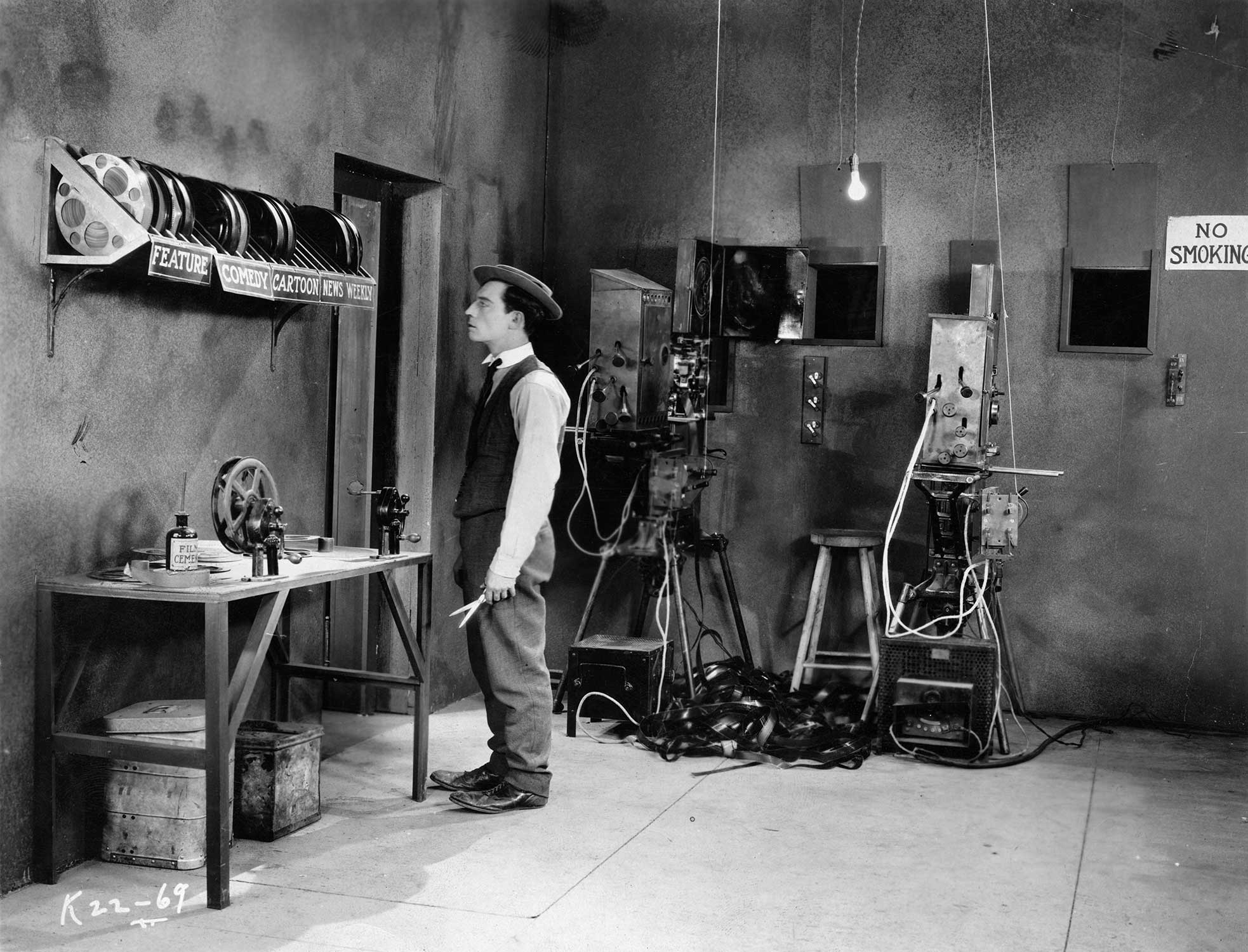 K22-69 Film has poured onto the booth floor. The film rack is securely mounted to the wall above the inspection bench. In the final film, we see only that the film rack has fallen down onto the inspection bench. 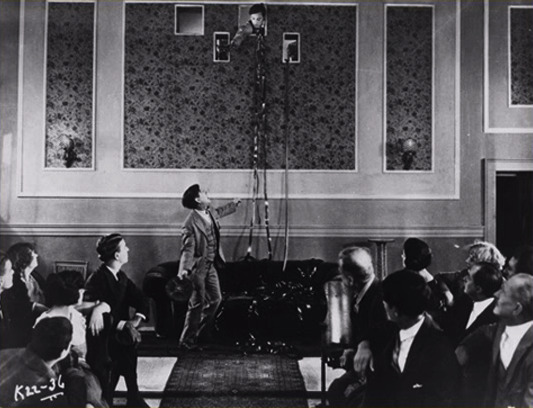 K22-36 The film on the booth floor has now poured out the porthole windows, along with an entire reel, which Ford West has angrily rescued. Buster junked this scene for the obvious reason that it was strained and ridiculous. 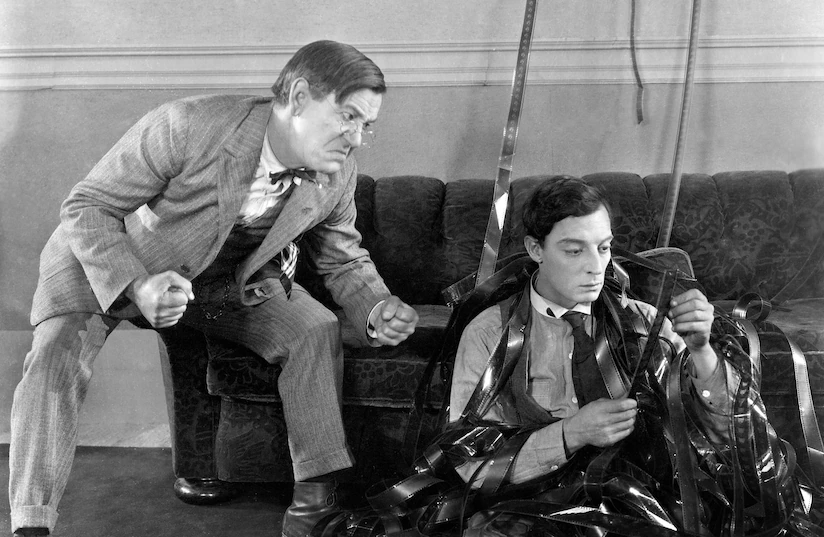 K22-34 I wonder what was on that film. 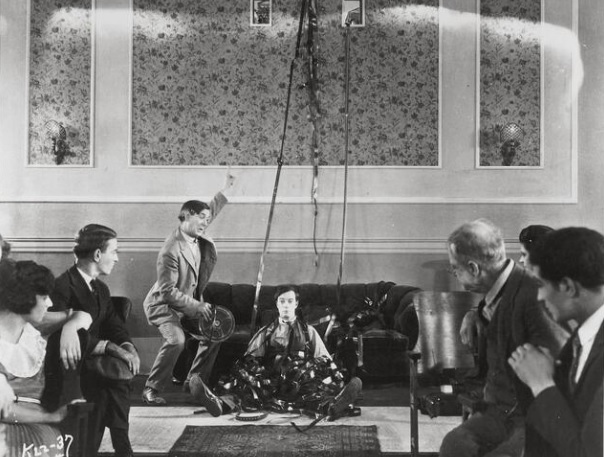 K22-37 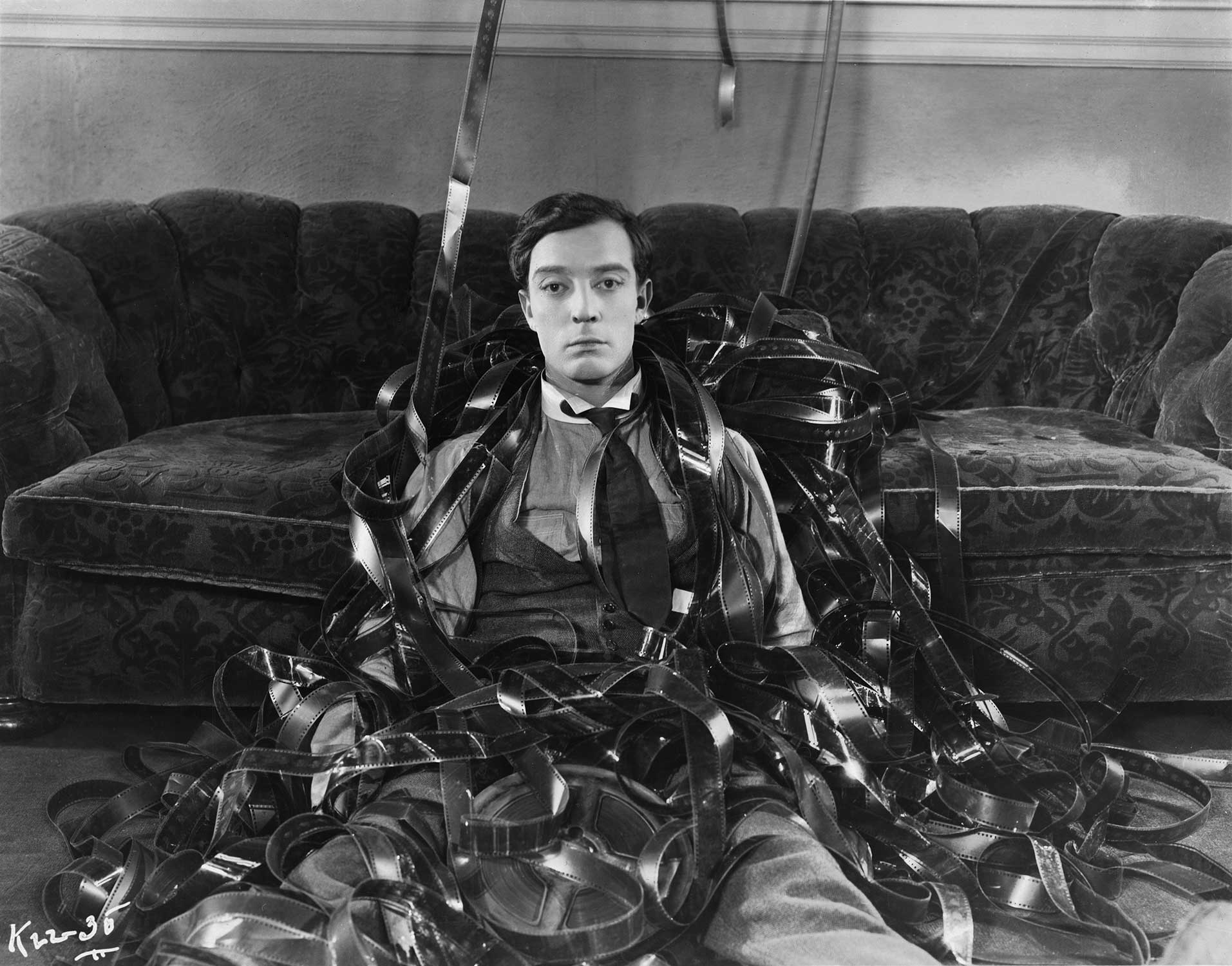 K22-35 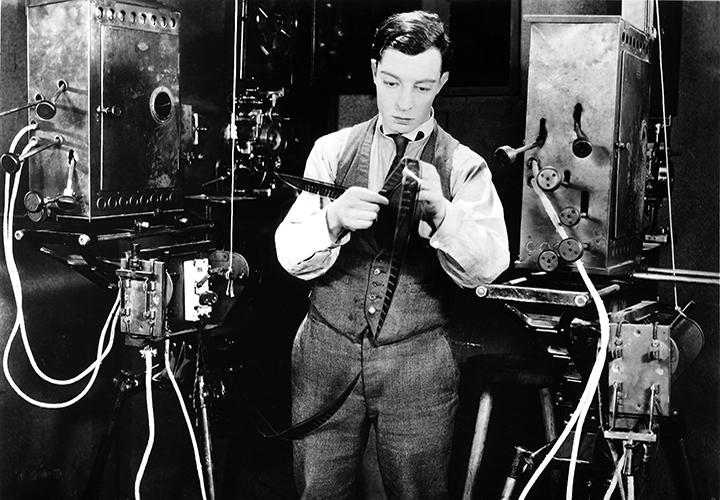 What is Buster looking for? 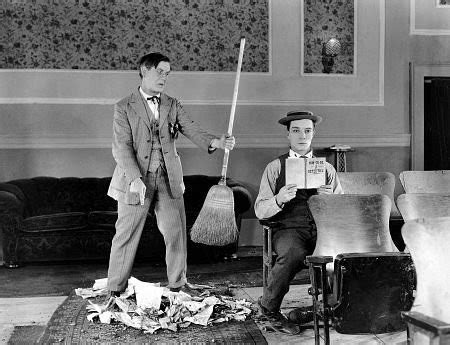 K22-64 First show is over. Time to sweep up. This is overplayed. The scene in the final film is underplayed. 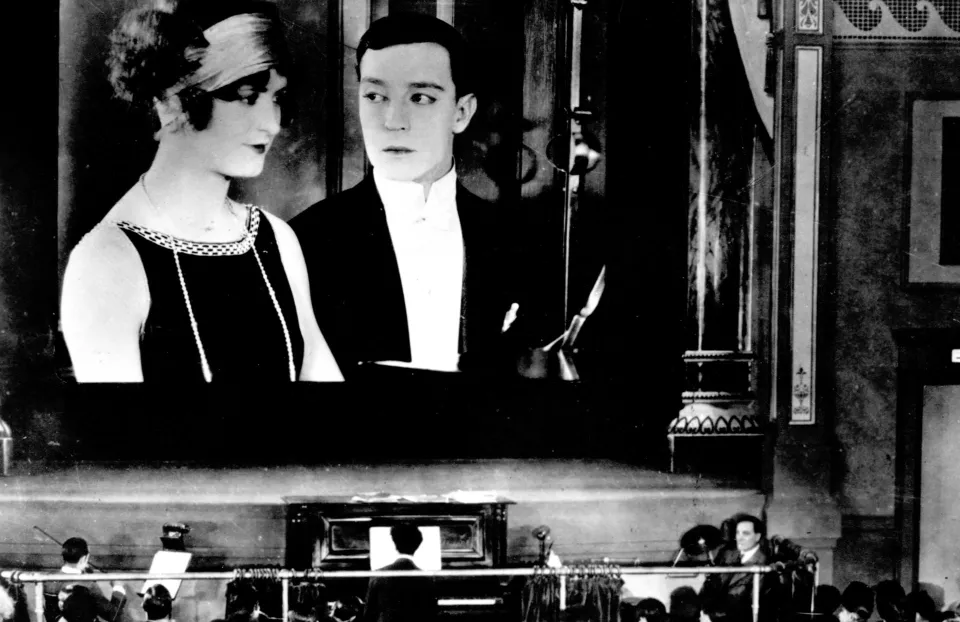 K22-51 The still above and the still below are composites. The image of the auditorium had a hole cut out where the screen was, and other images were placed behind. Note that the people in the still above and in the still below have not moved a bit. 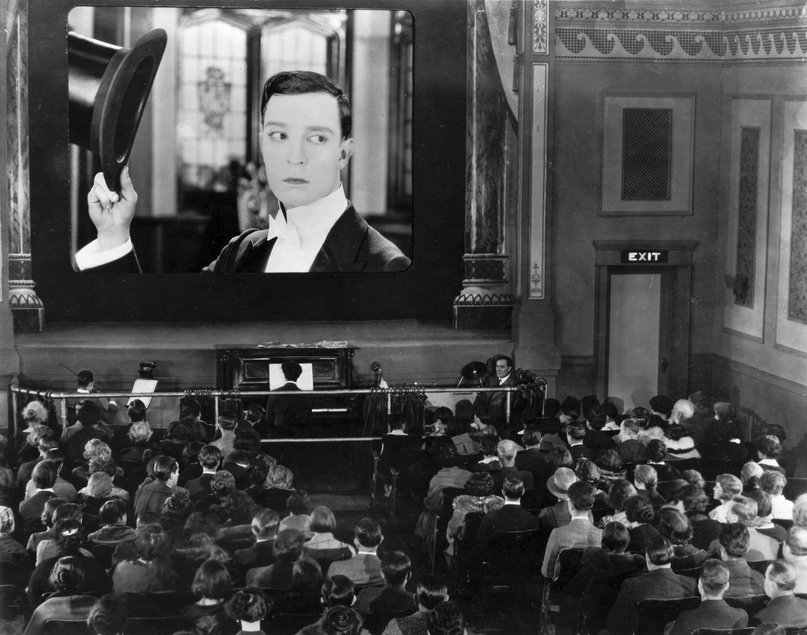
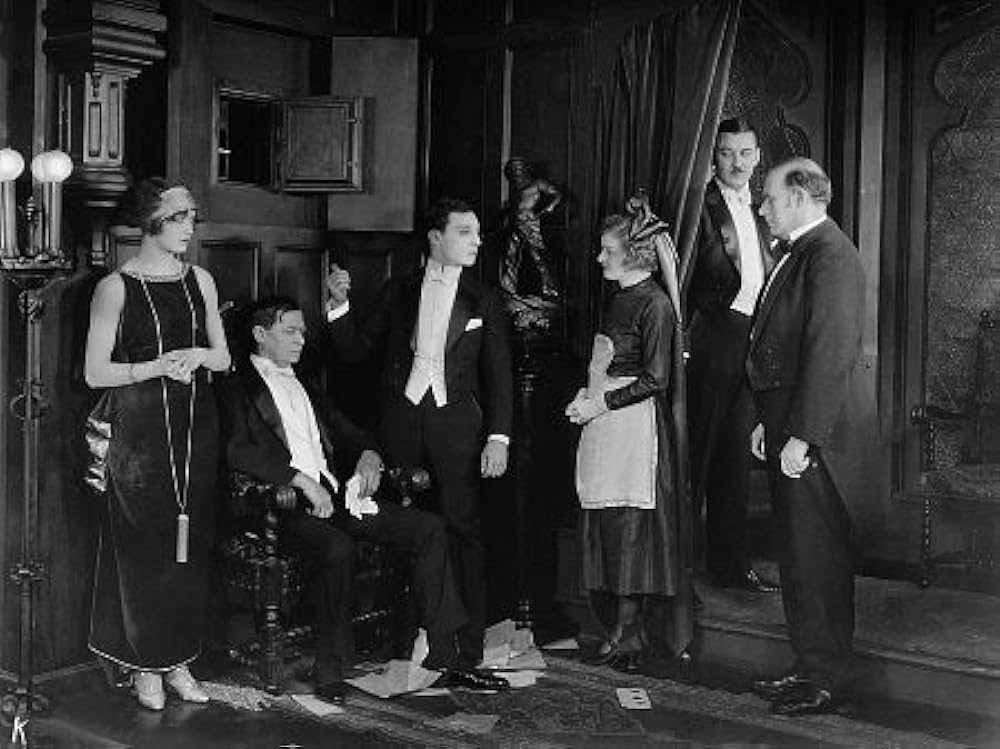 K22-57 Can anybody identify the maid? Oh. Never mind. She’s Jane Connelly, Erwin’s wife in real life. They had been vaudevillians, and that was certainly how Buster got to know them and cast them. 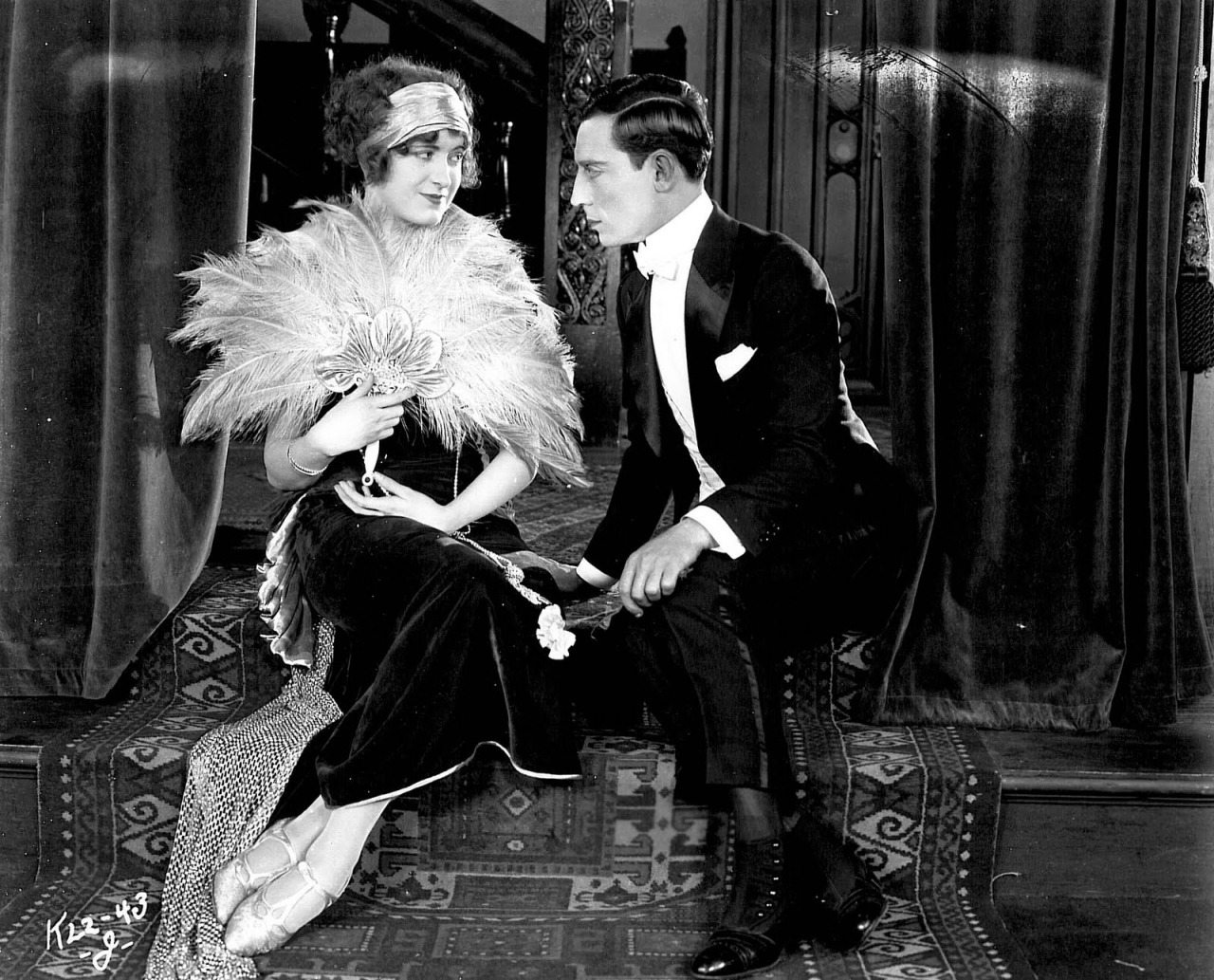 K22-43 With a flower in his hand? 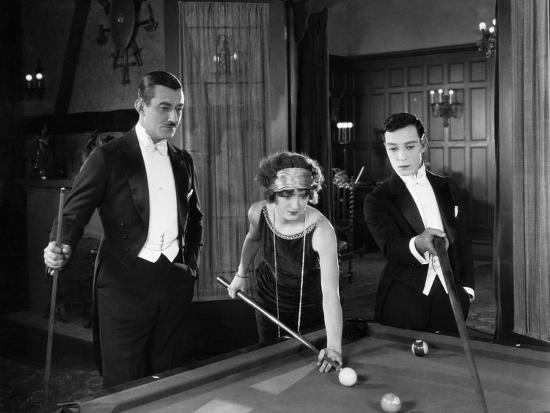 In an earlier conception, Kathryn partook in the game. 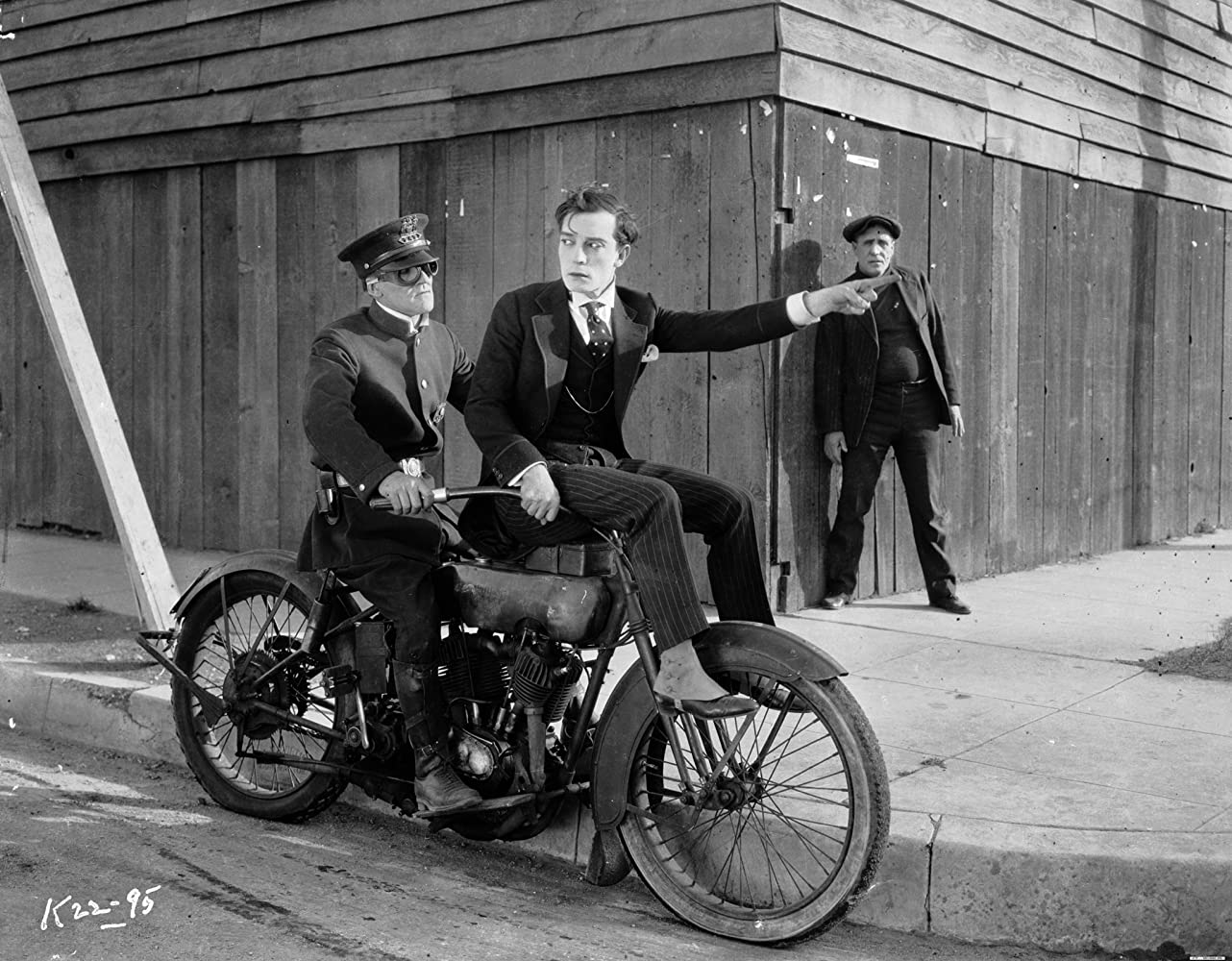
K22-95 This scene was smoothed out for the final film. Ford West on the Harley, Steve Murphy on the sidewalk. 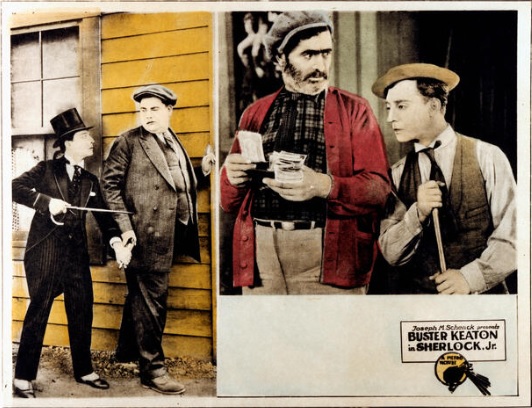 Roscoe directed the first few days, but Buster junked his footage. This unit still survives, though, showing that Roscoe was originally one of The Sheik’s enforcers. The guy with the wallet was also once to have been among the enforcers. 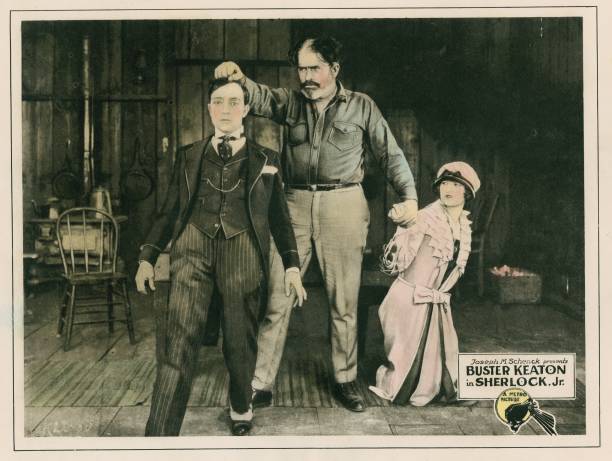 Who is that tough guy? Can anybody identify him? Buster rethought this scene and gave the part to Erwin Connelly. 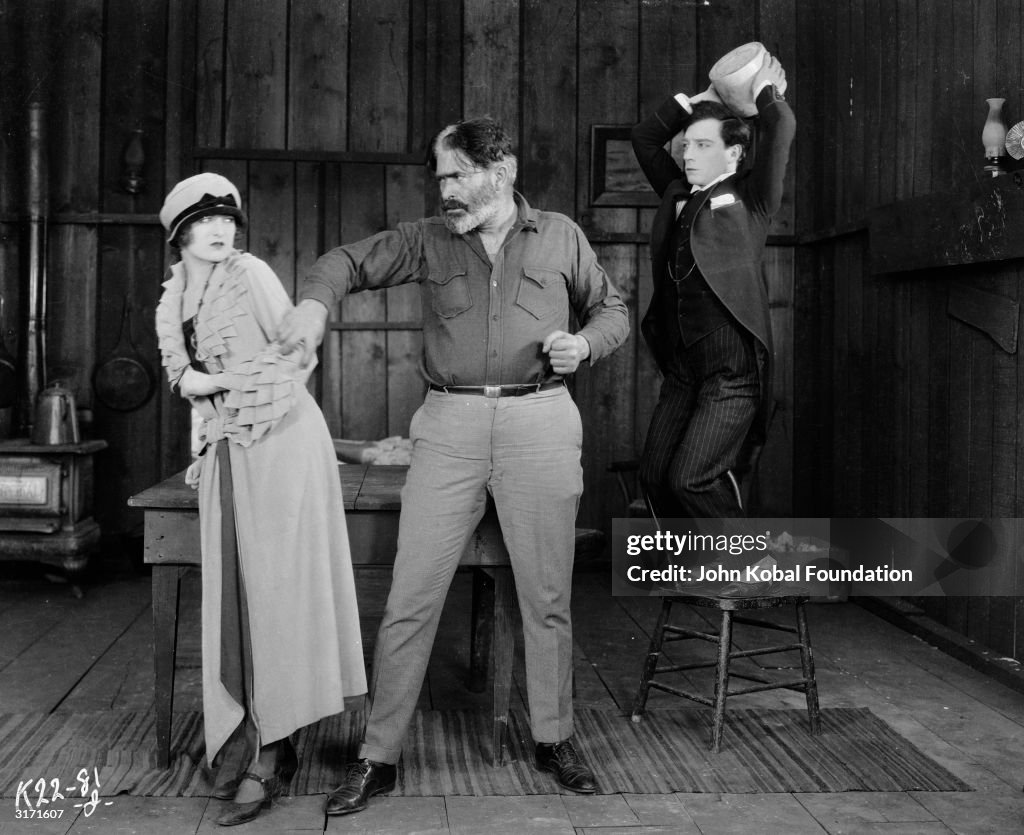 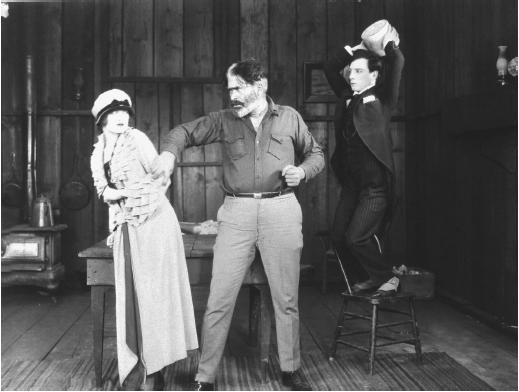 K22-81
K22-81Buster later came up with a more spectacular way to rid Kathryn of the dastardly villain. 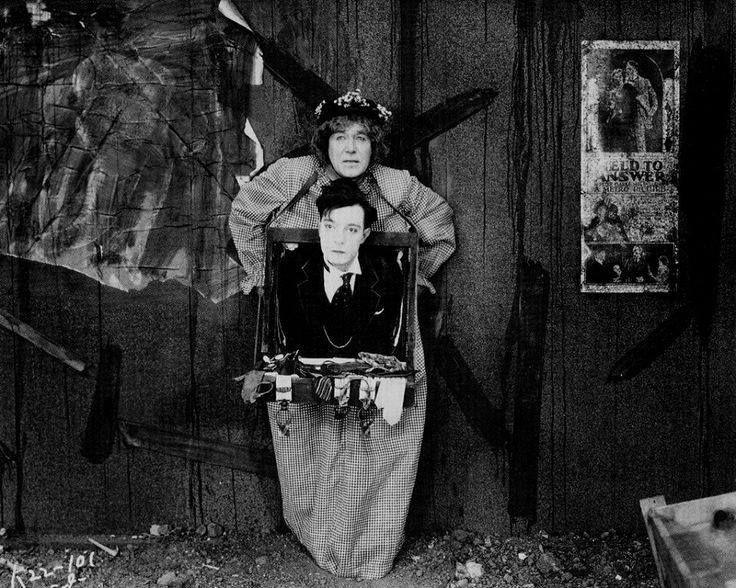 K22-101 Gag photo. And, in case you’re wondering, Held to Answer (1923). |
|
The Margaret Herrick Library posts some images, sometimes.
Sometimes the images are there, and sometimes they are not.
That changes every few minutes, or every few days, or every few weeks.
Try your luck.
I made backup copies, just in case the links disappear again.
|
|
So much for Sherlock Jr.
Now let’s get back to The General.
Rohauer by now had mutilated most of the Buster releases,
and so now he chose to claim production credit on an altered edition of The General.
|
|
Here is a collector who enjoyed the Jay Ward “sound version”:
|
|
“Fractured Flickers,”
The Classic Horror Film Board, comment by Ryan Brennan, 15 July 2017:
“Jay Ward and Bill Scott might have had some real affection for silent films. Perhaps as a result of the work entailed in finding suitable clips for the show they must have run across a lot of Buster Keaton material. This resulted in a new sound version of Keaton’s THE GENERAL. A new score was commissioned, some sound effects added, and the |
|
The crazy thing? I’m really beginning to enjoy the Jay Ward edition, too!
|
|
Skip Craig’s description of
The Golden Age of Buster Keaton is a bit of a revelation.
A college buddy saw it on HBO and he told me that it was a documentary with lots of clips.
I would love to see it, but it has never been shown since.
Does it still exist? I don’t know.
According to Skip,
The Golden Age of Buster Keaton that my friend saw on HBO
was only Part One of a
|
|
Ah. Look at this!
IMDb.com, The Paleface, Alternate Versions:
“The version shown on the American Movie Classics channel
was copyrighted in 1968 by Leopold Friedman and Raymond Rohauer.
It had an uncredited music soundtrack and ran 21 minutes.”
Hmmmmmm. That was different from the edition used in Three Shorts.
|
|
I recognize some of the music in Three Shorts.
There was a piece in The High Sign that was, coincidentally, the same as a cue in Spite Marriage.
(The “sound” version of Spite Marriage did not have a music score.
The soundtrack was stitched together from a library of
|
|
The second one, called Three
Shorts, consisted of The Paleface, The High Sign, and One Week —
it was pretty much just the three stuck together, and linked by Bill’s
narration. Joe Siracusa did the music, and again he used some Spike Jones
people like George Rock; he got these authentic 1912-era pit-band scores
from Milt Larsen [proprietor of the Magic Castle and Variety Arts Library]
and these were real silent-movie scores. They were recorded and interspersed
with original piano tracks composed by Johnny Guarnieri.
|
|
It is interesting to me that 1975 saw three Jay Ward releases of Buster’s works:
The Golden Age of Buster Keaton,
Three Shorts, and
Sherlock Jr..
In the US, Golden Age went straight to premium cable,
Three Shorts went straight to premium cable as filler,
and Sherlock Jr. got individual bookings as a second bill to The Hound of the Baskervilles.
Those, together with the 1970 edition of The General,
should have been major releases, but there was a failure of imagination at every stage of the game,
and all three were invisibly dropped onto the market as afterthoughts and they all vanished before they could be noticed.
|
|
And this is what drives me nuts.
Yes, we all want to recover the filmmaker’s original intentions,
the filmmaker’s original edit,
the filmmaker’s original framing,
the filmmaker’s original tinting,
the filmmaker’s original preferences.
I am no different.
Yet there are some alternative releases — not all, but some — that, while not authentic,
are an important part of the historical record.
Why would we not want to have Joe Siracusa’s scores played by members of the Spike Jones band?
(Read an
article by Joe Siracusa! That’s not a suggestion. That’s a command.)
Why would we not want even to have the ability to see what our parents and grandparents saw fifty and sixty years ago?
Such alternatives should not be suppressed.
They should be available, not as substitutes for the filmmaker’s originals,
but at least as supplements on DVD and
|
|
Skip Craig said that the Jay Ward version of The General was shown on HBO.
That sent me on a wild-goose chase for months.
Skip Craig had misremembered the order of the features he worked on,
he misremembered the year,
he entirely forgot that one of the films was released,
he misremembered the narration,
and he misremembered who transmitted The General on television.
I know for certain that it was shown on cable.
I know that because, sometime around 1990, Chuck Van Dusen ran off a VHS copy for me, and it is now somewhere in my storage locker.
Been in storage for 22+ years.
My memory is growing dim. I need to see that tape again, that very tape, the exact tape that Chuck gave to me.
I’ll try to dig it out someday in the foreseeable future. Hope I can find it.
I should digitize it before the tape rots.
Hope it hasn’t rotted already.
After several decades in an outdoor storage locker, though,
I fear that it may well have passed on to that Great Azimuth Head Drum in the Sky.
|
|
HBO began transmitting on 8 November 1972.
Bill Scott’s edition of The General was issued to cinemas in September 1970.
I once knew two people who recorded it either on Betamax or on VHS.
Betamax was first put on the US market in May 1975 and VHS in June 1977.
I subscribed to HBO from about October 1984 through April 1987, and it was not shown during that time.
So, it may have been shown sometime after May 1975 and before October 1984.
Searches through the online newspaper archives are coming up blank.
Some but not all HBO Guides are
on the WayBackMachine and on
Archive.org,
and a few more can be found scattered about the Internet:
March 1982,
April 1982,
June through October 1982, June and November 1983, and
May 1984.
Of course, the one I need is missing.
Issues to seek out: 7/75, 9/75, 12/75, 2/76, 3/76, 4/76, 10/76, 1/80, 3/80, 5/80, 6/80, 7/80, 8/80, 10/80, 11/80, 12/80, 2/81, 4/81, 5/81, 6/81, 7/81, 8/81, 11/81,
1/82, 2/82, 5/82, 11/82, 12/82, 1/83, 2/83, 3/85, 4/83, 5/83, 7/83, 8/83, 9/83, 10/83, 12/83, 1/84, 2/84, 3/84, 4/84, 6/84, 7/84, 8/84, 9/84, 10/84.
Was it shown after April 1987? Possumbility, but I have my doubts, and no search reveals such a transmission.
So, it’s almost gotta be in one of those. Unless it isn’t.
The punch line, predictably, is that it was never on HBO after all.
HBO transmitted three other Jay Ward releases:
The Crazy World of Laurel & Hardy in
June 1979,
The Golden Age of Buster Keaton in
July 1979
and again in May 1980,
and
The Vintage W.C. Fields in
August 1979.
That’s about where I was expecting to find The General, spring or summer or autumn 1979, but no such luck.
If The General had been shown on HBO, I would have found the listing by now.
It was never on HBO.
|
|
If you know of any occasions when Jay Ward’s version of The General was shown on
|
|
Aha! A clue. Okay. That was after 4 May 1979 but before 17 October 1979, in or near Los Ángeles, California.
The programming that Jerry Buck mentions was all on a service called ONTV,
and it all seems to have been from May 1979.
I see that Wikipedia has a good article about ONTV,
which puts some things into perspective.
I cannot find any ONTV listings for the Welles flick or the Welcome flick during that half-year, or for the
Holly movie, either,
but it turns out that not all of ONTV’s programming was mentioned in the newspaper listings.
Bloodbrothers was on ONTV Channel 52 on
Sunday, 6 May 1979.
We might be getting somewhere.
The Campbell thingamaroo was on ONTV 52 on
18 May 1979.
Dog Day Afternoon was on ONTV 52 on
22 May 1979.
All right, the situation is beginning to come into focus.
We see that Buck was glued only to a single channel, not to a plethora of transponder choices.
So, The General was on ONTV 52, commercial-free.
ONTV was not part of a cable package.
It wasn’t even cable.
It was its own station, a local over-the-air station, a single channel, scrambled during the evening,
and to see the evening programming required a monthly descrambling fee.
In Los Ángeles it was broadcast on UHF Channel 52.
Ah. I see that nearby Santa Clarita listed The General on Channel 52 on
Tuesday, 6 November 1979,
and I assume that was the same as ONTV.
This was almost certainly the 1970 Jay Ward edition.
Yes, we really are getting somewhere.
After you search for months and months and months, and when you finally discover one teensy-weensy itty-bitty little clue,
you unleash an avalanche.
|
|
As you can see, Channel 52 was called “National Subscription TV,”
a term that seems not to pop up anywhere else in the country, not yet, anyway.
It was a local channel, not a “national” service, though plans to expand elsewhere were underfoot.
I’m searching all the US listings for 1979 to try to find any parallel transmissions of The General,
but there were none, since ONTV as yet had only this single station.
It would not get its second station (Detroit) for another two months.
|
|
I suppose that ONTV mailed its subscribers a monthly program guide.
If you have the program guide for May 1979, I’ll pay you a hundred bucks for it. Deal?
If you don’t want to give it up, I’ll pay you fifty bucks for a scan. Deal?
Lemme know.
|
|
The General popped up in
January 1980 on Niagara Falls International cable Channel 10, and that was presumably the Jay Ward edition.
“International” must have referred to Canada/US, since the city is bisected by the river, and each half is in a different country.
And oh hey look at this!!!!!
Niagara Falls International Channel 10 was HBO!!!!!
Except that it wasn’t.
Channel 10 paid for a select few HBO programs.
The rest of its time slots were filled with product acquired from elsewhere.
|
|
So, the Niagara Falls transmissions were on
Wednesday, 2 January 1980, and on
Saturday, 5 January 1980.
I do not see The General listed anywhere else in the country at that time.
Just to be sure, I ordered a January 1980 HBO Guide,
but I suspect that The General won’t be mentioned anywhere in it.
And it just arrived and I was right: no mention at all.
It was never on HBO, I’m certain of that.
|
|
I see that The General was also shown on New Jersey cable on
Sunday, 7 March 1982.
That was on something called Storer Communications of Gloucester County, Inc.
Again, I presume that was the Jay Ward edition, but I have no way of knowing for certain.
Might that have been when a New Jerseyan I once knew recorded his own VHS copy?
Possibly, but I don’t think so.
|
|
I am convinced that HBO never transmitted The General,
but, rather, that The General was transmitted by local cable stations,
at least one of which had contracted also to present the occasional HBO program.
|
|
Skip Craig got confused; he mixed up ONTV 52 with HBO, just as he had mixed up 1970 with 1974.
He misremembered that it was on HBO because several of his other movies were on HBO.
|
|
How many hours did I spend on that investigation?
Maybe a hundred?
Why?
|
|
So let me spend a little more, but only a little.
The Jay Ward edition of The General was on
Showtime in April 1986.
|
|
Ohhhhhhh, that bites.
I had a subscription to Showtime in April 1986 but I didn’t even notice this listing!
Pain. Misery. Shame. Frustration. Humiliation.
I had it right in the palm of my hands and I totally fumbled it. Drat!
Anyway, the capsule summary above was the usual one that was used from early 1979 through early 1987.
I wonder how many viewers found that summary sufficiently enticing to be tempted to tune in.
|
|
Chuck recorded the Jay Ward edition of The General when it was Showtime, and my New Jerseyan friend probably did the same.
Monday, 7 April 1986;
Friday, 11 April 1986;
Saturday, 26 April 1986.
|
|
Oh wait a minute. I remember now.
I was in Australia on the 7th and still on my way back home on the 11th.
I totally missed that final date probably because I hadn’t caught up on my mail.
Drat! Phooey! Fiddlesticks! Darn! I could have recorded it. Aaaarrrrgggghhhh!!!!
Anyway, yeah, now it comes back to me.
The VHS that Chuck gave me was from Showtime. Yeah.
|
|
If you have the April 1986 issue of the Showtime bulletin, I’ll pay you a hundred bucks for it. Deal?
If you don’t want to give it up, I’ll pay you fifty bucks for a scan. Deal?
Lemme know.
|
|
It was presumably the Jay Ward edition that was on TNC The Nostalgia Channel on
Saturday, 14 February 1987, and Saturday, 21 February 1987.
In eastern Canada, some unknown version of the movie was on First Choice from May 1987 through at least March 1988.
Some unknown version of the movie was on A&E repeatedly for two years, from June 1987 through June 1989.
That MIGHT have been the Jay Ward edition, since the running time was once listed as
“74 mins.”
rather than the usual 76 or 78 or 79 or 80, but that really might not mean anything, since the running times are often pulled from other sources.
Some unknown version of the movie was on the Z Channel in November and December 1987.
From May 1988 through sometime in 1989, some unknown version of the movie popped up on Super Channel in western Canada.
|
|
And now I’m bored and I don’t want to continue,
because I got the solutions to the mysteries that have been bothering me for decades.
Solution #1: Bill Scott confused ONTV with HBO, and he referred to the 30 May 1979 showing.
Solution #2: Chuck recorded it in April 1986 when it was on Showtime.
That’s what I needed to know.
|
|
When Ray died, his business was taken over by Alan Twyman.
The one and only time I spoke with Alan Twyman, which was in about early 1990,
I asked about this Jay Ward version of The General.
He gave me his deepest assurance that it would never be seen again.
“We all hated it. Everybody hated it.”
|
|
Look again above at the section on Claude Bolling.
You will see a Japanese LP with excerpts from his Keaton scores,
on an album entitled “Hello KEATON!”
Now, “Hello KEATON!” was the name of a film series
that began in Japan in maybe 1970 or thereabouts and continued at least through 1979.
The series consisted of Buster Keaton movies, reissued gradually.
On Yasurin’s Blog
for Saturday, 27 November 2021, we find, among other treasures,
a chirashi for the “Hello KEATON!” reissue of The General in 1977. Ecco:
|
|
Now, like I say, I’m illiterate, and so I needed Google Translator to read to me what this chirashi says.
Click here to see what Google Translator told me.
The credits indicate that this is the “new version” with music by
Joe Siracusa and
Lou Fratturo.
By the way, it turns out that Lou was an arranger, and that he and Joe worked together on a
1970 album.
Ray Rohauer granted the distribution license for this to the Shibata Organization, Inc.
I assume the entire “Hello KEATON!” series had the same licensing arrangement.
So, in 1977, Japanese audiences were shown the Jay Ward version of The General.
Was this version ever put on video?
Were any of these “Hello KEATON!” editions issued on home video?
Just found this poster for the whole “Hello KEATON!” series.
It is beyond my budget, alas:
|
|
I have begun my quest.
My first acquisition:
|
|
No good. This is the Tarbox print, overscanned, a dupe of a dupe of a dupe of the MoMA print, originally at Harvard.
Well, it’s 24fps, so they got that much right.
The uncredited music is on some sort of a synthesizer that was set to sound like some sort of an organ,
and it was improvised by someone who seems never to have seen a silent film prior to this recording session.
This is from 1995.
|
|
Here are some video editions I have not seen but would be most interested in seeing.
Who knows? Maybe one of them has an interesting musical accompaniment?
Maybe one of them is the Jay Ward version?
|
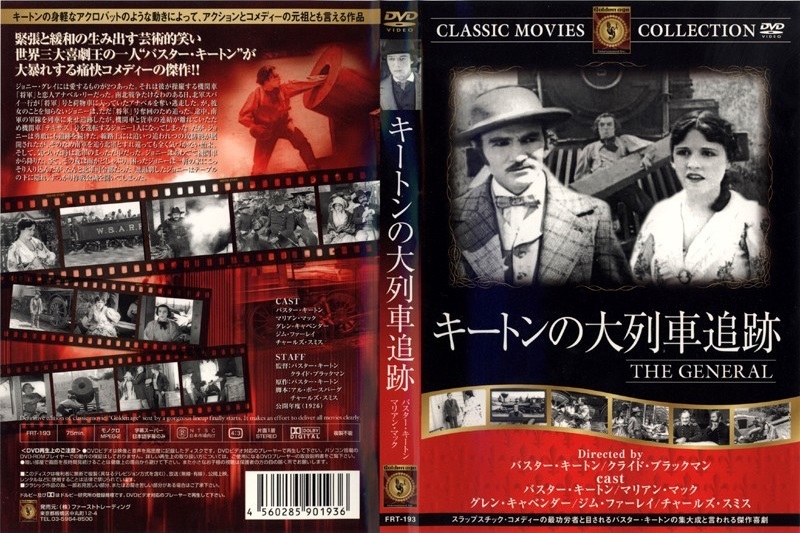
|
If you are in Japan and if you are willing to purchase some of these videos and mail them to me,
I would pay you your costs as well as an honorarium.
If that prospect interests you, please write to me. Thanks!
|
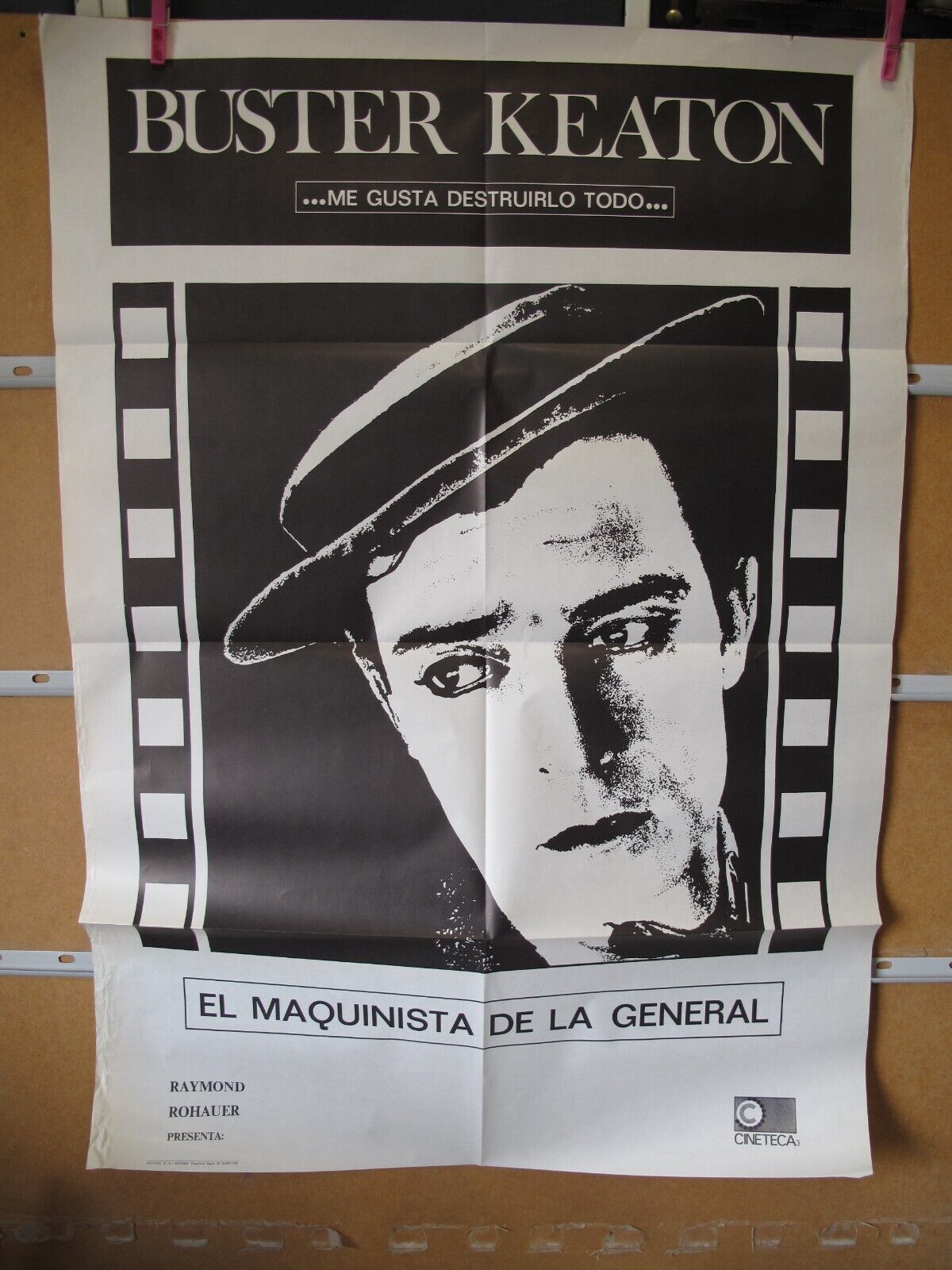 Found this on Spanish eBay, but had no idea what it was. The legend atop, “Me gusta destruirlo todo,” is not in keeping with Buster at all. Well, I just learned what this was! It was part of the 1972 Busterfest in Madrid! This was in June, when The General was still full-aperture silent. A few months later, that full-aperture edition would be replaced, as we shall learn right below. |
Rohauer’s 1972 Touring Edition |
|
Ray’s Festival prints were probably all reasonably complete and accurate.
Eventually, Ray ordered an edition of The General with Lee Erwin’s organ soundtrack.
This could only have been printed from the dupe negative of the November 1926 preview print.
Why do I say that?
First, because that’s what Richard J. Anobile used for his Rohauer-authorized photonovel in 1975.
Second, because that’s what Reel Images copied for its 16mm edition,
and there would have been no other place to access the 1926 preview print except through Rohauer,
without his permission, of course.
Third, because Rohauer was so terribly paranoid about letting his 16mm print out of his sight
when he played it in Buffalo, going so far as to carry it to the booth himself and never to take his eyes off of the reels,
and then carry the print out of the booth again at the end of the show.
He was paranoid not only because he was born paranoid; he was paranoid for good reason!
That’s why I conclude that this could only have been from that dupe neg that Rohauer ordered in January 1960
(without the Academy’s permission).
|
|
This edition was optically reduced from full-aperture silent (.723"×.980")
to the
|
|
The Kino
|
|
I hate to say it, but Lee Erwin’s score for this movie does nothing for me.
It’s just a couple of random themes,
principally a disguised staccato variation on The Teddy Bear’s Picnic repeated endlessly.
The score does not match the action or the mood or anything else.
It doesn’t enliven the film, but takes away from it
(sucks the life out of it would be more accurate).
The organ sound is distinctly thin, and so I was surprised to discover that it was played on a
Wurlitzer,
which should have
a rich, overpowering sound.
(By the way, Robert Israel and Joe Hisaishi, in their scores for The General,
similarly quoted The Teddy Bear’s Picnic,
which I thought was silly and detracted from the movie.
The movie is majestic, strong, powerful, stunning, sublime, and dignified,
while The Teddy Bear’s Picnic
is just a dinky little song for babies.)
|
|
I was in Albuquerque from 1972 through 1978, and Ray Rohauer was not.
I never had a chance to see the 1972 edition, but I’m pretty sure I know what it was.
Richard J. Anobile’s photonovel was pulled from a Rohauer print,
and he surely did not access a nitrate.
He accessed a copy negative or a
|
An Unexplained Announcement
What in the bloody heckleandjeckle was this thingamaroo?
My best guess is that this was a twentieth-generation 16mm public-domain print
with a
Might anybody know whatever became of the
Bown and Virginia Adams collection?
|
Leopold Friedman’s Obituary |
|
Took me forever, but I found it.
It was in Daily Variety, Wednesday, 3 January 1979,
repeated in the weekly Variety, Wednesday, 10 January 1979::
|
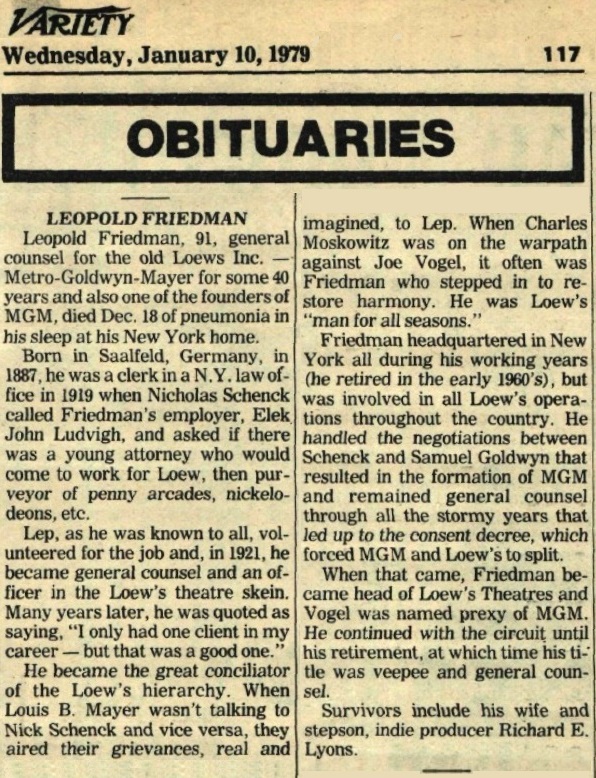
|
|
Once Friedman was gone, Ray Rohauer was the sole remaining owner of Buster Keaton Productions.
My guess is that once all the legal matters were settled over the next few years,
the domestic camera negative of The General migrated over to Rohauer’s possession.
|
Rohauer’s 1979 Release Edition |
|
When the Marion Mack tours had finished all their major playdates,
Ray hired Lee Erwin to
|
|
For this 1979 edition, Lee Erwin used his old themes, but he played them in an entirely different sequence.
You can hear his 1972 performance on the Kino K669
|
|
One would have thought that the series of Buster Keaton VHS tapes
that Atlas Film issued in Germany in the
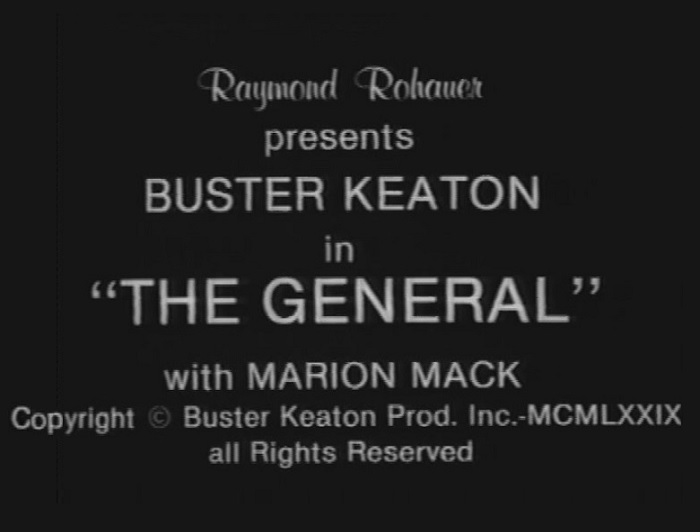 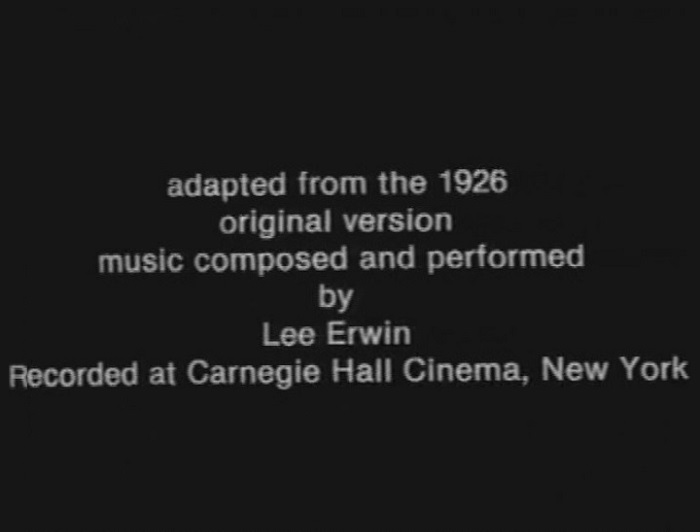
Above are the two opening main titles, which replace the original main title. A
14% crop was standard for telecines of the day
(and then TV sets at home in those days would crop a further 8% to 10% or thereabouts).
It was possible to defeat the default setting on the telecine and to scan the entire image,
but the techies who created this tape, or their boss, decided to abide by the appalling default.
Actually, they decided to make it even worse.
Only a handful of loonies like me ever complained, and we were unkindly shown the door.
The second title claims that this is “adapted from” the original.
As far as content is concerned, the only differences are the replacements of the main title and the deletion of the original copyright title.
That’s it.
And, of course, 22 frames deleted due to prior damage, and an appended music credit.
Maybe Ray added the occasional distinctive scratch that he and only he would recognize,
or maybe he deleted a frame somewhere to mark this edition as his,
probably during darkness between a
|
|
Ray put this new 1979 edition into his catalogue for cinemas to book,
and this is the edition that was at the Buffalo Film Seminars on 28 August 2001,
but I shut off the sound to allow
Jonathan Benjamin to accompany on electric piano.
Jonathan wasn’t local.
Phil Carli was away that week, and so he suggested that Jonathan take his place.
Jonathan flew in from somewhere to play the movie.
After the show, he complimented me on not cropping the film.
He said that all cinemas crop the film
(“they usually spread it out a bit,” was his euphemistic turn of phrase),
and so he was pleasantly surprised that night.
That made me feel good.
|
|
Below is the credit that appears after THE END:
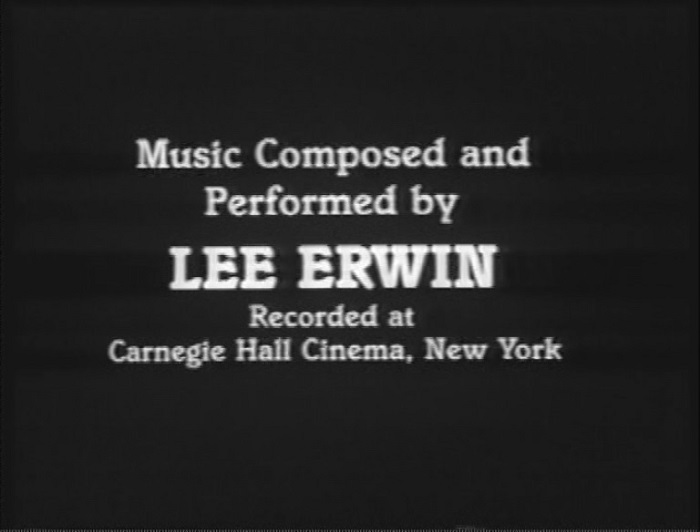
|
|
Though Ray made no significant changes to The General,
he was not so kind to Buster’s other movies.
The prints he prepared for general release were ruined,
and those butcheries must have begun in 1967 or 1968.
Ray altered the films and copyrighted his new versions.
For many of the films, he rewrote the titles, killing the humor,
and he changed way too much, deleting shots and making other editorial decisions that rendered some scenes senseless.
If at all possible, he would sweep up all known copies of the original versions
and lock them away so that nobody else would be able to distribute them.
It would be nice, for the historical record,
if future
|
|
The prints made for regular bookings included music tracks,
and, more often than not, Ray added those music tracks by lopping off the left side of the image.
Also, some of his prints were cheaply made (chromagenic?) and looked perfectly dreadful.
|
|
Oh no. Wait. Wait. No. I’m wrong. No no no no no no no no no no.
For some movies featuring Suton Face, the Rohauer Collection did not include music tracks,
but shipped out
|
|
My memory does not match the listings.
Normally, I trust documentation over my memory.
Not in this case.
I trust my memory far more than I trust this documentation.
| |
ANNOUNCED SCREENINGS: 1999: One Week, Seven Chances 2000: One Week 2001: The High Sign, Steamboat Bill, Jr. 2002: The Electric House, College 2003: The Goat, The Haunted House, The Balloonatic, The Frozen North, The Paleface |
MY MEMORY: 1999: The Boat (cropped), The Navigator (cropped) 2000: One Week (reduced) 2001: The High Sign (full), Seven Chances (full) 2002: The Electric House (full), College (full), So You Won’t Squawk 2003: The Goat (cropped), The Haunted House (cropped), The Balloonatic (reduced), The Frozen North (reduced), The Paleface (cropped) |
|
By the way, So You Won’t Squawk, a dumb quickie made in 1941, got the best laughs of all.
That was the crowd-pleaser, that’s the one that brought down the house, much more so than the silent flicks.
Oddly, I was laughing out loud, too, but I realized it was just a dumb quick cheapie that was not worth a second look.
Sorta depressing to see that it was the audience’s favorite, though.
The masking was manual and the Academy and MovieTone formats were both run with the same pair of lenses;
so in 2003 we ran all five shorts at .6796"×.825", which is why the ones that were optically reduced
had visible black bars at the top and bottom.
There was really no other viable way to do it.
|
|
It was always a bit odd when distributors from the 1960’s through the 2000’s
shipped out full-aperture prints to commercial cinemas,
because there were literally only maybe three or four commercial cinemas worldwide that could handle that format.
(I know of the Sheraton Opera House in Telluride, CO,
and the Magic Colonial in Vancouver, BC.
Nowadays there might be as many as a dozen.
|
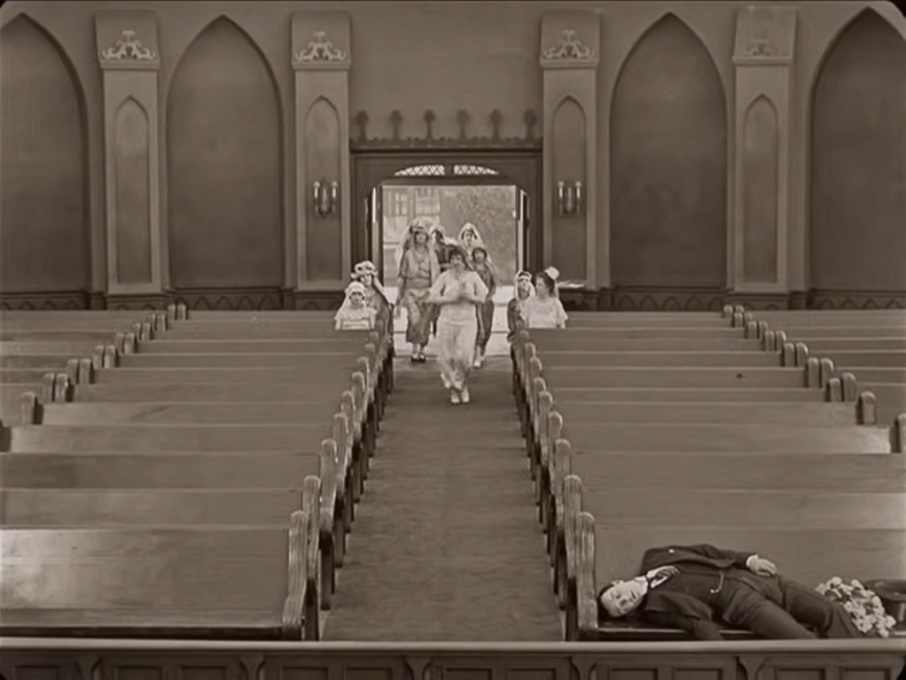 Original |
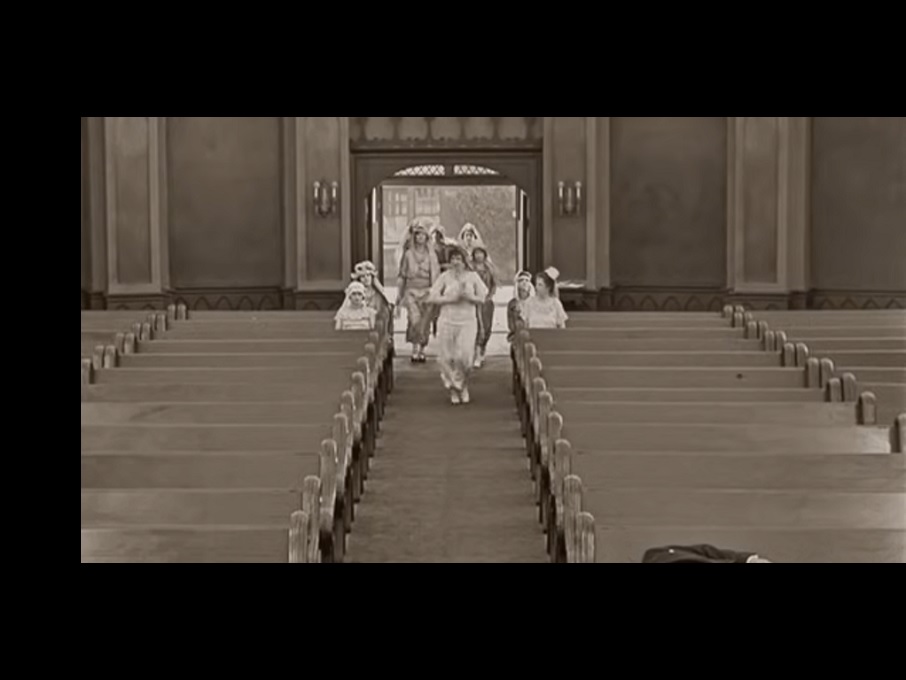 .446"×.825" widescreen crop |
Why is it that most people cannot discern any difference between these two presentations?
|
|
Television Reveals
|
|
Remember the final preview print?
Buster showed it at the Alex in Glendale on Friday, 12 November 1926,
and then stored it in his secret bunker.
James Mason excavated it at the end of 1955 and donated it to the Academy of Motion Picture Arts and Sciences in January 1956.
Rohauer, by crafting a business partnership with Buster, illegally using the firm name “Buster Keaton Productions,”
borrowed the Academy’s print at the beginning of 1958, and duped it.
His dupe served as the basis for the European/Japanese reissues of 1962 through 1970,
as well as of his own 35mm and 16mm festival prints of 1963 and 1972.
Somebody duped his 16mm dupe and issued it through Reel Images on 16mm and later through Video Yesteryear on VHS.
Remember all that?
|
|
Well, that very 35mm nitrate preview print ended up on television!
|
|
To get that final preview print shown on television required that Raymond Rohauer and Kevin Brownlow work together.
Nobody in the world could have predicted that the two would ever coöperate — least of all Ray and Kevin.
Raymond Rohauer and Kevin Brownlow had never been buddies.
Far from it.
Ray was underhanded, and in his paranoia, he suspected that Kevin was a rival.
Kevin diplomatically described Ray as “charmless.”
After decades of enmity, they found themselves in a quandary.
Each needed the other, desperately, to rescue Chaplin outtakes that had been presumed destroyed.
By a stroke of good fortune, Kevin’s business partner, David Gill,
was able to get along with both the combatants and brokered deals.
He kept Kevin and Ray away from one another and managed to broker deals.
That is how Kevin found himself in the unusual and sometimes uncomfortable position
of partnering with Ray for a series of film programs, at the cinema and on British television.
|
|
When Kevin needed to show The General on Thames Television in Britain,
Ray came to the rescue with a gorgeous nitrate print in almost immaculate condition.
Unlike the release prints presented at deluxe downtown cinemas in 1926 and 1927,
this print was not tinted, but was straight black and white.
Unlike release prints, this print had each shot physically spliced together.
Kevin and David recognized that this must have been a preview print.
It was.
This was the actual nitrate print that had been previewed at the Alex in Glendale on 12 November 1926.
|
|
The technicians at Thames Television 4 must have been limited in their choices.
They were unable to transfer the entire image.
Instead, they transferred only about .600"×.800", but recentered it to lop off the left and right equally.
They also reframed most of the film to reveal more of the bottom of the image and less of the top.
Unless one compares each image with an authentic copy, it would be impossible to tell that anything is amiss.
|
|
As the antique nitrate print ran through the telecine,
the image bounced as each cement splice entered the film gate,
and, a split second later, it bounced again as the splice rounded the intermittent wheel.
(Didn’t bother me at all, because, hey, it’s the preview print,
and that’s how the preview print behaved when it was shown to preview audiences;
but it bothered an old acquaintance so much that he couldn’t watch the video.)
This unusual print can only have been the very print that was projected at the Alex in Glendale
and perhaps also in San José.
This Thames Television edition was soon afterwards issued on home video,
and it did not include the “Copyright by Joseph M. Schenck” credit.
That credit was not included in the preview print, but it would be added in time for the release.
|
|
This new transfer of the old nitrate
was broadcast on Thames Television on 7 October 1987, with a lush orchestral score compiled, composed,
and conducted by
Carl Davis,
and it was easily the finest score ever recorded for the film,
and easily one of the finest scores composed for any film.
It is easily one of the finest accompaniments I have heard for any film, silent or sound.
It matches not just the action, not just the theme, not just the visual compositions, not just the pacing and rhythm,
but it also matches the flavor and texture of the story, and it blends the themes,
sometimes playing two themes, one over another, and makes the two themes sound exactly like a single theme.
The very opening,
|
|
The one time I met Eleanor (Buster’s widow), I remember her speaking, in awe,
about how thunderstruck she had been when she first heard Carl Davis’s orchestral accompaniment.
I could be confabulating, but I seem to remember her saying that it gave her goosebumps.
There are other fine scores, yes (Bill Perry, Gaylord Carter, Joe Hisaishi, and others),
but once you hear Carl Davis’s score, you will be spoiled.
If you are a film composer, you will be intimidated.
|
|
A repeat broadcast, this time on Film 4 Grandad’s Theatre, Buster Keaton - The General (1926) - With Original Music Score, uploaded on May 7, 2016 https://youtu.be/NxM2F4buF3Y |
|
Linux Pronto, Come vinsi la guerra (The General) - Buster Keaton (1926) uploaded on Jul 17, 2022 https://youtu.be/IUwvGE8BHlI As broadcast on RAI DUE in Italy, though when I do not know. The voiceover translation irritated me until I heard “egli” as opposed to the modern “lui,” and that’s when I forgave it, totally, completely, absolutely. |
|
This television edition of the movie was a revelation.
It was vastly superior to anything that anyone had seen before,
and two years later it was issued on VHS in the US.
That was on 8 November 1989 through HBO, though the only date printed on the cassette was 1987.
It seems to have been sometime in July 1990 that it was issued on laserdisc through Image Entertainment.
Lastly, it was issued in the UK from Thames Video sometime in 1991.
This was the most desirable edition of the movie, but not too many people knew about it.
The problem was the price.
At a time when the VHS market had settled on $18.95 as the going price for pretty much any tape,
HBO’s suggested retail price was a whopping $39.95.
At that price, few shops even bothered to stock it,
preferring to purchase instead the worthless |
|
Later, Ray granted Kevin access to the original domestic camera negative (OCN),
but not out of the goodness of his heart.
He handed it to Kevin only because he knew that Kevin would not be able to resist raising funds
and finding a lab to make a proper preservation copy.
That saved Ray from the trouble and expense.
The advantage for all of us is that Carl Davis’s score
has since been synchronized to editions derived directly from the original negative,
and the results are glorious.
|
|
If you wish to hunt for a video of this version, here is what you need to look for.
First came the US, with an NTSC conversion that was issued on VHS from
HBO’s “Legendary Silents” label, 0282, with a 1987 copyright,
but first issued on 8 November 1989:
|
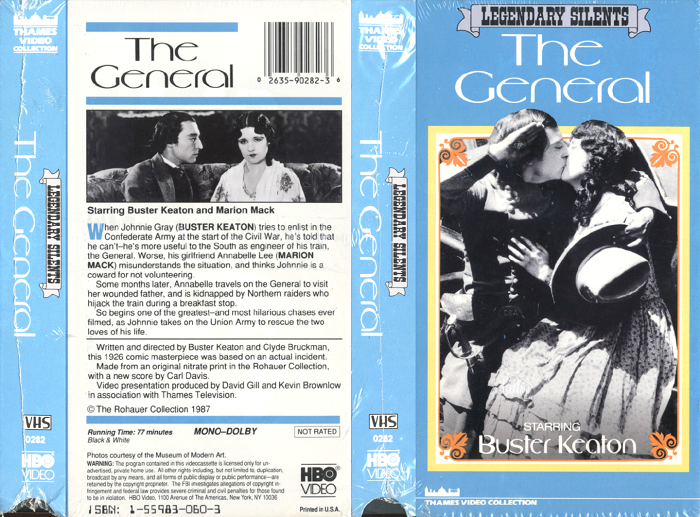
|
|
Next came this same NTSC conversion but now on laserdisc from Image Entertainment, ID6862HB.
Program content copyright 1987 by The Rohauer Collection.
Artwork and Summary copyright 1989 by Home Box Office, Inc.
Package/Design copyright 1989 by Image Entertainment, Inc.
This was issued in or around July 1989.
|
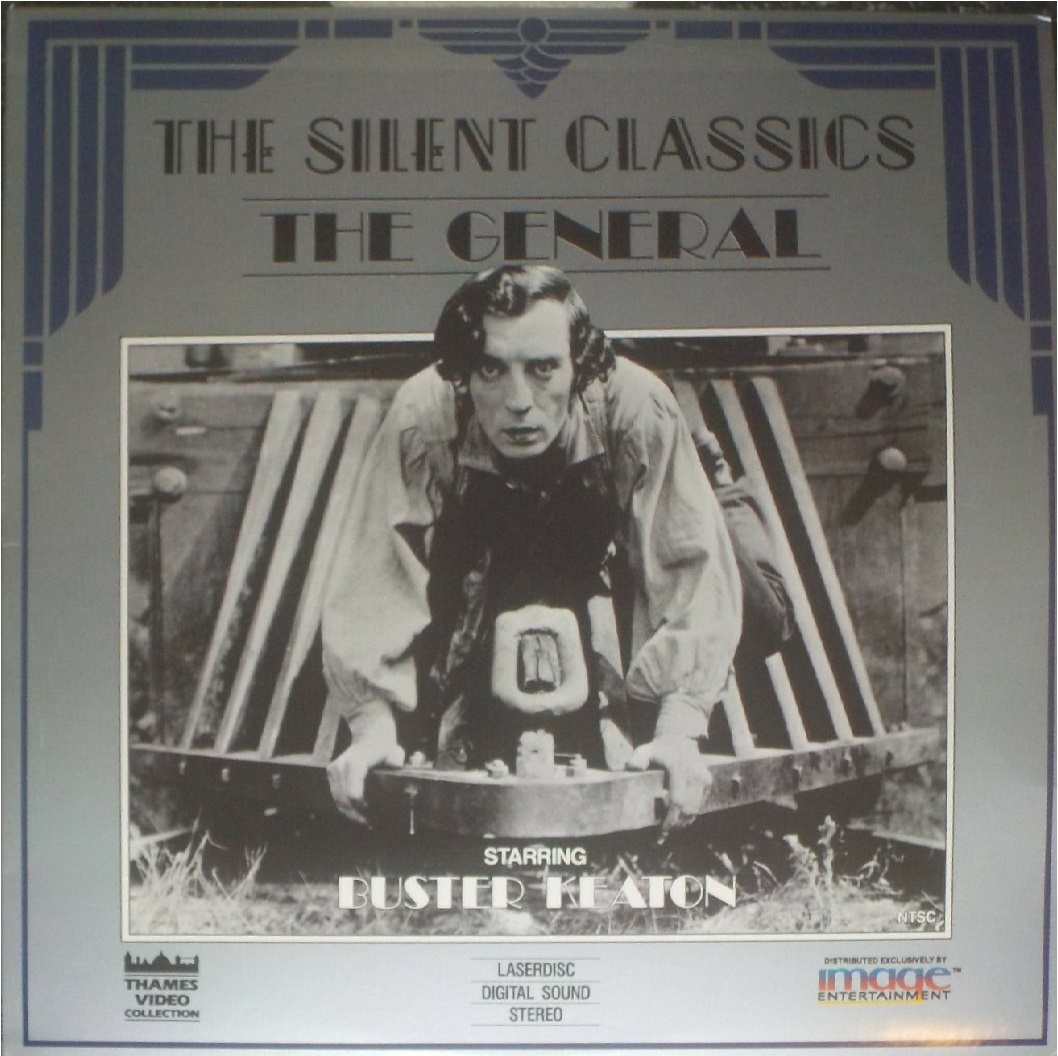
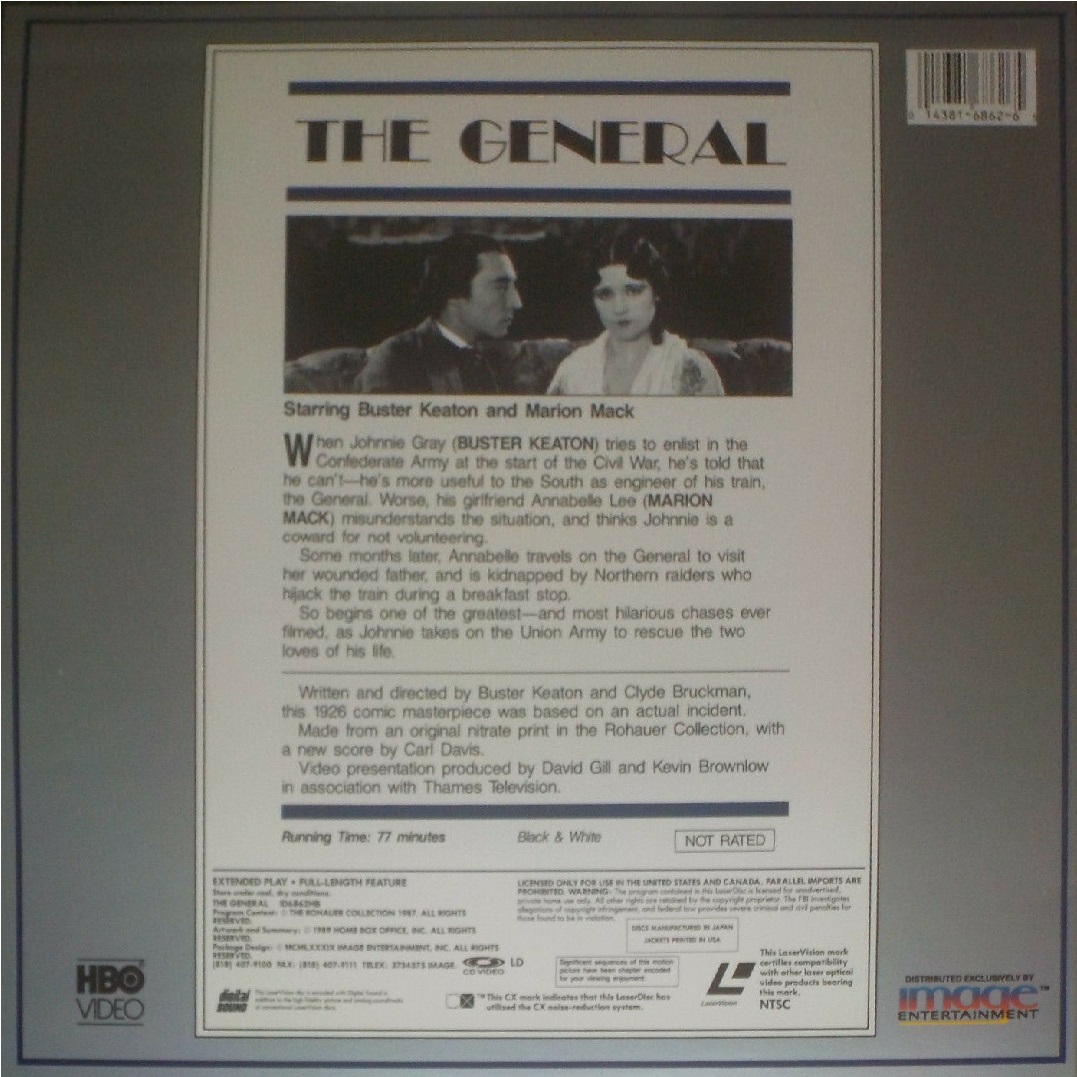
|
|
Last was the Thames Television International/Video Collection International, Ltd., in Hertfordshire,
on PAL-system VHS, product number TV 8129, which was issued sometime in 1991.
|
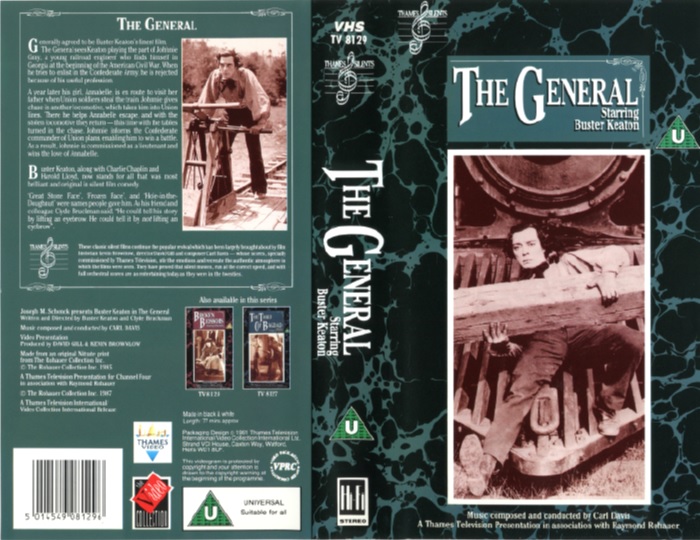
|
|
It was 77 minutes rather than the expected 79, not because of cuts,
but because it was transferred at the PAL speed of 25fps, and, further,
beginning with the theft of the train and for the next few scenes,
the speed was stepped up to 26fps.
Why? They thought it looked better that way.
Well, those few scenes, yeah, I’ll concede, they look okay when sped up.
I personally don’t think they look any better, but they don’t look worse, either.
|
|
This little note will bore you. You can skip it.
Something just occurs to me.
When I first saw this video edition, initially on VHS,
I was a bit surprised to see grease-pencil cue dots at the ends of reels 7 and 8.
A 1,000' reel, if full to the brim, lasts about 11 minutes at 90'/min.
Rare is the reel that is filled to the brim.
Beginning in 1930, MGM instructed the lab to place cue dots onto its film towards the end of each reel.
8⅓ seconds before the reel runs out, there is a
cue dot, visible on screen, in the upper right corner,
and it lasts for four frames (⅙ of a second).
The projectionist turns on the motor of the second projector upon seeing that.
Then, 7⅓ seconds later, there is a second cue dot,
telling the projectionist to kill the old projector and go live with the new projector.
Prior to the invention of cue dots, there were three other methods.
Maybe more, but I only know of three.
Originally, each reel ended with a title shown on screen: END OF PART ONE, or END OF PART TWO, or END OF PART SEVEN, or whatever.
The following reel opened with a title shown on screen: PART TWO, PART THREE, PART EIGHT, or whatever.
Those were the projectionist’s cues, and so now you know why posters for movies of that vintage
announced things such as “A COMEDY IN TWO PARTS” or “A DRAMA IN SEVEN PARTS” or whatever.
Apparently, some cinemas got the (not so) bright idea to punch holes into the film
and to use those
In 1924, Metro pioneered a new method.
Oh. No. It wasn’t Metro.
I think it was First National that pioneered this method.
Reel endings were placed in the middles of titles.
So, if a character says, for instance, “I wish to climb that mountain tomorrow,”
that title might be placed right at the end of a reel, and it will be held on for an extra long time.
The projectionist receives a cue sheet that tells him (usually him) that
“I wish to climb that mountain tomorrow” is the cue to switch to the next reel.
So, as soon as the projectionist sees that title on screen,
he hits the motor switch on the next projector, and as soon as he hears that the motor is up to speed,
he slides a metal plate to block the image from the old lens and to open the image emanating from the new projector.
The new reel begins with that exact same title: “I wish to climb that mountain tomorrow.”
An alternative method, perhaps used at Metro, certainly used at Paramount and Warner Bros.,
gives the projectionist different sorts of cues:
“When you see Susan trip over her shoe, start the motor of the next projector.
When she slams the door, change over.”
For safety, when Susan slams the door, the camera will linger for several more seconds.
The next reel will open either with another image of Susan slamming the door,
or it will open with a lingering shot of something else, with no action for several seconds.
That gives the projectionist some slop factor when switching from one projector to the next.
But for a preview print, what do you do?
The editing is not sufficiently refined that such seamless
So, when we watch this 1987 video, we are seeing exactly the same grease-pencil cue dots
that the preview audience saw at the Alex in Glendale that night in November 1926.
At least, we’re seeing them at the end of reel 7.
The cue dots on the earlier reels must have been wiped off,
and the beauty of grease-pencil cues is that they can be wiped off quite easily,
especially if they are on the base side of the film.
At the end of reel 8, the final reel, we see a curtain cue followed a few seconds later by a motor cue.
It seems that the final cue was never inserted, since the fade out was cue enough.
Since there was a curtain cue followed by a motor cue,
then I can only assume that, at the Alex,
the plan was to have the curtain close at the end of The General,
but that at the instant the curtains finished closing, they would open again
for the beginning of the evening’s regularly scheduled feature.
There was to have been no pause between the two movies.
Yet there was a pause, and the projectionist certainly stopped the show and brought up the house lights in response to the ovations.
Anyway, now that I’ve been examining the
Kino K669
I would be surprised if even one other person on the planet finds this interesting.
|
|
Those video editions, of course, were issued only after Ray died.
You see, Ray absolutely refused to allow most of the films in his catalogue to be sold to collectors,
but, in the days before affordable home video,
he did allow Richard J. Anobile to issue
a book of frame blowups from the full-aperture festival print of The General (Avon Books, 1975).
By some inexplicable quirk, every last frame blowup was out of focus.
It was great to have that book anyway, because it included the pieces missing from the Killiam version
that was available to collectors in 8mm and 16mm.
It also had a really nice interview with Marion Mack.
Right after Ray died, Virgin Video in the UK began releasing a series of “Rohauer Collection” VHS tapes.
Then Atlas six years later began issuing films from the Rohauer Collection on VHS.
So much changed, so rapidly, the moment Ray died.
|
|
The best article I have ever seen on Ray is by Ed Watz,
“Raymond Rohauer: The Man Who Would Be Keaton” (click to page 16),
Comique: The Classic Comedy Magazine vol. 1 no. 2 (Spring 2022).
Another worthwhile source is Bill Everson,
“Raymond Rohauer: King of the Film Freebooters,”
Grand Street no. 49 (Summer 1994), pp. 188–196.
Tempering those two accounts is Tim Lanza’s chapter 17,
“Raymond Rohauer and the Society of Cinema Arts (1948–1962),” in
David E. James and Adam Hyman, eds., Alternative Projections: Experimental Film in Los Ángeles, 1945–1980
(New Barnet, Herts.: John Libbey Publishing Ltd; Bloomington, IN: Indiana University Press, 2015; download and then click to page 129).
There was also a hit piece by John Baxter,
“The Silent Empire of Raymond Rohauer: The Ever-Expanding Power of the Cinema’s Strangest Mogul,”
The Sunday Times Magazine, 19 January 1975, pp. 32–33, 38–39.
Worth a read.
I found it fascinating and delectably juicy.
Then I read it a third time.
What John Baxter did to Ray Rohauer is exactly what Marion Meade would later do to Buster.
It was just a nasty smear, a hatchet job.
A third reading convinces me not to bother with anything that John Baxter has ever written.
There was another intriguing article in Tony Slide’s magazine, The Silent Picture,
which I have somewhere in my storage locker.
I think the article was called “The Silent Film Mafia.”
When I eventually dig it out from my distant storage locker, I’ll provide the full reference.
There’s yet more info in Kevin Brownlow’s The Search for Charlie Chaplin.
|
|
For years, I thought that Rohauer was worthy of a book.
He was peculiar.
He had a genuinely nice side, and a few people really liked him. Very few.
He was also a pathological liar.
He did not look like a con artist;
he looked like a nebbish.
Yet he was manipulative, egomaniacal,
|
|
Yet history will be kind to Raymond Rohauer.
Other restorationists, other distributors, other preservationists, other archivists
did important work, but they made sure to keep silent cinema in the realm of a handful of enthusiasts.
Had Buster’s films been rescued and preserved by a museum or an archive,
he would have remained an obscure figure, a name occasionally spotted in a footnote,
and his movies would have popped up at rare times in hidden screening rooms, accompanied by a tinkling piano,
shown to a group of a dozen or fewer history buffs.
Raymond Rohauer would have none of that.
Ray’s goal was to make Buster a superstar and to make his silent films major
|
|
Archivists despised Rohauer, and for good reason,
since he was finding ever-newer ways to swipe their collections from them,
but, in the final analysis, they benefited from his skullduggery.
Ray rescued lots of movies that would otherwise have vanished off the face of the earth.
Ray did more than rescue ancient movies; he publicized them effectively
and he found young and enthusiastic audiences for them.
No other distributor or exhibitor was doing that.
No other distributor or exhibitor knew how to do that.
To Ray, it came naturally, and he was literally the best thing that could have happened to Buster’s movies.
I can’t take that from him, even though he did butcher Buster’s films
and even though he was often (not always) horrid.
Though he did it only for his own self-aggrandizement and not out of the goodness of his heart (did he have a heart?),
he gave Buster something that no one else had ever given him.
Unlike Joe Schenck, unlike MGM, unlike any of the movie studios,
Ray Rohauer offered Buster full control of his films, and not only offered control, but insisted upon it.
That’s why I can’t hate the guy, though heaven only knows I wish I could.
Then I decided that, no, he’s not worthy of a book.
He’s worthy of the above articles.
They are enough. They’ll do. A book? No.
If there’s gonna be a book, I ain’t gonna write it.
Someone else can take on that thankless task.
|
|
Further to give the guy his due, though, it was Ray who got Buster’s movies shown in Venice in September 1963,
and that is how Italians discovered the filmmaker.
Buster was then invited to attend the Venice Film Festival in 1965,
since the movie he had made for Samuel Beckett,
Film, was on the program.
Buster was shoved unwilling onto the stage (reportedly by Rohauer),
and there was a sudden standing ovation.
There was a repeat later that evening, when he and Eleanor took their seats in the balcony.
Legend has it that it was the greatest and longest standing ovation in the history of the Venice Festival.
Buster was in tears.
“This is the first time I’ve been invited to a film festival, but I hope it won’t be the last.”
(I would like to think that Tinto was in the midst of that standing ovation,
since he was a prominent Venetian and regularly attended the festival,
but I don’t know and I can’t ask him.
I looked at the photographs but I don’t recognize anybody.
Tinto’s good friend
Lorenzo Codelli was certainly in that audience, though.
I wonder who else was there.
If you want to learn the background of Beckett’s film of Film, see
Notfilm, also available as a double-disc set on a
British
|